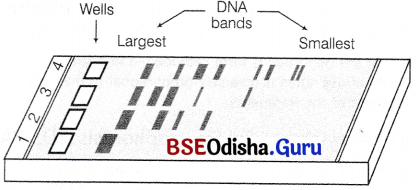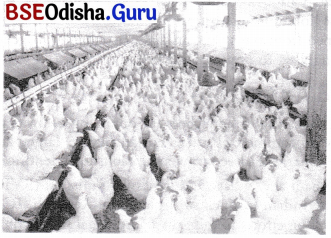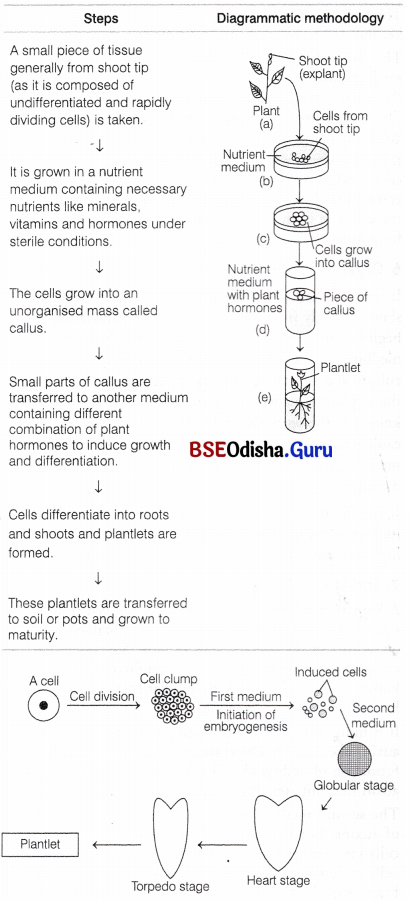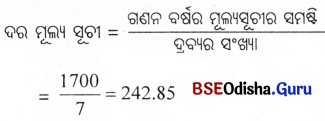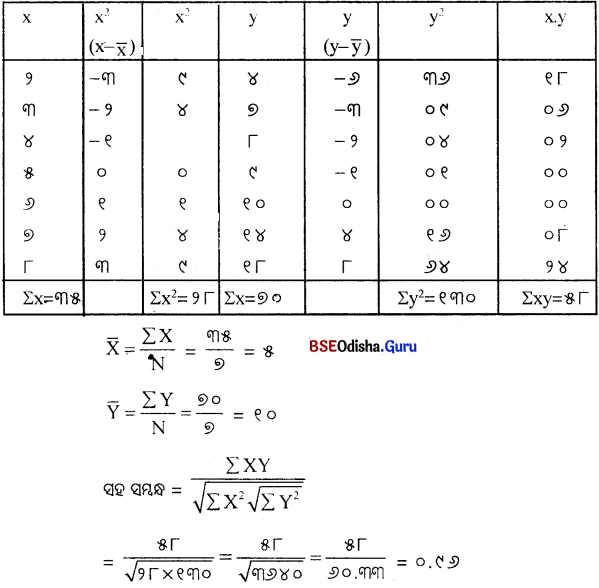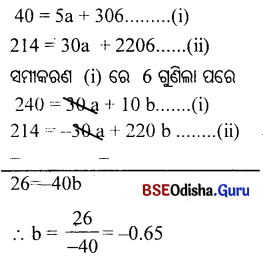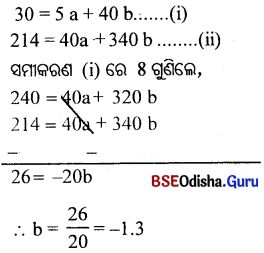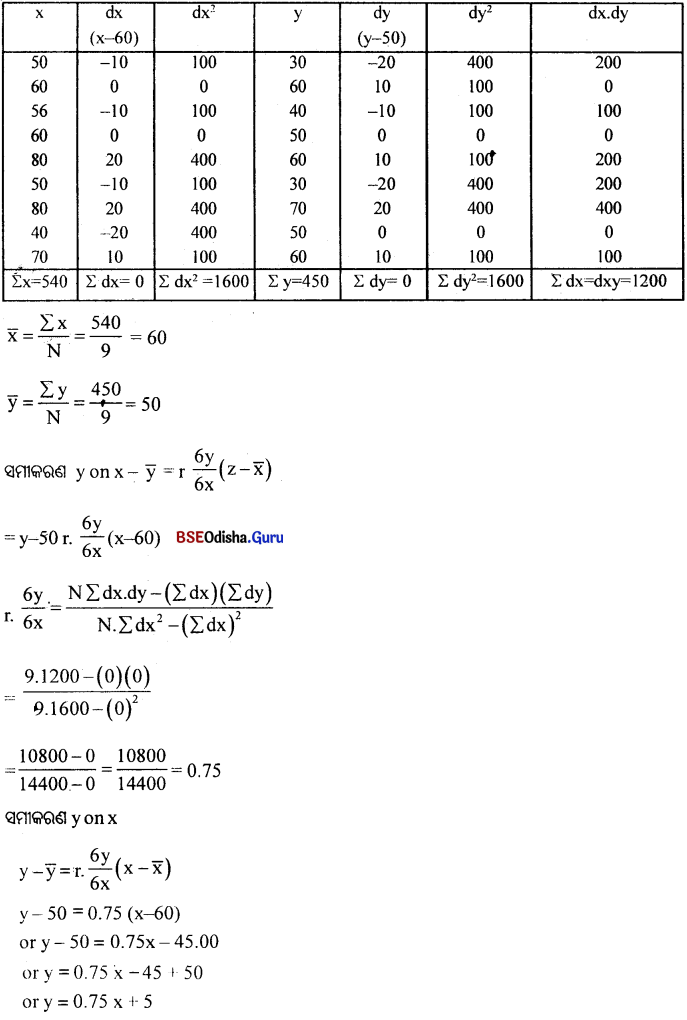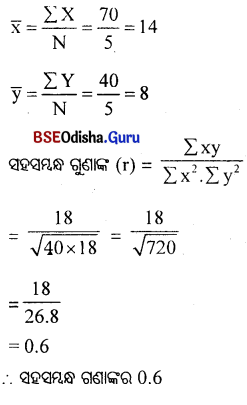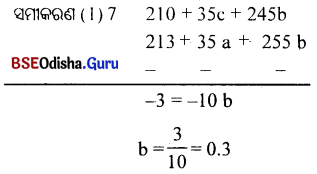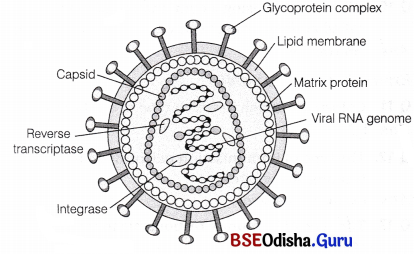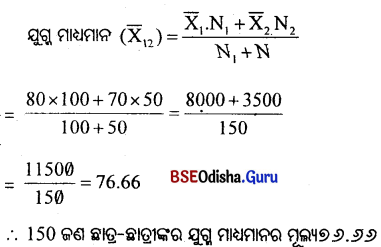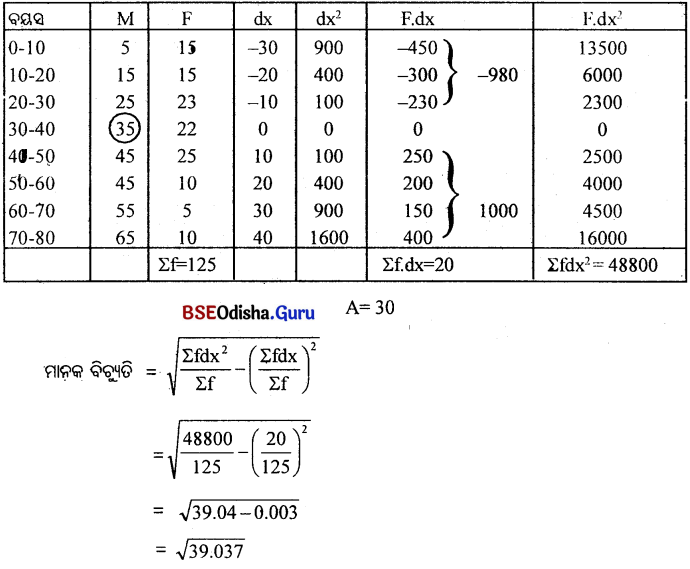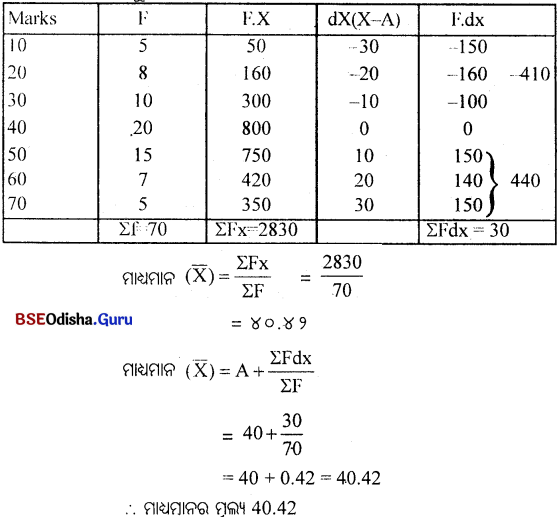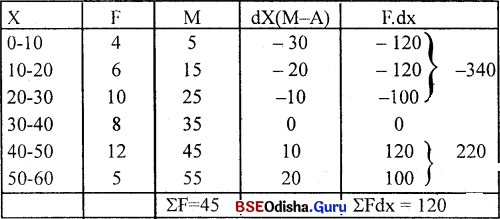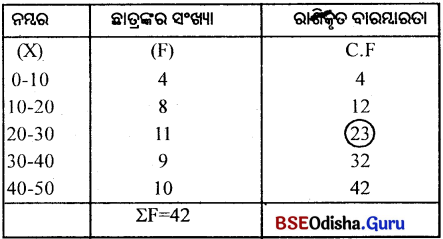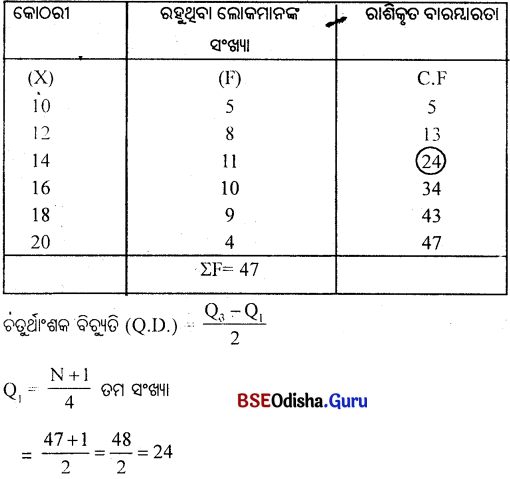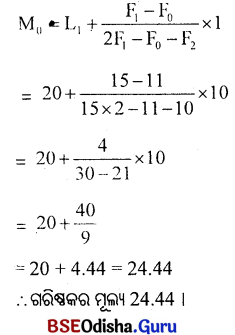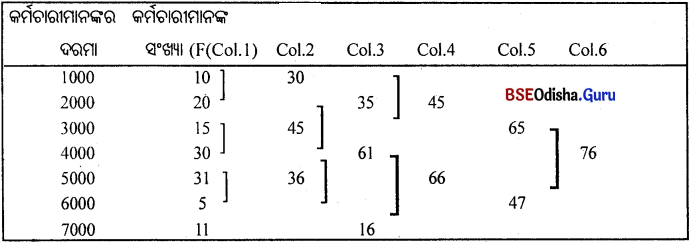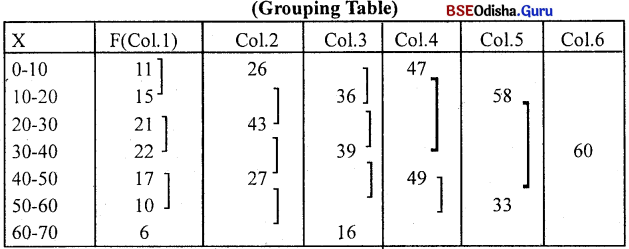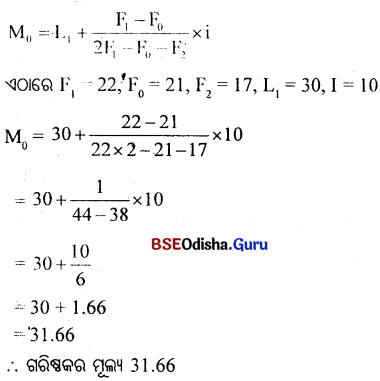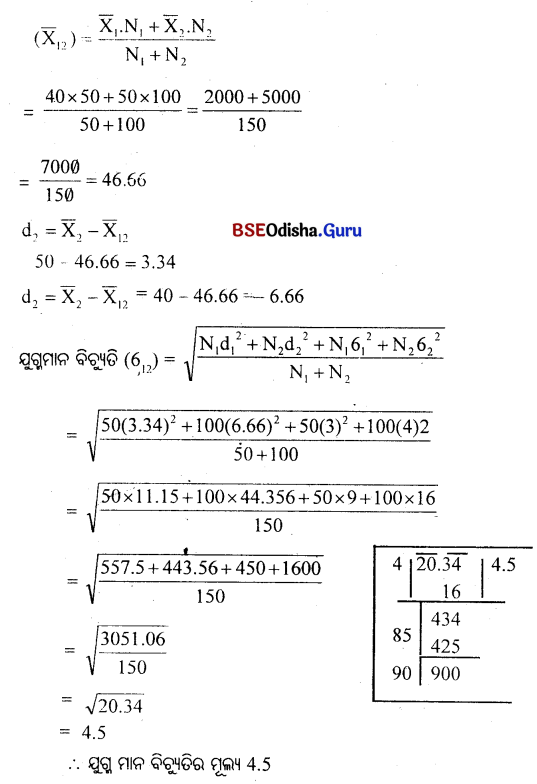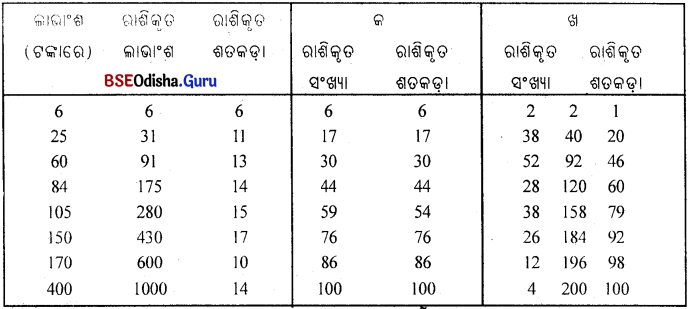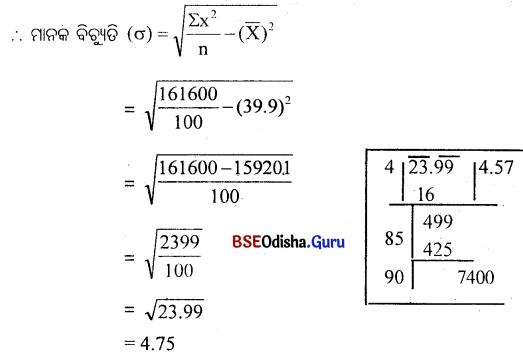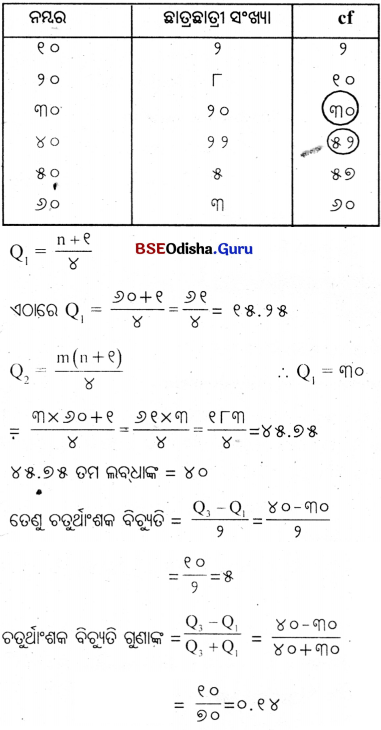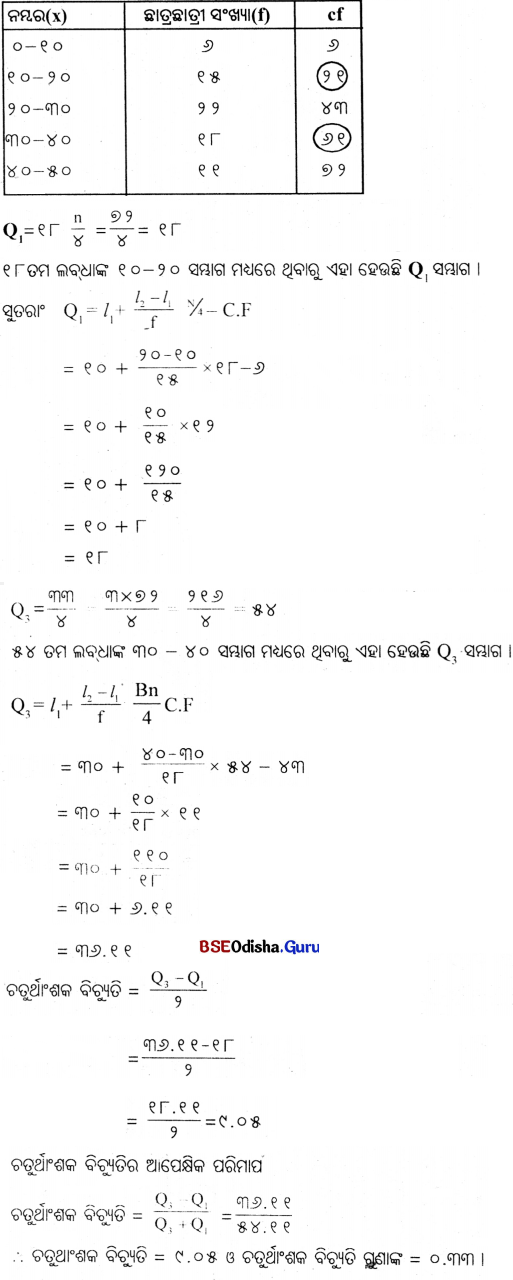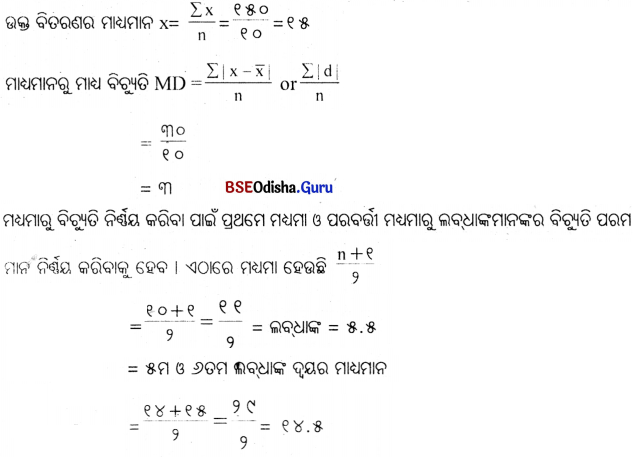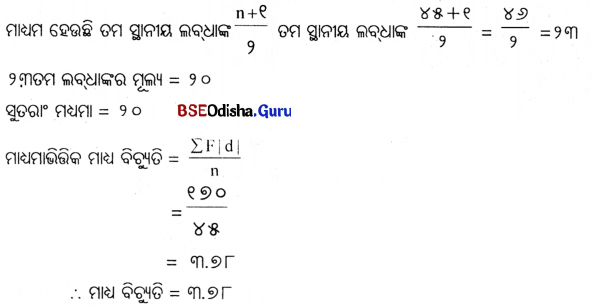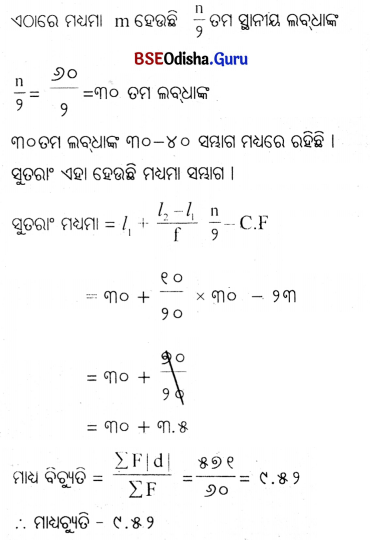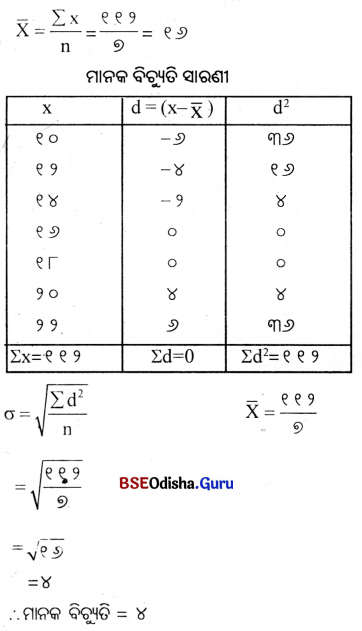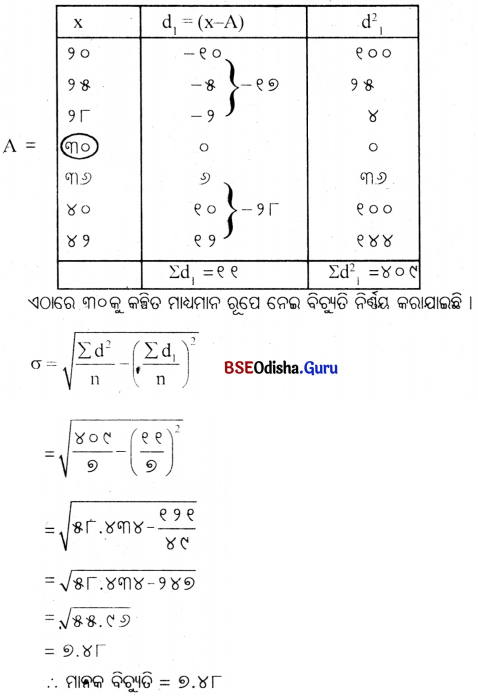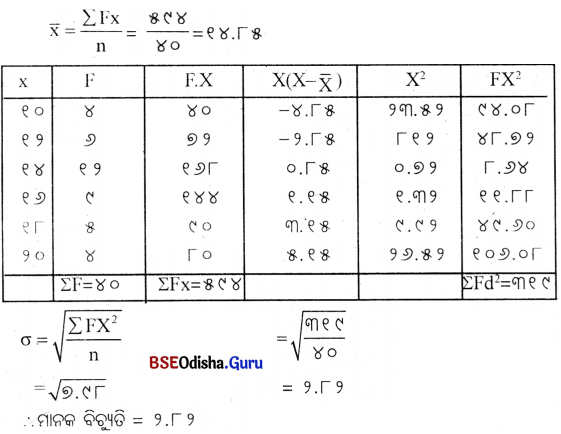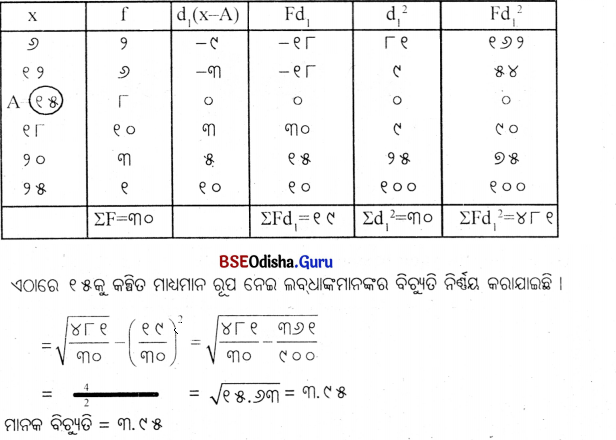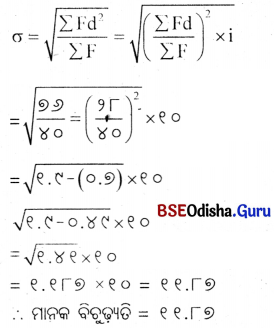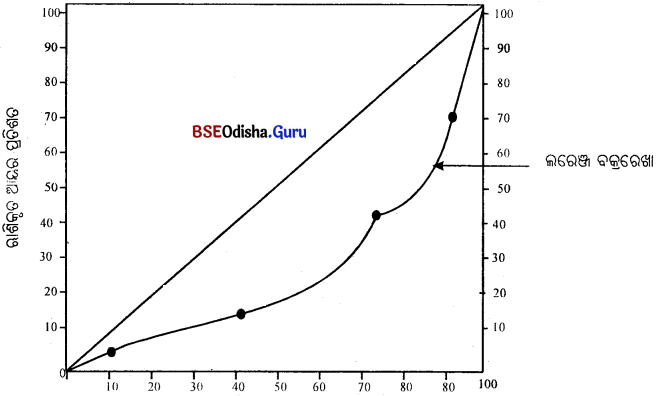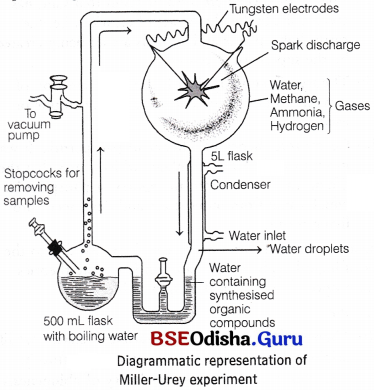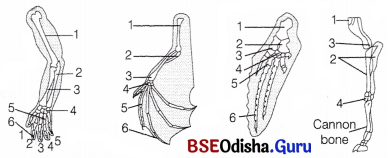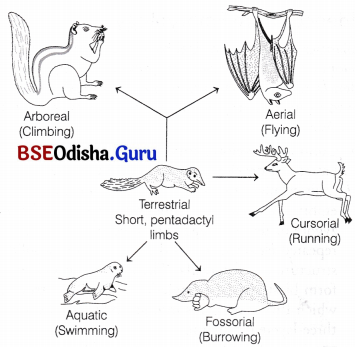Odisha State Board CHSE Odisha Class 11 Sociology Solutions Unit 4 ସାମାଜିକ ପ୍ରକ୍ରିୟା, ସ୍ତରୀକରଣ ଏବଂ ପରିବର୍ତ୍ତନ Questions and Answers.
CHSE Odisha 11th Class Sociology Unit 4 Question Answer ସମାଜ ସାମାଜିକ ପ୍ରକ୍ରିୟା, ସ୍ତରୀକରଣ ଏବଂ ପରିବର୍ତ୍ତନ
‘କ’ ବିଭାଗ
ଅତି ସଂକ୍ଷିପ୍ତ ପ୍ରଶ୍ନୋତ୍ତର
ସମ୍ଭାବ୍ୟ ବିକଳ୍ପ ମଧ୍ୟରୁ ଉତ୍ତର ଚୟନ କର :
Question ୧।
ନିମ୍ନଲିଖୂତ ମଧ୍ୟରୁ କେଉଁଠି ସମ୍ବନ୍ଧକାରୀ ସାମାଜିକ ପ୍ରକ୍ରିୟା ?
(i) ପ୍ରତିଯୋଗିତା
(iii) ସହଯୋଗିତା
(ii) ସଂଘର୍ଷ
(iv) ଏ ସମସ୍ତ
Answer:
(iii) ସହଯୋଗିତା
Question ୨।
ନିମ୍ନଲିଖୂତ ମଧ୍ୟରୁ କେଉଁଟି ବିସମ୍ବନ୍ଧକାରୀ ସାମାଜିକ ପ୍ରକ୍ରିୟା ? ?
(i) ସହଯୋଗିତ
(ii) ସଂଘର୍ଷ
(iii) ପ୍ରତିଯୋଗିତା
(iv) ଏ ସମସ୍ତ
Answer:
(iii) ପ୍ରତିଯୋଗିତା
Question ୩।
ନିମ୍ନଲିଖୂତ ମଧ୍ୟରୁ କେଉଁଟି ସାଧାରଣ ପ୍ରକ୍ରିୟା ନୁହେଁ ?
(i) ଅଭିଯୋଜନ
(ii) ସଂସ୍କୃତି
(iii) ପ୍ରତିଯୋଗିତା
(iv) କେଉଁଠି ନୁହେଁ
Answer:
(ii) ସଂସ୍କୃତି
Question ୪।
ନକରାତ୍ମକ ସାମାଜିକ ପ୍ରକ୍ରିୟା କାହାକୁ କୁହାଯାଏ ?
(i) ସମ୍ବନ୍ଧକାରୀ ପ୍ରକ୍ରିୟା
(ii) ବିସମ୍ବନ୍ଧିକାରୀ ପ୍ରକ୍ରିୟା
(iii) ସାମାଜିକ ପ୍ରକ୍ରିୟା
(iv) ଏ ସମସ୍ତ
Answer:
(ii) ବିସମ୍ବନ୍ଧିକାରୀ ପ୍ରକ୍ରିୟା
Question ୫।
ସକାରାତ୍ମକ ସାମାଜିକ ପ୍ରକ୍ରିୟା କାହାକୁ କୁହାଯାଏ ?
(i) ସମ୍ବନ୍ଧକାରୀ ପ୍ରକ୍ରିୟା
(ii) ବିସମ୍ବନ୍ଧକାରୀ
(iii) ସାମାଜିକ ପ୍ରକ୍ରିୟା
(iv) ଏ ସମସ୍ତ
Answer:
(i) ସମ୍ବନ୍ଧକାରୀ ପ୍ରକ୍ରିୟା
![]()
Question ୬।
ଏକ ଲକ୍ଷ ହାସଲ କରିବା ନିମିତ୍ତ ବ୍ୟକ୍ତିମାନେ ଭିନ୍ନ ଭିନ୍ନ କାର୍ଯ୍ୟ କରି ପରସ୍ପରକୁ ସହଯୋଗ କଲେ କାହାକୁ କ’ଣ କୁହାଯାଏ?
(i) ପ୍ରତ୍ୟକ୍ଷ ସହଯୋଗିତା
(ii) ପରୋକ୍ଷ ସହଯୋଗିତା
(iii) ପ୍ରତ୍ୟକ୍ଷ ସହଯୋଗିତା
(iv) ଏ ସମସ୍ତ
Answer:
(ii) ପରୋକ୍ଷ ସହଯୋଗିତ
Question ୭।
ବ୍ୟକ୍ତିମାନେ ପରସ୍ପରକୁ ପ୍ରତ୍ୟକ୍ଷ ଭାବରେ ବା ସିଧାସଳଖ ଭାବରେ ସହଯୋଗ କଲେ ତାହାକୁ କ’ଣ କୁହାଯାଏ ?
(i) ପ୍ରତ୍ୟକ୍ଷ ସହଯୋଗିତା
(ii) ପରୋକ୍ଷ ସହଯୋଗିତା
(iii) ସାମୁହିକ ସହଯୋଗିତା
(iv) ଏ ସମସ୍ତ
Answer:
(i) ପ୍ରତ୍ୟକ୍ଷ ସହଯୋଗିତା
Question ୮।
କୌଣସି ଏକ ପରିସ୍ଥିତିରେ ଦୁଇ ଜଣ ପରସ୍ପରକୁ ସହଯୋଗ ତୃତୀୟ ଜଣକୁ ମୁକାବିଲା କରନ୍ତି। ସେତେବେଳେ ଏହି ସହଯୋଗିତାକୁ କ’ଣ କୁହାଯାଏ ?
(i) ପ୍ରାଥମିକ
(ii) ଗୋଟିଏ
(iii) ଆଂଶିକ
(iv) ଏ ସମସ୍ତ
Answer:
(iii) ଆଂଶିକ
Question ୯।
ଶ୍ରମ ବିଭାଜନ ଓ କାର୍ଯ୍ୟର ବିଶେଷୀକରଣ ନୀତି ଉପରେ ପ୍ରତିଷ୍ଠିତ ସହଯୋଗିତାକୁ କ’ଣ କୁହାଯାଏ ?
(i) ପ୍ରାଥମିକ ସହଯୋଗିତା
(ii) ଗୌଣ ସହଯୋଗିତା
(iii) ଅଂଶିକ ସହଯୋଗିତା
(iv) ଏ ସମସ୍ତ
Answer:
(ii) ଗୌଣ ସହଯୋଗିତା
Question ୧୦।
ସମାଜର କେତେ ପ୍ରକାରର ସାମାଜିକ ପ୍ରକ୍ରିୟା ଦେଖା ଦେଇଥାଏ ?
(i) ଗୋଟିଏ
(ii) ଦୁଇଟି
(iii) ତିନୋଟି
(iv) ଅନେକ
Answer:
(iv) ଅନେକ
Question ୧୧।
କେଉଁଟି ସାମାଜିକ ଆନ୍ତଃ-କ୍ରିୟାର ଏକ ବିସମ୍ବନ୍ଧକାରୀ ପ୍ରକ୍ରିୟା ଅଟେ ?
(i) ସହଯୋଗିତା
(ii) ପ୍ରତିଯୋଗିତା
(iii) ଅଭିଯୋଜନା
(iv) ଏ ସମସ୍ତ
Answer:
(ii) ପ୍ରତିଯୋଗିତ
Question ୧୨।
କେଉଁଟି ସହଯୋଗିତାର ଏକ ଲକ୍ଷଣ ନୁହେଁ ?
(i) ସଚେତନ ପ୍ରକ୍ରିୟା
(ii) ଅବୈୟ ଶକ୍ତି ପ୍ରକ୍ରିୟା
(iii) ସାର୍ବଜନୀନ ପ୍ରକ୍ରିୟା
(iv) ଅନେକ
Answer:
(iv) ଏ ସମସ୍ତ
Question ୧୩।
କେଉଁଠି ସହଯୋଗିତର ଏକ ଲକ୍ଷଣ ନୁହେଁ ?
(i) ସମ୍ମତନ ପ୍ରକ୍ରିୟା
(ii) ଅବୈୟ ପ୍ରକ୍ରିୟା
(iii) ସାର୍ବଜନୀନ ପ୍ରକ୍ରିୟା
(iv) ଏ ସମସ୍ତ
Answer:
(ii) ଅବୈୟ ପ୍ରକ୍ରିୟା
Question ୧୪ ।
ଏକ ଲକ୍ଷ୍ୟ ପାଇଁ ଦୁଇ ବା ସେ ସୀମିତ ହୋଇଥିବା ପ୍ରଦାନ କରିଥିଲେ ? ଜଣେ ବ୍ୟକ୍ତିଙ୍କ ମଧ୍ୟରେ ହେଉଥିବା ଉଦ୍ୟମକୁ ପ୍ରତିଯୋଗିତା କୁହାଯାଏ ଏବଂ ଫଳରେ ସମସ୍ତେ ଏଥିରେ ଭାଗୀଦାର ହୋଇପାରନ୍ତି ନାହିଁ – ଏ ଉକ୍ତିଟି କିଏ
(i) ଇ. ଏସ୍ ବୋପାର୍ଡସଙ୍କ
(ii) ବିସାଞ୍ଜ ଏବଂ ବିସାଞ୍ଜ
(iii) ଏ. ଡଲୁ, ଗ୍ରୀନ
(iv) ଜି. ଏସ୍. ଘୂରେ
Answer:
(ii) ବିସାଞ୍ଜ ଏବଂ ବିସାଞ୍ଜ
![]()
Question ୧୫।
ଜାତି ଶବ୍ଦଟି କେଉଁ ସଂସ୍କୃତ ଶବ୍ଦରୁ ଅଛନ୍ତି ?
(i) ଜାନା
(ii) ଜ।ତି
(iii) ନାର।
(iv) ଜନ
Answer:
(iv) ଜନ
Question ୧୬।
କେଉଁ ଧର୍ମରେ ଜାତି ବ୍ୟବସ୍ଥା ଅତ୍ୟନ୍ତ କୋଠର ଅଟେ ?
(i) ବୌଦ୍ଧ
(ii) ହିନ୍ଦୁ
(iii) ଇସଲାମ
(iv) ଖ୍ରୀଷ୍ଟ
Answer:
(ii) ହିନ୍ଦୁ
Question ୧୭।
ଜାତିର ପରିବର୍ତ୍ତନ ପ୍ରକାର୍ଯ୍ୟ ଗୋଟିଏ କ’ଣ ?
(i) ନୀଚଜାତି ଅବସ୍ଥାରେ ପରିବର୍ତ୍ତନ
(ii) ସାମାଜିକ ପ୍ରକାର୍ଯ୍ୟରେ ପରିବର୍ତ୍ତନ
(iii) ନୌକୀକ ବୃତ୍ତିରେ ପରିବର୍ତ୍ତନ
(iv) ଏ ସମସ୍ତ
Answer:
(ii) ସାମାଜିକ ପ୍ରକାର୍ଯ୍ୟରେ ପରିବର୍ତ୍ତନ
Question ୧୮।
ଜାତିର ଇଂରାଜୀ ପ୍ରତିଶବ୍ଦ କ’ଣ ?
(i) କାଷ୍ଟମ
(ii) ପ୍ରଜାତି
(iii) ବଂଶ
(iv) ପ୍ରଜାତି
Answer:
(i) କାଷ୍ଟମ
Question ୧୯।
ଶ୍ରେଣୀକୁ କାହିକି ଉନ୍ମୁକ୍ତ କୁହାଯାଏ ?
(i) ବ୍ୟକ୍ତିର ବୃତ୍ତି ଉପରେ ପ୍ରତିଷ୍ଠିତ
(ii) ସାମାଜିକ ପ୍ରକାର୍ଯ୍ୟରେ ପରିବର୍ତ୍ତନ
(iii) ବ୍ୟକ୍ତିର ନିୟମ ଉପରେ ପ୍ରତିଷ୍ଠିତ
(iv) ଏ ସମସ୍ତ
Answer:
(i) ବ୍ୟକ୍ତିର ବୃତ୍ତି ଉପରେ ପ୍ରତିଷ୍ଠିତ
Question ୨୦।
ଜାତିକୁ କାହିଁକି ବୃଦ୍ଧି ସମୂହ କୁହାଯାଏ ?
(i) ଜନ୍ମ ଉପରେ ପ୍ରତିଷ୍ଠିତ
(ii) ଛାତି ଉପରେ ପ୍ରତିଷ୍ଠିତ
(iii) ବୃଷ୍ଟି ଉପରେ ପ୍ରତିଷ୍ଠିତ
(iv) ଏ ସମସ୍ତ
Answer:
(i) ଜନ୍ମ ଉପରେ ପ୍ରତିଷ୍ଠିତ
Question ୨୧।
ନିମ୍ନୋକ୍ତ ମଧ୍ୟରୁ ଜାତିର ଉପକାରିତା କେଉଁଟି ?
(i) ବ୍ୟକ୍ତିର ସାମାଜିକ ପ୍ରସ୍ତୁତି ନୀର୍ଦ୍ଧାରଣ
(ii) ବ୍ୟକ୍ତିର ଆର୍ଥିକ ସ୍ଥିତି ନିର୍ଦ୍ଧାରଣ
(iii) ଶକ୍ତିର ସାଂସ୍କୃତିକ ସ୍ଥିତି ନିର୍ଦ୍ଧାରଣ
(iv) କେଉଁଠି ନୁହେଁ
Answer:
(i) ବ୍ୟକ୍ତିର ସାମାଜିକ ପ୍ରସ୍ତୁତି ନୀର୍ଷାରଣ
Question ୨୨।
ନିମ୍ନୋକ୍ତ ମଧ୍ୟରୁ ଜାତିର ଅପକାର୍ଯ୍ୟ କେଉଁଟି ?
(i) ଅସ୍ପୃଶ୍ୟତାର ଉତ୍ସ
(ii) ଉଚ୍ଚନୀଚ କ୍ରମ
(iii) ସମାଜର କତା
(iv) ଏ ସମସ୍ତ
Answer:
(i) ଅସ୍ପୃଶ୍ୟତାର ଉତ୍ସ
Question ୨୩ ।
ଶ୍ରେଣୀ ଏକ
(i) ରାଜନୈତିକ ସମୂହ
(ii) ମୁକ୍ତ ସମୂହ
(iii) ଆବଦ୍ଧ ସମୂହ
(iv) ଏ ସମସ୍ତ
Answer:
(ii) ମୁକ୍ତ ସମୂହ
Question ୨୪।
ଶ୍ରେଣୀକୁ କିଏ ନିର୍ଦ୍ଧାରଣ କରିଥାଏ ?
(i) ଜନ୍ମ
(ii) ବଂଶ
(iii) ଜାତି
(iv) ଗୋତ୍ର
Answer:
(i) ଜନ୍ମ
![]()
Question ୨୫।
(i) ସାମାଜିକ ସମୂହ
(ii) ରାଜନୈତିକ ସମୂହ
(iii) ସାଂସ୍କୃତିକ ସମୂହ
(iv) କେଉଁଠି ନୁହେଁ
Answer:
(i) ସାମାଜିକ ସମୂହ
Question ୨୬।
ଯେତେବେଳେ ଗୋଟିଏ ବର୍ଗର ସଦସ୍ୟ କଡ଼ାକଡ଼ିଭାବେ ଜନ୍ମଗତ ହୋଇଯାଏ, ତାହାକୁ ଆମେ ଜାତି କହିଥାଉ – ଏହା କାହାର ମତ ?
(i) ସି. ଏଚ୍ କୁଲେ
(ii) ଏମ୍. ଏନ୍ ଶ୍ରୀନିବାସ
(iii) ମାକ୍ଆଇଭର
(iv) ସ୍କୁଲ
Answer:
(iii) ମାଇଭର
Question ୨୭।
ନିମ୍ନ ପ୍ରଦର କେଉଁ ଶବ୍ଦରୁ ଜାତି ସଂପ୍ରତୀୟଟି ଆସିଅଛି ?
(i) କାଷ୍ଟେ
(ii) କାଷ୍ଟ
(iii) ରେସ
(iv) ପ୍ରଜାତି
Answer:
(ii) କାଷ୍ଟ
Question ୨୮।
କେଉଁ ସମାଜବିଜ୍ଞାନୀ ଜାତିର ଲକ୍ଷଣ ପ୍ରଦାନ କରିଛନ୍ତି ?
(i) ସି.ଏଚ. କୁଲେ
(ii) ରସ୍
(iii) ଜି.ଏସ୍. ଘୂରେ
(iv) କେଉଁଠି ନୁହେଁ
Answer:
(iii) ଜି.ଏସ୍. ୟୂରେ
Question ୨୯।
ଏକ ପାରମ୍ପରିକ ଜୀବିକା ଥିବା ବଂଶାନୁକ୍ରମିକ ଆନ୍ତଃବିବାହୀ ଗୋଷ୍ଠୀ ଯାହାକି ଅନେକ ଉପଚେଷ୍ଟାରେ ବିଭାଜିତ ତାକୁ କ’ଣ କହନ୍ତି ?
(i) ଧର୍ମ
(ii) ଜାତି
(iii) ଗୋଷ୍ଠୀ
(iv) ପ୍ରଜାତି
Answer:
(ii) ଜାତି
Question ୩୦।
ଜଣଙ୍କର ଶ୍ରେଣୀ ପ୍ରସ୍ଥିତି ଉତ୍ପାଦନର ଉତ୍ପାଦକ ସହ ଥିବା ଏହାର ସଂପର୍କ ଦ୍ବାରା ନିର୍ଦ୍ଧାରିତ ହୋଇଥାଏ, ଶ୍ରେଣୀ ମୁଖ୍ୟତଃ ଅର୍ଧକୃତ ଧନ ସଂପଦ ବୃତ୍ତି ଏବଂ ଆୟ ଆଦି କେତେକ ଆର୍ଥିକ ମାନଦଣ୍ଡ ଦ୍ୱାରା ସ୍ଥିର ହୋଇଥାଏ । ଏହା କିଏ କହିଥିଲେ ?
(i) କାର୍ଲମାର୍କସ୍
(ii) ମାକାଇଭର
(iii) ଅଗବର୍ଣ୍ଣ
(iv) ଏ ସମସ୍ତ
Answer:
(i) କାର୍ଲମାର୍କସ୍
Question ୩୧।
ସାମାଜିକ ପରିବର୍ତ୍ତନ କହିଲେ
(i) ସାମାଜିକ ପରିବର୍ତ୍ତନକୁ ବୁଝାଏ
(iii) ବ୍ୟକ୍ତିର ପରିବର୍ତ୍ତନକୁ ବୁଝାଏ
(ii) ପଶୁ ସମାଜର ପରିବର୍ତ୍ତନ ବୁଝାଏ
(iv) କେଉଁଠି ନୁହେଁ
Answer:
(i) ସାମାଜିକ ପରିବର୍ତ୍ତନକୁ ବୁଝାଏ
Question ୩୨।
ସମାଜଶାସ୍ତ୍ର ଭାବରେ ଆମ୍ଭେମାନେ ସାମାଜିକ ସମ୍ପର୍କ ସହ ପ୍ରତ୍ୟକ୍ଷ ଭାବରେ ସମ୍ପୃକ୍ତ। ଏଣୁ ସାମାଜିକ ସମ୍ପର୍କର ପରିବର୍ତ୍ତନ କେବଳ ହିଁ ଆମ୍ଭେମାନେ ସାମାଜିକ ପରିବର୍ତ୍ତନ ବୋଲି କହିପାରିବା ଏହା କିଏ କହିଥୁଲେ ?
(i) ଜନ୍ମ ସନ
(ii) ମାକ୍ଆଇଭର ଏବଂ ପେଜ୍
(iii) ଡେଭିସ୍
(iv) ମୁରେ
Answer:
(ii) ମାଇଭର ଏବଂ ପେଜ
Question ୩୩।
ସାମାଜିକ ପରିବର୍ତ୍ତନ କେଉଁ କାରଣରୁ ହୋଇଥାଏ ?
(i) ଭୌତିକ କାରଣ
(ii) ପ୍ରାଦ୍ୟୋଗିକ କାରକ
(iii) ସାଂସ୍କୃତିକ କାରଣ
(iv) ଏ ସମସ୍ତ
Answer:
(iv) ଏ ସମସ୍ତ
Question ୩୪।
ଗୋଟିଏ ସମାଜର ସଂସ୍କୃତି ଯଥା–କଳା, ବିଜ୍ଞାନ, ଦର୍ଶନ ସାହିତ୍ୟର ଆଦର୍ଶ ମୂଲ୍ୟବୋଧ, ପ୍ରଥା ଆଦିରେ ଦେଖା ଦେଇଥିବା ପରିବର୍ତ୍ତନକୁ କ୍’ଣ କୁହାଯାଏ ?
(i) ସାଂସ୍କୃତିକ ପରିବର୍ତ୍ତ
(ii) ସାମାଜିକ ପରିବର୍ତ୍ତନ
(iii) ଜୈବିକ ପରିବର୍ତ୍ତନ
(iv) ଧାର୍ମିକ ପରିବର୍ତ୍ତନ
Answer:
(i) ସାଂସ୍କୃତିକ ପରିବର୍ତ୍ତନ
![]()
Question ୩୫।
ଜନସଂଖ୍ୟାର ଗଠନ ଯଥା: ସୁ-ପୁରୁଷ ଅନୁପାତରେ ପରିବର୍ତ୍ତନ ଯୋଗୁଁ ସୃଷ୍ଟି ପରିବର୍ତ୍ତନକୁ ପରିବର୍ତ୍ତନର କେଉଁ କାରକ କୁହାଯାଏ।
(i) ଜନସଂଖ୍ୟାତ୍ମକ କାରକ
(ii) ସାମାଜିକ ପରିବର୍ତ୍ତନ
(iii) ପ୍ରଦ୍ୟୋଗିକ କାରକ
(iv) ଏ ସମସ୍ତ
Answer:
(i) ଜନସଂଖ୍ୟାତ୍ମକ କାରକ
Question ୩୬।
ବିଭିନ୍ନ ଯନ୍ତ୍ରପାତିର ଉଦ୍ଭାବନ ଦ୍ବାରା ସମାଜରେ ସୃଷ୍ଟି ହୋଇଥିବା ପରିବର୍ତ୍ତନକୁ ସାମାଜିକ ପରିବର୍ତ୍ତନର କେଉଁ କାରକ କୁହାଯାଏ ?
(i) ସଂସ୍କୃତିକ କାରକ
(ii) ପ୍ରଦ୍ୟୋଗ କାରକ
(iii) ଜନସଂଖ୍ୟାତ୍ମକ କାରକ
(iv) ଏ ସମସ୍ତ
Answer:
(ii) ପ୍ରଦ୍ୟୋଗ କାରକ
Question ୩୭।
ସାମାଜିକ ପରିବର୍ତ୍ତନ କହିଲେ କେବଳ ସେହି ପରିବର୍ତ୍ତନକୁ ବୁଝାଏ ଯାହା ସାମାଜିକ ସଙ୍ଗଠନ ଓ ସଂରଚନା କ୍ଷେତ୍ରରେ ହିଁ ସଙ୍ଗଟିତ ହୋଇଥାଏ – ଏ ସଂଜ୍ଞାଟି କିଏ ପ୍ରଦାନ କରିଥିଲେ ?
(i) କେ. ଡେଭିସ୍
(ii) ମାନ୍ଆଇଭର
(iii) ଓଗବର୍ଣ୍ଣ
(iv) ଏ ସମସ୍ତ
Answer:
(i) କେ. ଡେଭିସ୍
Question ୩୮।
ସାଧାରଣତଃ ଜନସଂଖ୍ୟା ବୃଦ୍ଧି ଏବଂ ଜନସଂଖ୍ୟା ହ୍ରାସ ଏ ଦୁଇଗୋଟି ଜନସଂଖ୍ୟାତ୍ମକ କାରକ ଯୋଗୁଁ ସାମାଜିକ ପରିବର୍ତ୍ତନ ହୋଇଥାଏ – ଏ କଥା କିଏ କହିଥିଲେ ?
(i) କାର୍ଲମାର୍କସ୍
(ii) ମାଲଥସ୍
(iii) ଓଗବର୍ଷ
(iv) କେଉଁଠି ନୁହେଁ
Answer:
(ii) ମାଲଥମ୍
Question ୩୯।
କେଉଁଟି ସାମାଜିକ ପରିବର୍ତ୍ତନର ଏକ ସାଂସ୍କୃତିକ କାରକ ନୁହେଁ ?
(i) ସାଂସ୍କୃତିକ ସଂଘର୍ଷ
(ii) ଅନ୍ୟ ସଂସ୍କୃତିଗ୍ରହଣ
(iii) ଧାର୍ମକ ପ୍ରଭେଦତା
(iv) ଏ ସମସ୍ତ ଏ
Answer:
(iii) ଧାର୍ମକ ପ୍ରଭେଦତା
Question ୪୦।
ସାଂସ୍କୃତିକ ବିଳମ୍ବନ ତତ୍ତ୍ଵର ମୁଖ୍ୟ ପୁରୋଧା କିଏ ?
(i) ମାଲିନସ୍କ
(ii) ସମ୍ବନର
(iii) ଡବୁ ଏଫ ଓଗବର୍ଣ୍ଣ
(iv) ଏ ସମସ୍ତ
Answer:
(iii) ଡବୁ ଏଫ ଓଗବଣ୍ଡ
Question ୪୧।
ପ୍ରୋଦ୍ୟୋଗ ଆମ୍ଭମାନଙ୍କ ପରିବେଶକୁ ପରିବର୍ତ୍ତନ କରିବା ସହିତ ସମାନକୁ ମଧ୍ୟ ପରିବର୍ତ୍ତନ ଏହି ପରିବର୍ତ୍ତନ ଭୌତିକ ପରିବେଶରେ ଘଟିଥାଏ ଏବଂ ଏହା ପ୍ରଚଳିତ ସମାଜର ପ୍ରଥା ଏବଂ ସାମାଜିକ ଅନୁଷ୍ଠାନରେ ମଧ୍ୟ ପରିବର୍ତ୍ତନ ଘଟିଥାଏ। ଏ କଥା କିଏ କହିଥିଲେ।
(i) କୁଲେ
(ii) ମାଲଥସ
(iii) ଡବ୍ଲ ଏଫ ଓଗବର୍ଣ୍ଣ
(iv) ସ୍କୁଲ
Answer:
(iii) ଡବୁ ଏଫ ଓଗବର୍ଷ
ଗୋଟିଏ ଶବ୍ଦରେ ଉତ୍ତର ଦିଅ :
Question ୧।
ଯେଉଁ ପ୍ରକ୍ରିୟାରେ ଦୁଇ ବା ତେତାଽଧ୍ଵକ ବ୍ୟକ୍ତି ବା ସମୂହ ସେମାନଙ୍କ ଉଦ୍ୟମକୁ ଏକତ୍ର କରି କେତେକ ସାଧାରଣ ଲକ୍ଷ୍ୟ ପୂରଣ ନିମନ୍ତେ ଉଦ୍ୟମ କରିଥାନ୍ତି। ସେହି ପ୍ରକ୍ରିୟାକୁ କ’ଣ କୁହାଯାଏ ?
Answer:
ସହଯୋଗିତା
Question ୨।
ଯେତେବେଳେ ବ୍ୟକ୍ତି ବା ସମୂହଗୁଡ଼ିକ ପ୍ରତ୍ୟକ୍ଷ ଭାବରେ ପରସ୍ପରକୁ ସହଯୋଗ କରିଥାନ୍ତି ଏବଂ ଏକତ୍ର ମିଳିମିଶି କାର୍ଯ୍ୟ ସମ୍ପାଦନ କରିଥାନ୍ତି ସେତେବେଳେ ଏହାକୁ କ’ଣ କୁହାଯାଏ ?
Answer:
ପ୍ରତ୍ୟକ୍ଷ ସହଯୋଗିତା
Question ୩।
ଦୁଇ ବା ତତୋଽଧିକ ବ୍ୟକ୍ତି କେତେକ ପାରସ୍ପରିକ ଲକ୍ଷ୍ୟ ବା ଉଦ୍ଦେଶ୍ୟ ପୂରଣ ନିମିତ୍ତ ପରସ୍ପର ମଧ୍ୟରେ କରୁଥିବା ନିରବଚ୍ଛିନ ଉଦ୍ୟମକୁ କ’ଣ କୁହାଯାଏ ?
Answer:
ପ୍ରତିଯୋଗିତା
Question ୪।
ସମାଜର ଏକ ଉଚ୍ଚ ପ୍ରସ୍ତୁତି ଯଶ ଓ ଖ୍ୟାତି ପାଇଁ ଲୋକେ ପରସ୍ପର ମଧ୍ୟରେ କରୁଥିବା ପ୍ରତିଯୋଗିତା କ’ଣ ଅଟେ?
Answer:
ସାମାଜିକ ପ୍ରତିଯୋଗିତା
Question ୫।
ଅନ୍ୟର ଇଚ୍ଛାକୁ ବିରୋଧ କରିବା, ବାଧା ଦେବା କିମ୍ବା ଦମନ କରିବାର ସୁବିବେଚିତ ଚେଷ୍ଟାକୁ ସଂଘର୍ଷ କୁହାଯାଏ। ଏ ସଂଜ୍ଞାଟି କିଏ ପ୍ରଦାନ କରିଥିଲେ।
Answer:
ଏ. ଡବୁ ଗ୍ରୀନ୍
![]()
Question ୬।
ଯେତେବେଳେ କୌଣସି କାରଣରୁ ବ୍ୟକ୍ତି ବା ସମୂହଗୁଡ଼ିକ ସେମାନଙ୍କର ସଂଘର୍ଷ ଜନିତ ମନୋଭାବକୁ ପ୍ରକାଶ କରିନଥାନ୍ତି ସେତେବେଳେ ଏହା କେଉଁ ନାମରେ ପରିଚିତ ଅଟେ ?
Answer:
ଅଭିଯୋଜନ
Question ୭।
ସହଯୋଗିତା ଓ ସଂଘର୍ଷ ସାମାଜିକ ପ୍ରଭେଦୀକରଣ ଓ ସଂକଳନ ବିକାଶ। ପ୍ରତିରୋଧ ଓ କ୍ଷୟକୁ ମିଶାଇ ବ୍ୟକ୍ତି କିମ୍ବା ସମୂହଗୁଡ଼ିକ ମଧ୍ୟରେ ସାମାଜିକ ଆନ୍ତଃକ୍ରିୟାର ବିଭିନ୍ନ ରୂପକୁ ସାମାଜିକ ପ୍ରକ୍ରିୟା କୁହାଯାଏ?
Answer:
ମୋରିସ୍ ଗିନ୍ସବର୍ଗ
Question ୮।
ସମସ୍ୟାଗୁଡ଼ିକର ସମାଧାନ ଏବଂ ଲକ୍ଷ୍ୟ ପୂରଣ ପାଇଁ କରାଯାଇଥିବା ଉଦ୍ୟମ ଦ୍ଵାରା ବ୍ୟକ୍ତି ବା ସମୂହ ମଧ୍ୟରେ ସୃଷ୍ଟି ହେଉଥିବା ପାରସ୍ପରିକ ପ୍ରଭାବକୁ ସାମାଜିକ ଆନ୍ତଃକ୍ରିୟା କୁହାଯାଏ। ଏହି ସଂଜ୍ଞାଟି କିଏ ପ୍ରଦାନ କରିଥିଲେ?
Answer:
ଏ ଡବୁ ଗ୍ରୀନ୍
Question ୯।
ସମ୍ବନ୍ଧକାରୀ ସାମାଜିକ ପ୍ରକ୍ରିୟାର ଏକ ଉଦାହରଣ ଦିଅ ?
Answer:
ସହଯୋଗିତା
Question ୧୦।
ବିସମ୍ବନ୍ଧକାରୀ ସାମାଜିକ ପ୍ରକ୍ରିୟାର ଏକ ଉଦାହରଣ ଦିଅ।
Answer:
ପ୍ରତିଯୋଗିତା
Question ୧୧।
ଲାଟିନ୍ ଶବ୍ଦ ‘କୋ’ର ଅର୍ଥ କ’ଣ ?
Answer:
ଏକାଠି
Question ୧୨।
ଲାଟିନ୍ ଶବ୍ଦ କୋ-ଅପରେସନ୍ର ଅର୍ଥକ’ଣ ?
Answer:
ଏକାଠି କାର୍ଯ୍ୟ କରିବା
Question ୧୩।
ସହଯୋଗିତାର ଏକ ଗୁଣ ଦର୍ଶାଅ।
Answer:
ସାଧାରଣ ଲକ୍ଷ୍ୟ
Question ୧୪।
ସହଯୋଗିତାର ଏକ ପ୍ରକାର ଭେଦ ଦର୍ଶାଅ !
Answer:
ପ୍ରତ୍ୟକ୍ଷ ସହଯୋଗିତା
![]()
Question ୧୫।
ମାକାଇଭରଙ୍କ ଦ୍ବାରା ଆଲୋଚିତ ସହଯୋଗିତାର ଏକ ପ୍ରକାରଭେଦ ଦର୍ଶାଅ।
Answer:
ପରୋକ୍ଷ ସହଯୋଗିତା
Question ୧୬।
ଏ. ଡବ୍ଲ୍ୟୁ . ଗ୍ରୀନ୍ଙ୍କ ଦ୍ବାରା ପ୍ରଦତ୍ତ ସହଯୋଗିତାର ଏକ ପ୍ରକାରଭେଦ ଦର୍ଶାଅ।
Answer:
ପ୍ରାଥମିକ ସହଯୋଗିତା
Question ୧୭।
ପ୍ରତିଯୋଗିତାର ଏକ ଗୁଣ ଦର୍ଶାଅ।
Answer:
ନିରବିଚ୍ଛିନ୍ନ ପ୍ରକ୍ରିୟା
Question ୧୮।
ପ୍ରତିଯୋଗିତାର ଏକ ପ୍ରକାରଭେଦ ଦର୍ଶାଅ।
Answer:
ଅର୍ଥନୈତିକ ପ୍ରତିଯୋଗିତା
Question ୧୯।
ସଂଗ୍ରାମର ଏକ ପରିମାର୍ଜିତ ରୂପକୁ ସଂଘର୍ଷ କୁହାଯାଏ କିଏ କହିଥିଲେ।
Answer:
ଏକ. ଡେଭିସ୍
Question ୨୦।
ସଂଘର୍ଷର ଏକ ଗୁଣ ଦର୍ଶାଅ।
Answer:
ଅନିୟମିତ ପ୍ରକ୍ରିୟା
Question ୨୧।
ସଂଘର୍ଷର ଏକ ପ୍ରକାର ଭେଦ ଦର୍ଶାଅ।
Answer:
ଶ୍ରେଣୀ ସଂଘର୍ଷ
Question ୨୨।
ମାକଆଇଭର ଏବଂ ପେଜ୍ ଦର୍ଶାଇଥବା ସଂଘର୍ଷର ଏକ ପ୍ରକାର ଦର୍ଶାଅ।
Answer:
ପ୍ରତ୍ୟକ୍ଷ ସଂଘର୍ଷ
Question ୨୩।
ଗିଲିନ୍ ଏବଂ ଗିଲିନ୍ ଦର୍ଶାଇଥୁଲା ସଂଘର୍ଷର ଏକ ପ୍ରକାର ଦର୍ଶାଅ।
Answer:
ବ୍ୟକ୍ତିଗତ ସଂଘର୍ଷ
Question ୨୪।
ଜର୍ଜ ସିମେଲ ଦର୍ଶାଇଥିବା ସଂଘର୍ଷର ଏକ ପ୍ରକାର ଦର୍ଶାଅ।
Answer:
ଶୁଦ୍ଧ
![]()
Question ୨୫।
ଜାତିପ୍ରଥାର ଯେକୌଣସି ଏକ ନକରାତ୍ମକ ପ୍ରକାର୍ଯ୍ୟ ଉଲ୍ଲେଖ କର।
Answer:
ଜାତୀୟ ଏକତାର ପ୍ରତିବନ୍ଧକ
Question ୨୬।
ଶ୍ରେଣୀର ଯେକୌଣସି ଗୋଟିଏ ବିଶେଷ ଗୁଣ ଉଲ୍ଲେଖ କର।
Answer:
ଶ୍ରେଣୀ ଉନ୍ମୁକ୍ତ । ଶ୍ରେଣୀ ଏକ ଅର୍ଥନୈତିକ ସମୂହ
Question ୨୭।
ପ୍ରତ୍ୟେକ ସମାଜ ସ୍ତରୀକୃତ ଅଟେ। ଏହାର ସଦସ୍ୟମାନଙ୍କ ମଧ୍ୟରେ ବାସ୍ତବ ସମାନତା ଥିବା ଏକ ଅଣସ୍ତରୀକରଣ ସମାଜ ଏକ କଳ୍ପନା ମାତ୍ର ଯହାକି ମାନବ ଇତିହାସରେ ଆଦୌ ଦେଖାଯାଇ ନାହିଁ। ଏହା କିଏ କହିଥିଲେ।
Answer:
ପି. ସରୋକିନ୍
Question ୨୮।
ପର୍ତ୍ତୁଗୀଜ ଶବ୍ଦ (Caste)ରୁ କ’ଣ ଆନୀତ ? :
Answer:
ଅର୍ଥନୈତିକ ପ୍ରତିଯୋଗିତା
Question ୨୯।
ସାମାଜିକ ପରିବର୍ତ୍ତନର ଏକ କାରଣ ଲେଖ।
Answer:
ସାଂସ୍କୃତିକ କାରକ
Question ୩୦।
ସାମାଜିକ ପରିବର୍ତ୍ତନର ଦୁଇଗୋଟି ଲକ୍ଷଣ କ’ଣ ?
Answer:
ସାର୍ବଜନୀନତା
Question ୩୧।
ସମାଜିଜ୍ଞାନୀ ଭାବେ ଆମ୍ଭେମାନେ ସାମାଜିକ ସମ୍ପର୍କ ସହିତ ପ୍ରତ୍ୟକ୍ଷଭାବେ ସଂଯୁକ୍ତ ଏହି ସାମାଜିକ ସମ୍ପର୍କର ପରିବର୍ତ୍ତନକୁ ହିଁ କେବଳ ଆମ୍ଭେମାନେ ସାମାଜିକ ପରିବର୍ତ୍ତନ ଭାବେ ଅଭିହିତ କରିଥାଉ – ଏହି ସଂଜ୍ଞାଟି କିଏ ପ୍ରଦାନ କରିଥିଲେ ?
Answer:
ମାକାଇଭର ଏବଂ ପେଜ
Question ୩୨।
ସାମାଜିକ ପରିବର୍ତ୍ତନ କହିଲେ ସାମାଜିକ ସଙ୍ଗଠନ; ଯଥା – ସମାଜର ଗଠନ ପ୍ରଣାଳୀ ଏବଂ ପ୍ରକାର୍ଯ୍ୟରେ ଘଟୁଥିବା ପରିବର୍ତ୍ତନକୁ କେବଳ ବୁଝାଇଥାଏ। – ଏହା କିଏ କହିଥିଲେ ?
Answer:
କେ. ଡେଭିସ୍
Question ୩୩।
ଲୋକମାନଙ୍କର କାର୍ଯ୍ୟ କରିବା ଏବଂ ଚିନ୍ତା କରିବା ପ୍ରଣାଳୀରେ ରୂପାନ୍ତରକୁ ସାମାଜିକ ପରିବର୍ତ୍ତନ କୁହାଯାଏ। କିଏ କହିଥିଲେ ।
Answer:
ଏମ୍. ଜନ୍ସନ୍
Question ୩୪।
ଗୋଟିଏ ସମାଜର ସାଂସ୍କୃତିକ ବହନ; ଯଥା — କଳା, ବିଜ୍ଞାନ, ସାହିତ୍ୟ । ଆଦର୍ଶ । ମୂଲ୍ୟବୋଧ ପ୍ରଥା ଇତ୍ୟାଦିରେ ଦେଖା ଯାଉଥିବା ପରିବର୍ତ୍ତନକୁ କ’ଣ କୁହାଯାଏ ?
Answer:
ସାଂସ୍କୃତିକ ପରିବର୍ତ୍ତନ
ଭ୍ରମ ଥିଲେ ସଂଶୋଧନ କର :
Question ୧।
ଯେଉଁ ପ୍ରକ୍ରିୟା ବ୍ୟକ୍ତି ମଧ୍ୟରେ ଉତ୍ତମ ସମ୍ପର୍କ ଓ ବୁଝାମଣା ସୃଷ୍ଟି କରିଥାଏ, ତାହାକୁ ବିସମ୍ବନ୍ଧକାରୀ ପ୍ରକ୍ରିୟା କୁହାଯାଏ।
Answer:
ସମ୍ବନ୍ଧକାରୀ ପ୍ରକ୍ରିୟା
Question ୨।
ଆନ୍ତଃ କ୍ରିୟାର ବିଭିନ୍ନ ପ୍ରକାରକୁ କୁହାଯାଏ।
Answer:
ବିସମ୍ବନ୍ଧକାରୀ ସାମାଜିକ ପ୍ରକ୍ରିୟା
Question ୩ ।
ସମ୍ବନ୍ଧକାରୀ ସାମାଜିକ ପ୍ରକ୍ରିୟାର ଏକ ଉଦାହରଣ ହେଲା ପ୍ରତିଯୋଗିତା।
Answer:
ସମ୍ବନ୍ଧକାରୀ ସାମାଜିକ ପ୍ରକ୍ରିୟାକୁ ଏକ ଉଦାହରଣ ହେଲା ସହଯୋଗିତା
Question ୪।
ପ୍ରତିଯୋଗିତା ଓ ସଂଘର୍ଷ ଉଭୟ ସମ୍ବନ୍ଧକାରୀ ପ୍ରକ୍ରିୟାର ଉଦାହରଣ ଅଟନ୍ତି।
Answer:
ପ୍ରତିଯୋଗିତା ଓ ସଂଘର୍ଷ ଉଭୟ ବିସମ୍ବନ୍ଧକାରୀ ପ୍ରକ୍ରିୟାର ଉଦାହରଣ ଅଟନ୍ତି।
Question ୫।
ସହଯୋଗିତା ଏକ ସମ୍ବନ୍ଧକାରୀ ସାମାଜିକ ପ୍ରକ୍ରିୟା ଅଟେ।
Answer:
ଠିକ୍ ଅଛି
![]()
Question ୬।
ସହଯୋଗିତା ଶବ୍ଦଟି ଦୁଇଟି ଗ୍ରୀକ୍ ଶବ୍ଦରୁ ଆସିଅଛି।
Answer:
ଦୁଇଟି ଲାଟିନ୍ ଶବ୍ଦରୁ ଆସିଅଛି।
Question ୭।
ସହଯୋଗିତା ଅସଙ୍ଗଠିତ ଉଦ୍ୟମ ଉପରେ ପ୍ରତିଷ୍ଠିତ।
Answer:
ସହଯୋଗିତା ସଙ୍ଗଠିତ ଉଦ୍ୟମ ଉରରେ ପ୍ରତିଷ୍ଠିତ।
Question ୮।
କୌଣସି ନିର୍ଦ୍ଦିଷ୍ଟ ଲକ୍ଷ୍ୟ ନଥାଇ ବ୍ୟକ୍ତିମାନେ ପରସ୍ପରକୁ ସହଯୋଗ କରିଥାନ୍ତି।
Answer:
ନିର୍ଦ୍ଦିଷ୍ଟ ଲକ୍ଷ୍ୟ ଥାଇ ବ୍ୟକ୍ତିମାନେ ପରସ୍ପରକୁ ସହଯୋଗ କରିଥାନ୍ତି।
Question ୯।
ସାମାଜିକ ଅନ୍ତଃକ୍ରିୟା ନିମିତ୍ତ ଯୋଗାଯୋଗର ଆବଶ୍ୟକତା ରହିଛି।
Answer:
ଠିକ୍ ଅଛି।
Question ୧୦।
ପ୍ରତ୍ୟକ୍ଷ ଓ ପରୋକ୍ଷ ସହଯୋଗିତା ସମ୍ବନ୍ଧରେ ଗ୍ରୀନ ଆଲୋଚନା କରିଥିଲେ।
Answer:
ପ୍ରତ୍ୟକ୍ଷ ସହଯୋଗିତାରେ ବ୍ୟକ୍ତିମାନେ ଭିନ୍ନଭିନ୍ନ କାର୍ଯ୍ୟକାରୀ ପରସ୍ପରକୁ ସହଯୋଗ କରିଥାନ୍ତି ।
Question ୧୧।
ପ୍ରତ୍ୟକ୍ଷ ସହଯୋଗିତାରେ ବ୍ୟକ୍ତିମାନେ ଭିନ୍ନଭିନ୍ନ କାର୍ଯ୍ୟକରି ପରସ୍ପରକୁ ସହଯୋଗ କରିଥାନ୍ତି।
Answer:
ଠିକ୍ ଅଛି ।
Question ୧୨।
ପ୍ରତ୍ୟକ୍ଷ ସହଯୋଗିତାରେ ବ୍ୟକ୍ତିମାନେ ଗୋଟିଏ ପ୍ରକାରର କାର୍ଯ୍ୟ ସମ୍ପାଦନ କରିଥାନ୍ତି।
Answer:
ପରୋକ୍ଷ ସହଯୋଗିତାରେ ବ୍ୟକ୍ତିମାନେ ଭିନ୍ନ ଭିନ୍ନ କାର୍ଯ୍ୟ କରି ଗୋଟିଏ ସାଧାରଣ ଲକ୍ଷ୍ୟ ହାସଲ କରିଥାନ୍ତି।
Question ୧୩।
ସଂଘର୍ଷ ସମାଧାନର ଉପାୟକୁ ଅଭିଯୋଜନ କୁହାଯାଏ।
Answer:
ଠିକ୍ ଅଛି
![]()
Question ୧୪ ।
ପ୍ରତିଯୋଗିତା ଏକ ବିଚ୍ଛିନ୍ନ ପ୍ରକ୍ରିୟା।
Answer:
ପ୍ରତିଯୋଗିତା ଏକ ନିରବିଚ୍ଛିନ୍ନ ପ୍ରକ୍ରିୟା।
Question ୧୫।
ଶ୍ରେଣୀ ଏକ ବଂଶାନୁକ୍ରମିକ ଦଳ।
Answer:
ଜାତି ଏକ ବଂଶାନୁକ୍ରମିକ ଦଳ।
Question ୧୬।
ଜାତି ଏକ ବହିଃବିବାହୀ ଦଳ।
Answer:
ଜାତି ଏକ ଅନ୍ତଃବିବାହୀ ଦଳ।
Question ୧୭।
ଉଚ୍ଚନୀଚ କ୍ରମ ଶ୍ରେଣୀର ଏକ ପ୍ରଧାନ ଲକ୍ଷଣ ଅଟେ।
Answer:
ଉଚ୍ଚନୀଚ କ୍ରମ ଜାତିର ଏକ ପ୍ରଧାନ ଲକ୍ଷଣ ଅଟେ।
Question ୧୮।
ଜାତି ବ୍ୟବସ୍ଥା ବ୍ୟକ୍ତିର ବୃତ୍ତି, ଆୟ, ପ୍ରସ୍ତୁତି ଓ କ୍ଷମତା ଉପରେ ପ୍ରତିଷ୍ଠିତ।
Answer:
ଜନ ବ୍ୟବସ୍ଥା ବ୍ୟକ୍ତିର ବୃତ୍ତି, ଆୟ, ପ୍ରସ୍ଥିତି ଓ କ୍ଷମତା ଉପରେ ପ୍ରତିଷ୍ଠିତ।
Question ୧୯।
ଜାତି ଶବ୍ଦଟି ଇଂରାଜି ଶବ୍ଦ Caste ଓ ପର୍ତ୍ତୁଗୀଜ ଶବ୍ଦ Casteରୁ ଆନୀତ।
Answer:
ଠିକ୍ ଅଛି
Question ୨୦।
ପ୍ରତ୍ୟେକ ଜାତି ବଡ଼ବଡ଼ ସମୂହରେ ବିଭକ୍ତ ହୋଇଥାଏ।
Answer:
ପ୍ରତ୍ୟେକ ଜାତି ଛୋଟ ଛୋଟ ସମୂହରେ ବିଭକ୍ତ ହୋଇଥାଏ।
Question ୨୧।
ସାମାଜିକ ପରିବର୍ତ୍ତନ ଓ ସାଂସ୍କୃତିକ ପରିବର୍ତ୍ତନ ମଧ୍ଯରେ କିଛି ପାର୍ଥକ୍ୟ ନାହିଁ।
Answer:
ସାମାଜିକ ପରିବର୍ତନ ଓ ସାଂସ୍କୃତିକ ପରିବର୍ତ୍ତନ ମଧ୍ଯରେ କିଛି ପାର୍ଥକ୍ୟ ରହିଛି।
Question ୨୨।
ସାମାଜିକ ପରିବର୍ତ୍ତନ କେବଳ ଭଲ ପରିବର୍ତ୍ତନ ଆଣିଥାଏ।
Answer:
ସାମାଜିକ ପରିବର୍ତ୍ତନ ଉଭୟ ଭଲ ଓ ମନ୍ଦ ଆଣିଥାଏ।
Question ୨୩।
ସାମାଜିକ ପରିବର୍ତ୍ତନ କେବଳ ବିଜ୍ଞାନଶାନୁଖୀ ଦେଶରେ ସଙ୍ଗଠିତ ହୋଇଥାଏ।
Answer:
ସାମାଜିକ ପରିବର୍ତ୍ତନ ସମଗ୍ର ସମାଜରେ ଦେଖାଯାଇଥାଏ।
Question ୨୪।
ସାମାଜିକ ପରିବର୍ତ୍ତନର ଗତି ସବୁ ସମାଜରେ ସମାନ ଅଟେ।
Answer:
ସାମାଜିକ ପରିବର୍ତ୍ତନର ଗତି ସବୁ ସମାଜରେ ସମାନ ନ ଥାଏ।
![]()
Question ୨୫।
ସାମାଜିକ ପରିବର୍ତ୍ତନର ପ୍ରକୃତି ଓ ବେଗ ସମୟ କାରକ ସହ ସମ୍ବନ୍ଧିତ ଅଟେ।
Answer:
ଠିକ୍ ଅଛି।
Question ୨୬।
ମେରିସ୍ ଜିନସ୍ବର୍ଗଙ୍କ ମତରେ, “ସାଂସ୍କୃତିକ ସଂଘର୍ଷ, ସାଂସ୍କୃତିକ ସହଯୁକ୍ତତା ଅନ୍ୟ ଅସଂସ୍କୃତି ଗ୍ରହଣ ତଥା ସାଂସ୍କୃତିକ ପ୍ରସାରଣ ଫଳରେ ସମାଜରେ ପରିବର୍ତ୍ତନ ହୋଇଥାଏ।”
Answer:
ଠିକ୍ ଅଛି।
Question ୨୭।
ପ୍ରଖ୍ୟାତ ଜନବିବରଣବିତ୍ ଅଗଷ୍ଟ କମଟେ ଜନସଂଖ୍ୟାର ବୃଦ୍ଧି ଓ ଜନସଖ୍ୟାର ହ୍ରାସକୁ ଦୁଇଗୋଟି ମୁଖ୍ୟ ଜନସଂଖ୍ୟାତ୍ମକ କାରକ ରୂପେ ଅଭିହିତ କରିଛନ୍ତି।
Answer:
ପ୍ରଖ୍ୟାତ ଜନବିବରଣବିତ୍ର ମାଲଥସ୍ ଜନସଂଖ୍ୟାର ବୃଦ୍ଧି ଓ ଜନସଂଖ୍ୟାର ହ୍ରାସକୁ ଦୁଇଗୋଟି ମୁଖ୍ୟ ଜନସଂଖ୍ଯାତ୍ମକ କାରକ ରୂପେ ଅଭିହିତ କରିଛନ୍ତି।
Question ୨୮।
ସାମାଜିକ ସମ୍ପର୍କର ପରିବର୍ତ୍ତନକୁ ଭୌତିକ ପରିବର୍ତ୍ତନ କୁହାଯାଏ।
Answer:
ସାମାଜିକ ସମ୍ପର୍କର ପରିବର୍ତ୍ତନକୁ ସାମାଜିକ ପରିବର୍ତ୍ତନ କୁହାଯାଏ।
Question ୨୯।
ଜନସଂଖ୍ୟା କୌଣସି ପ୍ରକାର ପରିବର୍ତ୍ତନ ସମାଜନର ପରିବର୍ତ୍ତନ ସଂଘର୍ଷ କରିଥାଏ।
Answer:
ଠିକ୍ ଅଛି
Question ୩୦।
ସାମାଜିକ ପରିବର୍ତ୍ତନ ରୂପାନ୍ତରିତ ଅବସ୍ଥାକୁ ମଧ୍ୟ ସୂଚାଇଥାଏ।
Answer:
ଠିକ୍ ଅଛି
Question ୩୧।
ସାମାଜିକ ପରିବର୍ତ୍ତନ ଗୋଟିଏ କାରକ ଯୋଗୁଁ ହୋଇଥାଏ।
Answer:
ସାମାଜିକ ପରିବର୍ତ୍ତନ ଅନେକଗୁଡ଼ିଏ କାରକର ସମଷ୍ଟି ଅଟେ।
Question ୩୨।
ସାମାଜିକ ପରିବର୍ତ୍ତନ ସାବଜନୀନ ଅଟେ।
Answer:
ଠିକ୍ ଅଛି
Question ୩୩।
ସମାଜର କୌଣସି ଅଂଶରେ ପରିବର୍ତ୍ତନ ସେହି ଅଂଶରେ ସୀମିତ ଅଟେ।
Answer:
ସମାଜରେ କୌଣସି ଅଂଶରେ ପରିବର୍ତ୍ତନ ଅନ୍ୟ ଅଂଶକୁ ପ୍ରହାବିତ କରେ।
Question ୩୪।
ସାମାଜିକ ପରିବର୍ତ୍ତନ ସମ୍ବନ୍ଧରେ ପୂର୍ବ ସୂଚନା ଦେବା ଅସମ୍ଭବ ଅଟେ।
Answer:
ଠିକ୍ ଅଛି ।
ଶୂନ୍ୟସ୍ଥାନ ପୂରଣ କର :
Question ୧।
ଯେତେବେଳେ ପାରସ୍କରିକ କ୍ରିୟା ଗୋଟିଏ ନିଦ୍ଧିଷ୍ଟ ରୂପ ଦେଇ ବହୁ ସମୟ ପର୍ଯ୍ୟନ୍ତ ବ୍ୟବସ୍ଥାର ସଙ୍ଗଠିତ ହୋଇଥାଏ। ତାହାକୁ ______ କୁହାଯାଏ।
Answer:
ସାମାଜିକ ପ୍ରକ୍ରିୟା
Question ୨।
ଆନ୍ତଃ–କ୍ରିୟାର ବିଭିନ୍ନ ପ୍ରକାରକୁ ______ କୁହାଯାଏ ।
Answer:
ସାମାଜିକ ପ୍ରକ୍ରିୟା
Question ୩।
କେଉଁ ସାମାଜିକ ପ୍ରକ୍ରିୟା ବ୍ୟକ୍ତି ମଧ୍ୟରେ ଉତ୍ତମ ସମ୍ପର୍କ ଉତ୍ତମ ବୁଝାମଣା ସୃଷ୍ଟି କରିଥାଏ । ତାହାକୁ ______ କୁହାଯାଏ ।
Answer:
ସମ୍ବନ୍ଧକାରୀ
![]()
Question ୫।
କେଉଁ ସାମାଜିକ ପ୍ରକ୍ରିୟା ବ୍ୟକ୍ତି ବ୍ୟକ୍ତି ମଧ୍ୟରେ କୁ-ସମ୍ପର୍କ ବିରୋଧାଭାବ ଓ ଘୃଣାଭାବ ସୃଷ୍ଟି କରେ ତାହାକୁ ______ କୁହାଯାଏ।
Answer:
ବିସମ୍ବନ୍ଧକାରୀ ସାମାଜିକ ପ୍ରକ୍ରିୟା
Question ୪।
ପ୍ରତିଯୋଗିତା ଏକ ______ ସାମାଜିକ ପ୍ରକ୍ରିୟା ଅଟେ।
Answer:
ବିସମ୍ବନ୍ଧକାରୀ
Question ୬।
ପ୍ରତିଯୋଗିତା ଏକ ______ ସାମାଜିକ ପ୍ରକ୍ରିୟା।
Answer:
କିସମ୍ବନ୍ଧକାରୀ
Question ୭।
ସଂଘର୍ଷ ଏକ ______ ସାମାଜିକ ପ୍ରକ୍ରିୟା।
Answer:
କିସମ୍ବନ୍ଧଜାରୀ
Question ୮।
ସମ୍ବନ୍ଧକାରୀ ସାମାଜିକ ପ୍ରକ୍ରିୟାର ଏକ ଉଦାହରଣ ହେଲା ______ ।
Answer:
ସହଯୋଗିତା
Question ୯।
ସହଯୋଗିତା ବା କୋ-ଅପରେସନ ଦୁଇଟି ______ ଶବ୍ଦରୁ ଆସିଅଛି।
Answer:
ଲାଟିନ୍
Question ୧୦।
ସହଯୋଗିତାର ଏକ ପ୍ରକାରଭେଦ ହେଉଛି ______ ।
Answer:
ପ୍ରତ୍ୟକ୍ଷ ସହଯୋଗିତା
Question ୧୧।
ସହଯୋଗିତାକୁ ପ୍ରତ୍ୟକ୍ଷ ଓ ପରୋକ୍ଷ ଏହିପରି ଦୁଇ ଭାଗରେ ______ କହନ୍ତି କରିଥିଲେ।
Answer:
ମାଇଭର ଏବଂ ପେଜ୍
Question ୧୨।
ପ୍ରାଥମିକ ସହଯୋଗିତା ସମ୍ବନ୍ଧରେ ______ କରିଥିଲେ।
Answer:
ଏ. ଡବ୍ଲୁ. ଗ୍ରୀନ୍
Question ୧୩।
ଯେତେବେଳେ ବ୍ୟକ୍ତି ବା ସମୂହମାନେ ସିଧାସଳଖ ଥିବାରେ ପରସ୍ପରକୁ ସହଯୋଗ କରିଥାନ୍ତି ସେତେବେଳେ ______ କୁହାଯାଏ। ତାହାକୁ
Answer:
ପ୍ରତ୍ୟକ୍ଷ ସହଯୋଗିତା
Question ୧୪।
ଏକ ସାମ୍ବହିକ ଲକ୍ଷ୍ୟ ପୂରଣ ନିମିତ୍ତ ବ୍ୟକ୍ତିମାନେ ଭିନ୍ନ ଭିନ୍ନ କାର୍ଯ୍ୟକାରି ପରସ୍ପରକୁ ସହଯୋଗ କଲେ ______ ସହଯୋଗିତା କୁହାଯାଏ।
Answer:
ପରୋକ୍ଷ
![]()
Question ୧୫।
ପ୍ରାଥମିକ ସମ୍ପର୍କକୁ ଭିଭିକରି ବ୍ୟକ୍ତିମାନଙ୍କ ମଧ୍ୟରେ ଯେଉଁ ସହଯୋଗ ଦେଖାଦିଏ ତାହାକୁ ______ ସହଯୋଗିତା କୁହାଯାଏ।
Answer:
ପ୍ରାଥମିକ ସହଯୋଜନା
Question ୧୬।
ବୃହତ ଅନୁଷ୍ଠାନମାନଙ୍କର ବ୍ୟକ୍ତିମାନଙ୍କ ମଧ୍ୟରେ ଦେଖା ଦେଇଥିବା ସହଯୋଗିତା ______ ସହଯୋଗିତା, ଅଟେ।
Answer:
ଗୌଣ
Question ୧୭।
ଯେତେବେଳେ କୌଣସି ଦ୍ରବ୍ୟ ସେତେବେଳେ ବ୍ୟକ୍ତିମାନଙ୍କ ମଧ୍ୟରେ ______ ପ୍ରକ୍ରିୟା ଦେଖା ଦେଇଥାଏ।
Answer:
ପ୍ରତିଯୋଗିତା
Question ୧୮।
ପ୍ରତିଯୋଗିତା ଏକ ______ ପ୍ରକ୍ରିୟା।
Answer:
ବିସମ୍ବନ୍ଧକାରୀ
Question ୧୯।
ସଂଘର୍ଷର ଏକ ପ୍ରକାରଭେଦ ହେଲା ______ ।
Answer:
ଶ୍ରେଣୀ ସଂଘର୍ଷ
Question ୨୦।
ଦେଶ-ଦେଶ ମଧ୍ୟରେ ଦେଖା ଦେଉଥିବା ସଂଘର୍ଷକୁ ______ ସଂଘର୍ଷ କୁହାଯାଏ।
Answer:
ଶ୍ରେଣୀ ସଂଘର୍ଷ
Question ୨୧।
ବିଭିନ୍ନ ପ୍ରଜାତି ମଧ୍ୟରେ ଉଚ୍ଚନୀଚ ଭେଦଭାବ ଯୋଗୁଁ ଦେଖା ଦେଇଥିବା ______ ସଂଘର୍ଷ କୁହାଯାଏ।
Answer:
ପ୍ରଜାତୀୟ
Question ୨୨।
ବିଭିନ୍ନ ଶ୍ରେଣୀ ଯଥା ଧନୀ-ଗରିବ, ପୁଞ୍ଜିପତି ଶ୍ରମିକମାନଙ୍କ ମଧ୍ୟରେ ଦେଖା ଦେଇଥିବା ସଂଘର୍ଷକୁ ସଂଘର୍ଷ ______ କୁହାଯାଏ।
Answer:
ଶ୍ରେଣୀ ସଂଘର୍ଷ
Question ୨୩।
ଯେତେବେଳେ ପରୋକ୍ଷ ଭାବରେ ବ୍ୟକ୍ତିମାନେ ଅନ୍ୟର କ୍ଷତି ଘଟାଇବାକୁ ବା ଉଦ୍ୟମକୁ ବ୍ୟର୍ଥ କରିବାକୁ ଚେଷ୍ଠା କରିଥାନ୍ତି ସେତେବେଳେ ତାହାକୁ ______ ସଂଘର୍ଷ କୁହାଯାଏ।
Answer:
ପରୋକ୍ଷ
Question ୨୪।
ଜାତି ଏକ ______ ଦଳ ଅଟେ।
Answer:
ଅନ୍ତଃକର୍ବାହୀ
Question ୨୫।
ଜାତି ବ୍ୟବସ୍ଥା ଏକ ______ ପଦ୍ଧତି ପରି କାର୍ଯ୍ୟ କରିଥାଏ।
Answer:
ଶ୍ରମ ବିଭାଜନ
Question ୨୬।
______ ଙ୍କ ମତରେ ଆଧୁନିକ ଭାରତରେ ଜାତିପ୍ରଥା ଦୃଢ଼ୀଭୂତ ହେଉଛି।
Answer:
ଏମ୍. ଏନ୍. ଶ୍ରୀନିବାସ
Question ୨୭।
______ ଙ୍କ ମତରେ ଶ୍ରେଣୀ ମୁଖ୍ୟତଃ ଶିଳ୍ପଭିରିକ ସମାଜରେ ଦେଖାଯାଇଥାଏ।
Answer:
ଟି.ବି., ବଟମୋର
Question ୨୮।
______ ଙ୍କ ମତରେ ଜଣଙ୍କର ଶ୍ରେଣୀ ପ୍ରସ୍ଥିତି ଉତ୍ପାଦନର ଉତ୍ପାଦ ସହ ଥିବା ଏହାର ସମ୍ପର୍କ ଦ୍ବାରା ନିର୍ଦ୍ଧାରିତ ହୋଇଥାଏ।
Answer:
କାର୍ଲମାର୍କ୍ଜ
Question ୨୯।
______ ଶ୍ରେଣୀର ଏକ ପ୍ରମୁଖ ଲକ୍ଷଣ ଅଟେ।
Answer:
ଶ୍ରେଣୀ ସଚେତନତା
![]()
Question ୩୦।
______ ଜାତିର କେତେକ ସ୍ଵତନ୍ତ୍ର ଲକ୍ଷଣ ପ୍ରଦାନ କରିଛନ୍ତି।
Answer:
ଜି. ଏସ୍. ଦୂରେ
Question ୩୧।
ବର୍ଗ ବ୍ୟବସ୍ଥା ବ୍ୟକ୍ତିର ବୃଷ୍ଟି ______ ଓ କ୍ଷମତା ଉପରେ ପ୍ରତିଷ୍ଠିତ।
Answer:
ପ୍ରସ୍ଥିତ
Question ୩୨।
ଜାତି ବ୍ୟବସ୍ଥା ______ ଉପରେ ପ୍ରତିଷ୍ଠିତ।
Answer:
ଜନ୍ମ
Question ୩୩।
ଜାତି ଶବ୍ଦଟି ଇଂରାଜୀ ଶବ୍ଦ ______ ରୁ ଆନୀତ।
Answer:
Casta
Question ୩୪।
ସାମାଜିକ ପରିବର୍ତ୍ତନ ______ ସରୁ ସମାଜର ସମାନ ଧରଣର ନୁହେଁ
Answer:
ଗତି ଓ ବେଗ
Question ୩୫।
ସାମାଜିକ ପରିବର୍ତ୍ତନର ______ ଓ ______ ସମୟ କାରକ ସହ ଗଭୀର ଭାବେ ସମ୍ବନ୍ଧିତ।
Answer:
ପ୍ରକୃତି ଓ ବେଗ
Question ୩୬।
ସାମାଜି ପରିବର୍ତ୍ତନ ସାଂସ୍କୃତିକ ପରିବର୍ତ୍ତନ ଏକ ______ ଅଟେ ।
Answer:
ଅଂଶବିଶେଷ
Question ୩୭।
ଜନସଂଖ୍ୟାର ହ୍ରାସ ବୃଦ୍ଧି ଇତ୍ୟାଦି ଯୋଗୁଁ ସମାଜରେ ଯେଉଁ ପରିବର୍ତ୍ତନ ଦେଖାଦିଏ ତାହାକୁ ସାମାଜିକ ପରିବର୍ତ୍ତନ ______ କାରକ କୁହାଯାଏ।
Answer:
ଜନସଂଖ୍ୟାତ୍ମକ କାରକ
Question ୩୮।
ସମାଜବିଜ୍ଞାନୀ ଭାବରେ ଆମ୍ଭେମାନେ ସାମାଜିକ ସମ୍ପର୍କ ସହ ସମ୍ବନ୍ଧିତ ତେଣୁ ସାମାଜିକ ସମ୍ପର୍କର ପରିବର୍ତ୍ତନକୁ ସାମାଜିକ ପରିବର୍ତନ କରିଥାଏ। ଏହା ______ କହିଥିଲେ।
Answer:
ମାଇଭର ଓ ପେକ୍
Question ୪୦।
ଲୋକମାନଙ୍କର କାର୍ଯ୍ୟ କରିବାର ପ୍ରଣାଳୀର ରୂପାନ୍ତରକୁ ସାମାଜିକ ପରିବର୍ତ୍ତନ କୁହାଯାଏ। ଏହା ______ କହିଥିଲେ।
Answer:
ଏମ୍. ଡି. ଜନସନ୍
![]()
Question ୪୧।
ସାମାଜିକ ପରିବର୍ତ୍ତନ ______ ସମୁଦାୟର ପରିବର୍ତ୍ତନକୁ ବୁଝାଏ।
Answer:
ସମଗ୍ର
Question ୪୨।
ପ୍ରଥା, ପରମ୍ପରା, ଆଦର୍ଶ, ମୂଲ୍ୟବୋଧ ସାହିତ୍ୟ ଆଦିରେ ଦେଖା ଦେଇଥିବା ପରିବର୍ତ୍ତନକୁ ______ କୁହାଯାଏ।
Answer:
ସାଂସ୍କୃତିକ ପରିବର୍ତ୍ତନ
Question ୪୩।
ସାମାଜିକ ପରିବର୍ତ୍ତନ ______ ଅଟେ।
Answer:
ସାର୍ବଜନୀନ
Question ୪୪।
ସମାଜର କୌଣସି ଅଂଶରେ ପରିବର୍ତ୍ତନ ______ ଅଂଶଜୁ ପ୍ରଭାବିତ କରିଥାଏ ।
Answer:
ଅନ୍ୟାନ୍ୟ
Question ୪୫।
ସାମାଜିକ ପରିବର୍ତ୍ତନ ସମ୍ବନ୍ଧରେ ______ କହିବା ଅସମ୍ଭବ ଅଟେ।
Answer:
ଭବିଷ୍ୟବାଣୀ ପୂର୍ବାନୁମାନ
Question ୪୬।
ସାଂସ୍କୃତିକ ବିଳମ୍ବନ ତତ୍ତ୍ଵର ମୁଖ୍ୟ ପୁରୋଧା ହେଉଛନ୍ତି ବିଶିଷ୍ଟ ସମାଜବିଜ୍ଞାନୀ ______।
Answer:
ଡବ୍ଲ୍ୟୁ ଏଫ୍ ଓଗବର୍ଣ୍ଣ
Question ୪୭।
ଏମ୍. ଡି. ଜନସନଙ୍କ ଲୋକମାନଙ୍କର କାର୍ଯ୍ୟ କରିବା ଏବଂ ଚିନ୍ତା କରିବା ପ୍ରଣାଳୀରେ ରୂପାନ୍ତରକୁ ______ କୁହାଯାଏ।
Answer:
ସାମାଜିକ ପରିବର୍ତ୍ତନ
Question ୪୮।
ବୈଜ୍ଞାନିକ ଜ୍ଞାନକୌଶଳର ଉତ୍ପାଦନ ଓ ପ୍ରୟୋଗକୁ ______ କୁହାଯାଏ।
Answer:
ପୌଦ୍ୟୋଗ
Question ୪୯।
ପରିବର୍ତ୍ତନ ହେଉଛି ______ ର ଏକ ଅବିଚ୍ଛେଦ୍ୟ ଅଙ୍ଗ ବା ପରିବର୍ତ୍ତନୀୟ ନିୟମ।
Answer:
ସୃଷ୍ଟି
Question ୫୦।
ସାମାଜିକ ପ୍ରକ୍ରିୟା ସାମାଜିକ ସ୍ଵରୂପ ଏବଂ ସାମାଜିକ ଆନ୍ତଃକ୍ରିୟାର ଯେକୌଣସି ବିଭାଗର ପରିବର୍ତ୍ତନ କୁହାଯାଏ। ______ ।
Answer:
ସାମାଜିକ ପରିବର୍ତ୍ତନ
‘ଖ’ ବିଭାଗ
ସଂକ୍ଷିପ୍ତ ପ୍ରଶ୍ନୋତ୍ତର ଦୁଇଟି କିମ୍ବା ତିନୋଟି ବାକ୍ୟରେ ଉତ୍ତର ଦିଅ ;
Question ୧।
ସାମାଜିକ ପ୍ରକ୍ରିୟା କହିଲେ କ’ଣ ବୁଝ ?
Answer:
ବ୍ୟକ୍ତି ବ୍ୟକ୍ତି ମଧ୍ୟରେ ଦେଖା ଦେଉଥୁବା ପାରସ୍ପରିକ କ୍ରିୟା ଏବଂ ନିର୍ଦ୍ଦିଷ୍ଟ ରୂପ ନେଇ ବହୁ ସମୟ ପର୍ଯ୍ୟନ୍ତ ବାରମ୍ବାର ସଙ୍ଗଠିତ ହେଲେ ତାହାକୁ ସାମାଜିକ ପ୍ରକ୍ରିୟା ଅର୍ଥାତ୍ ବ୍ୟକ୍ତି ବ୍ୟକ୍ତି ମଧ୍ୟରେ ବାରମ୍ବାର ସଙ୍ଗଠିତ ହେଉଥିବା ସାମାଜିକ ଆନ୍ତଃ-କ୍ରିୟାକୁ ସାମାଜିକ ପ୍ରକ୍ରିୟା କୁହାଯାଏ।
Question ୨।.
ସାମାଜିକ ପ୍ରକ୍ରିୟାରେ ସଂଜ୍ଞା ପ୍ରଦାନ କର।
Answer:
ଗିଲିନ୍ ଏବଂ ଗିଲିନ୍ ମତରେ, “ଆନ୍ତଃ-କ୍ରିୟାର ଯେଉଁସବୁ ପଦ୍ଧତି ଦ୍ୱାରା ବ୍ୟକ୍ତିଗଣ ଏବଂ ସମୂହଗୁଡ଼ିକ ପରସ୍ପରକୁ ସାକ୍ଷାତ୍ କରି ନିଜ ନିଜ ମଧ୍ୟରେ ସମ୍ପର୍କ ସ୍ଥାପନ କରନ୍ତି, ସେତେବେଳେ ତାହାର ସାମାଜିକ ପ୍ରକ୍ରିୟାର ରୂପ ଧାରଣ କର ।”
Question ୩।
ସହଯୋଗିତା କହିଲେ କ’ଣ ବୁଝ ?
Answer:
କୌଣସି ଏକ ଲକ୍ଷ୍ୟ ହାସଲ ପାଇଁ ମିଳିମିଶି କାର୍ଯ୍ୟ କରିବାକୁ ସହଯୋଗିତା କୁହାଯାଏ। ସହଯୋଗିତା ଦୁଇଟି ଲାଟିନ୍ ଶବ୍ଦର ସମ୍ମିଶ୍ରଣରେ ଗଠିତ। ‘କୋ’ ଅର୍ଥ ଏକାଠି ଏବଂ ଅପେରାରୀ ଅର୍ଥ କାର୍ଯ୍ୟ କରିବା। ତେଣୁ ଏକାଠି କାର୍ଯ୍ୟ କରିବାକୁ ସହଯୋଗିତା କୁହାଯାଏ।
Question ୪।
ସହଯୋଗିତାର ଏକ ସଂଜ୍ଞା ପ୍ରଦାନ କର।
Answer:
ଏ. ଡବ୍ଲୁ. ଗ୍ରୀନ୍ କହନ୍ତି, “କୌଣସି କାର୍ଯ୍ୟ ସମ୍ପାଦନ ନିମିତ୍ତ କିମ୍ବା ଏକ ସାଧାରଣ ଲକ୍ଷ୍ୟ ପୂରଣ ନିମନ୍ତେ ଦୁଇ କିମ୍ବା ତତୋଽଧ୍ଵକ ବ୍ୟକ୍ତିଙ୍କ ଦ୍ବାରା ନିରବଚ୍ଛିନ୍ନ ଓ ସାଧାରଣ ଉଦ୍ୟମକୁ ସହଯୋଗିତା କୁହାଯାଏ।
Question ୫।
ପ୍ରତିଯୋଗିତା କ’ଣ ?
Answer:
କୌଣସି ଦ୍ରବ୍ୟର ପରିମାଣ ସୂକ୍ଷ୍ମ ହେଲେ ବା ସମସ୍ତଙ୍କୁ ସହଜରେ ଉପଲବ୍ଧ ହୋଇ ନ ପାରିଲେ ସେତେବେଳେ ଏହାକୁ ପାଇବା ପାଇଁ ବ୍ୟକ୍ତିମାନଙ୍କ ମଧ୍ୟରେ ବା ସମୂହମାନଙ୍କ ମଧ୍ୟରେ ହେଉଥିବା ଉଦ୍ୟମକୁ ପ୍ରତିଯୋଗିତା କୁହାଯାଏ।
![]()
Question ୬।
ପ୍ରତିଯୋଗିତାର ଏକ ସଂଜ୍ଞା ପ୍ରଦାନ କର।
Answer:
ଇ.ଏସ୍. ବୋଗାର୍ଡ଼ସ୍ଙ୍କ ମତରେ, “ପ୍ରତିଯୋଗିତା ହେଉଛି କୌଣସି ଜିନିଷ ପାଇଁ ବିବାଦ ଯାହାଙ୍କ ସମସ୍ତଙ୍କର ଚାହିଦା ଅନୁଯାୟୀ ଯଥେଷ୍ଟ ପରିମାଣରେ ମିଳି ନ ଥାଏ। ”
Question ୭।
ସଂଘର୍ଷ କହିଲେ କ’ଣ ବୁଝ ?
Answer:
ସଂଘର୍ଷ ଏକ ପ୍ରକ୍ରିୟା ଯେଉଁଥିରେ କି ବ୍ୟକ୍ତିମାନେ ନିଜର ଶକ୍ତି ଓ ସାମର୍ଥ୍ୟ ଦ୍ବାରା ଅନ୍ୟର ଇଚ୍ଛାକୁ ଦମନ କରି ବା ବାଧାଦେଇ ନିଜର ଅଭିଳାସିତ ଲକ୍ଷ୍ୟ ହାସଲ କରିଥାଏ। ସାମାଜିକ ସଂଗ୍ରାମର ଏକ ପରିମାର୍ଜିତ ରୂପକୁ ସଂଘର୍ଷ କୁହାଯାଏ।
Question ୮।
ସଂଘର୍ଷର ଏକ ସଂଜ୍ଞା ପ୍ରଦାନ କର।
Answer:
ଏ. ଡବ୍ଲ୍ୟୁ, ଗ୍ରୀନ୍ଙ୍କ ମତରେ, ଅନ୍ୟର ଇଚ୍ଛାକୁ ବିରୋଧ କରିବା, ବାଧାଦେବା କିମ୍ବା ଦମନ କରିବାର ସୁଚିନ୍ତିତ ପକ୍ଷେପକୁ ସଂଘର୍ଷ କୁହାଯାଏ।
Question ୯।
ସାମାଜିକ ପ୍ରତିଯୋଗିତା କ’ଣ ?
Answer:
ସମାଜରେ ଉଚ୍ଚ ସାମାଜିକ ପ୍ରସ୍ଥିତି, ଜନପ୍ରିୟତା, ଖ୍ୟାତି ସୁନାମ ଅର୍ଜନ ପାଇଁ ଲୋକମାନଙ୍କ ମଧ୍ୟରେ ପ୍ରତିଯୋଗିତା ଦେଖା ଦେଇଥାଏ। ଏହାକୁ ସାମାଜିକ ପ୍ରତିଯୋଗିତା କୁହାଯାଏ।
Question ୧୦।
ଅର୍ଥନୈତିକ ପ୍ରତିଯୋଗିତା କ’ଣ ?
Answer:
ଅର୍ଥ ଓ ସମ୍ପତି ଲାଭ ଆଶାରେ ବ୍ୟକ୍ତି-ବ୍ୟକ୍ତି, ସମୂହ-ସମୂହ ବା ବ୍ୟକ୍ତି ସମୂହ ମଧ୍ଯରେ ଯେଉଁ ପ୍ରତିଯୋଗିତା ଦେଖା ଦେଇଥାଏ ତାହାକୁ ଅର୍ଥନୈତିକ ପ୍ରତିଯୋଗିତା କୁହାଯାଏ।
Question ୧୧।
ପ୍ରଜାତୀୟ ପ୍ରତିଯୋଗିତା କହିଲେ କ’ଣ ବୁଝ ?
Answer:
ବିଭିନ୍ନ ପ୍ରଜାତିମାନଙ୍କ ମଧ୍ୟରେ ଯେଉଁ ପ୍ରତିଯୋଗିତା ଦେଖା ଦେଇଥାଏ ତାହାକୁ ପ୍ରଜାତୀୟ ପ୍ରତିଯୋଗିତା କୁହାଯାଏ। ଆମେରିକାର ଶ୍ୱେତକୀୟ ପ୍ରଜାତି ଏବଂ ନିଗ୍ରୋପ୍ରଜାତି ମଧ୍ୟ ରେ ତଥା ଆଫ୍ରିକାର ଶ୍ୱେତାଙ୍ଗ ଓ କୃଷ୍ଣକାୟ ପ୍ରଜାତି ମଧ୍ୟରେ ଦେଖା ଦେଇଥିବା ପ୍ରତିଯୋଗିତା ପ୍ରଜାତୀୟ ପ୍ରତିଯୋଗିତା ଅଟେ।
Question ୧୨।
ରାଜନୈତିକ ପ୍ରତିଯୋଗିତା କ’ଣ ?
Answer:
ରାଜନୈତିକ କ୍ଷେତ୍ରରେ ସୃଷ୍ଟି ହେଉଥିବା ପ୍ରତିଯୋଗିତାକୁ ରାଜନୈତିକ ପ୍ରତିଯୋଗିତା କୁହାଯାଏ। ବିଭିନ୍ନ ରାଜନୈତିକ ଦଳ ମଧ୍ୟରେ ଏପରିକି ଗୋଟିଏ ରାଜନୈତିକ ଦଳର ବିଭିନ୍ନ ସଦସ୍ୟମାନଙ୍କ ମଧ୍ୟରେ କ୍ଷମତା ହାସଲ ନିମିତ୍ତ ହେଉଥୁବା ପ୍ରତିଯୋଗିତାକୁ ରାଜନୈତିକ ପ୍ରତିଯୋଗିତା କୁହାଯାଏ!
Question ୧୩।
ପ୍ରତ୍ୟକ୍ଷ ସଂଘର୍ଷ କ’ଣ ?
Answer:
ପ୍ରତ୍ୟକ୍ଷ ସଂଘର୍ଷରେ ବ୍ୟକ୍ତିମାନେ ପ୍ରତ୍ୟକ୍ଷ ଭାବରେ ପରସ୍ପର ସହିତ ବିରୋଧଭାବ ପ୍ରକଟ କରି କୌଣସି ଏକ ଲକ୍ଷ୍ୟ ହାସଲ ନିମିତ୍ତ ଚେଷ୍ଟା କରିଥାଆନ୍ତି। ଏହି ପ୍ରକାରର ସଂଘର୍ଷରେ ବ୍ୟକ୍ତି ବା ସମୂହ ଅପର ପକ୍ଷର କ୍ଷତି ସାଧନ କରି ବା ଧ୍ଵଂସ ସାଧନ କରି ନିଜର ଅଭିଳାଷ ପୂରଣ କରିଥାଆନ୍ତି। ଗୋଟିଏ ଜମିକୁ ନେଇ ଦୁଇଜଣ କୃଷକ ମଧ୍ୟରେ ସଂଘର୍ଷ ବା ଦୁଇ ଦେଶ ମଧ୍ୟରେ ଯୁଦ୍ଧ ପ୍ରତ୍ୟକ୍ଷ ସଂଘର୍ଷର ଉଦାହରଣ ଅଟେ।
Question ୧୪।
ପରୋକ୍ଷ ସଂଘର୍ଷ କ’ଣ ?
Answer:
ବ୍ୟକ୍ତି ବା ସମୂହଗୁଡ଼ିକ ଯେତେବେଳେ ପରୋକ୍ଷ ଭାବରେ ଅପର କ୍ଷତି ବା ଧ୍ଵଂସ ସାଧନ କରି ନିଜର ଲକ୍ଷ୍ୟ ହାସଲ ନିମିତ୍ତ ଉଦ୍ୟମ କରିଥାଆନ୍ତି ସେତେବେଳେ ତାହାକୁ ପରୋକ୍ଷ ସଂଘର୍ଷ କୁହାଯାଏ। ଯେତେବେଳେ ଦୁଇ ବ୍ୟବସାୟୀ ସେମାନଙ୍କର ଦ୍ରବ୍ୟର ଦାମ୍ ହ୍ରାସ କରି ପରସ୍ପରର କ୍ଷତି ସାଧନ ପାଇଁ ଚେଷ୍ଟା କରିଥାଆନ୍ତି, ସେତେବେଳେ ତାହାକୁ ପରୋକ୍ଷ ସଂଘର୍ଷ କୁହାଯାଏ।
![]()
Question ୧୫।
ବ୍ୟକ୍ତିଗତ ସଂଘର୍ଷ କାହାକୁ କୁହାଯାଏ ?
Answer:
ଯେତେବେଳେ ଦୁଇଜଣ ବ୍ୟକ୍ତିଙ୍କ ମଧ୍ୟରେ ଥିବା ଆଦର୍ଶ ଏବଂ ଲକ୍ଷ୍ୟର ଭିନ୍ନତା ଯୋଗୁଁ ସଂଘର୍ଷ ସୃଷ୍ଟି ହୁଏ ତାହାକୁ ବ୍ୟକ୍ତିଗତ ସଂଘର୍ଷ କୁହାଯାଏ। ଛାତ୍ର ସଂସଦର ସଭାପତି ସ୍ଥାନ ପାଇଁ ଦୁଇଜଣ ଛାତ୍ରଙ୍କ ମଧ୍ୟରେ ସଂଘର୍ଷ ହେଉଛି ବ୍ୟକ୍ତିଗତ ସଂଘର୍ଷର ଏକ ଉଦାହରଣ।
Question ୧୬।
ପ୍ରଜାତୀୟ ସଂଘର୍ଷ କହିଲେ କ’ଣ ବୁଝ ?
Answer:
କେତେକ ପ୍ରଜାତି ନିଜକୁ ଅନ୍ୟମାନଙ୍କଠାରୁ ଶ୍ରେଷ୍ଠ ବୋଲି ବିବେଚନା କରିଥାଆନ୍ତି। ଶ୍ରେଷ୍ଠ ମାନ୍ୟତା ଓ ନ୍ୟୁନମନ୍ୟତା ପ୍ରଜାତୀୟ ସଂଘର୍ଷର ମୂଳ କାରଣ ଅଟେ। ଯୁକ୍ତରାଷ୍ଟ୍ର ଆମେରିକାର ଶ୍ୱେତାଙ୍ଗ ଓ ନିଗ୍ରୋମାନଙ୍କ ମଧ୍ୟରେ ଏହି ପ୍ରକାରର ସଂଘର୍ଷ ଦେଖା ଦେଇଥାଏ।
Question ୧୭।
ଶ୍ରେଣୀ ସଂଘର୍ଷ କ’ଣ ?
Answer:
ଶ୍ରେଣୀ ଓ ଶ୍ରେଣୀ ମଧ୍ଯରେ ଦେଖା ଦେଉଥିବା ସଂଘର୍ଷକୁ ଶ୍ରେଣୀ ସଂଘର୍ଷ କୁହାଯାଏ। ଗୋଟିଏ ଶ୍ରେଣୀ ନିଜର ସ୍ଵାର୍ଥ ହାସଲ କରିବା ଲାଗି ଉଦ୍ୟମ କରିବା ଏହି ସଂଘର୍ଷର ମୂଳ କାରଣ ଅଟେ। ଯେତେବେଳେ ଗୋଟିଏ ଶ୍ରେଣୀର ସ୍ଵାର୍ଥ ଅନ୍ୟ ଏକ ଶ୍ରେଣୀର ସ୍ଵାର୍ଥରେ ବାଧା ପହଞ୍ଚାଇ ଥାଏ, ସେତେବେଳେ ଏହି ସଂଘର୍ଷ ସୃଷ୍ଟି ହୋଇଥାଏ। ପଞ୍ଜିବାଦ ସମାଜର ପୁଞ୍ଜିପତି ଓ ଶ୍ରମିକମାନଙ୍କ ମତରେ ଏବଂ ଧନୀକ ଶ୍ରେଣୀ ଓ ଗରିବ ଶ୍ରେଣୀ ଓ ଗରିବ ଶ୍ରେଣୀ ମଧ୍ୟରେ ସଂଘର୍ଷ ଅଟେ।
Question ୧୮।
ରାଜନୈତିକ ସଂଘର୍ଷ କହିଲେ କ’ଣ ବୁଝ ?
Answer:
ରାଜନୈତିକ ସଂଘର୍ଷ ବିଭିନ୍ନ ରାଜନୈତିକ ଦଳମାନଙ୍କ ମଧ୍ୟରେ ଦେଖା ଦେଇଥାଏ। ରାଜନୈତିକ ଦଳଗୁଡ଼ିକ ସେମାନଙ୍କର ନିଜର ଆଦର୍ଶ ଦ୍ବାରା ସେମାନଙ୍କର ସ୍ଵାର୍ଥ ଏବଂ ଉଦ୍ଦେଶ୍ୟ ପୂରଣ ପାଇଁ ଚେଷ୍ଟା କରିଥାଆନ୍ତି। କ୍ଷମତା ଲାଭ ଏହି ସଂଘର୍ଷର ମୁଖ୍ୟ କାରଣ ଅଟେ। କଂଗ୍ରେସ ଏବଂ ବିଜେପି ମଧ୍ୟରେ ଦେଖା ଦେଉଥିବା ସଂଘର୍ଷ ଏହାର ଉଦାହରଣ ଅଟେ।
Question ୧୯।
ଆନ୍ତର୍ଜାତୀୟ ସଂଘର୍ଷ କ’ଣ ?
Answer:
ପୃଥିବୀରେ ବିଭିନ୍ନ ଜାତି ବା ଦେଶ ମଧ୍ୟରେ ଯେଉଁ ସଂଘର୍ଷ ହୋଇଥାଏ ତାହା ଆନ୍ତର୍ଜାତୀୟ ସଂଘର୍ଷ ରୂପେ ପରିଚିତ, ଇସ୍ରାଇଲ ଏବଂ ପାଲେଷ୍ଟାଇନ୍ ମଧ୍ଯରେ ଦେଖା ଦେଉଥିବା ସଂଘର୍ଷ ଆନ୍ତର୍ଜାତୀୟ ସଂଘର୍ଷ ଅଟେ।
Question ୨୦।
ଅବ୍ୟକ୍ତ ସଂଘର୍ଷ କ’ଣ ?
Answer:
କୌଣସି କାରଣରୁ ବ୍ୟକ୍ତି ବା ସମୂହଗୁଡ଼ିକ ସେମାନଙ୍କର ସଂଘର୍ଷଜନିତ ମନୋଭାବକୁ ବ୍ୟକ୍ତି କରି ନ ଥାନ୍ତି। ଏହାକୁ ଅବ୍ୟକ୍ତ ସଂଘର୍ଷ ବା ଅପ୍ରକାଶିତ ସଂଘର୍ଷ କୁହାଯାଏ। ସାମାଜିକ ଉତ୍ତେଜନା ଏହି ସଂଘର୍ଷର ମୁଖ୍ୟ କାରଣ ଅଟେ।
Question ୨୧।
ପ୍ରକାଶ୍ୟ ସଂଘର୍ଷ କହିଲେ କ’ଣ ବୁଝ ?
Answer:
ବ୍ୟକ୍ତି ବା ସମୂହଗୁଡ଼ିକ ମଧ୍ୟରେ ପ୍ରକାଶିତ ଭାବରେ ସଂଘର୍ଷ ସୃଷ୍ଟି ହେଲେ ତାହାକୁ ପ୍ରକାଶ୍ୟ ସଂଘର୍ଷ କୁହାଯାଏ। ପ୍ରକାଶ୍ୟ ସଂଘର୍ଷ ଅବ୍ଯକ୍ତି ସଂଘର୍ଷର ସଂପୂର୍ଣ୍ଣ ବିପରୀତ ଅଟେ। ଦୁଇଜଣ ବ୍ୟକ୍ତି ମଧ୍ୟରେ ସଂଘର୍ଷ ବା ଦେଶ ଦେଶ ମଧ୍ୟରେ ଯୁଦ୍ଧ ପ୍ରକାଶ୍ୟ ସଂଘର୍ଷର ଉଦାହରଣ ଅଟେ।
Question ୨୨।
ସମ୍ମିଳିତ ସଂଘର୍ଷ କାହାକୁ କୁହାଯାଏ ?
Answer:
ଗୋଟିଏ ସମୂହ ଉତ୍ସ ଅନ୍ୟ ସମୂହକୁ ସଂଘର୍ଷକୁ ସମ୍ମିଳିତ ସଂଘର୍ଷ କୁହାଯାଏ । ସାଂପ୍ରଦାୟିକ, ଦଙ୍ଗା, ଗୋଷ୍ଠୀ ସଂଘର୍ଷ ଇତ୍ୟାଦି ଏହାର ଉଦାହରଣ ଅଟନ୍ତି।
Question ୨୩।
ପ୍ରତ୍ୟକ୍ଷ ସହଯୋଗିତା କ’ଣ ?
Answer:
ପ୍ରତ୍ୟକ୍ଷ ସହଯୋଗିତା ବ୍ୟକ୍ତିମାନେ ସମାନ ଧରଣର କାର୍ଯ୍ୟ କରି ଏକ ଲକ୍ଷ୍ୟ ହାସଲ କରିଥା’ନ୍ତି। ଉଦାହରଣ ସ୍ଵରୂପ ଏକ ଗାଡ଼ିକୁ ସମସ୍ତେ ଠେଲି ଠେଲି ନେବା ଏହାର ଉଦାହରଣ ଅଟେ।
Question ୨୪।
ପରୋକ୍ଷ ସହଯୋଗିତା କ’ଣ ?
Answer:
ପରୋକ୍ଷ ସହଯୋଗିତାରେ ବ୍ୟକ୍ତିମାନେ ଭିନ୍ନ ଭିନ୍ନ କାର୍ଯ୍ୟ କରି କୌଣସି ଏକ ନିର୍ଦ୍ଦିଷ୍ଟ ଲକ୍ଷ୍ୟକୁ ହାସଲ କରିଥାନ୍ତି। ଏହି ସହଯୋଗିତା ଶ୍ରମ ବିଭାଜନ ଉପରେ ପ୍ରତିଷ୍ଠିତ। ଏକ ଗୃହ ନିର୍ମାଣ ନିମିତ୍ତ ବଢ଼େଇ, କମାର, ମଜୁରିଆ ଇତ୍ୟାଦି ସହଯୋଗ କରିବା ଏହି ସହଯୋଗିତାର ଉଦାହରଣ ଅଟେ।
Question ୨୫।
ପ୍ରାଥମିକ ସହଯୋଗିତା କ’ଣ ?
Answer:
ପ୍ରାଥମିକ ସମ୍ପର୍କ ମଧ୍ୟରେ ଯେଉଁ ସହଯୋଗିତା ଦେଖା ଦେଇଥାଏ ତାହାକୁ ପ୍ରାଥମିକ ସହଯୋଗିତା କୁହାଯାଏ। ଏହି ସହଯୋଗିତା ପରିବାର, ଖେଳ ସମୂହ ଆଦି ପ୍ରାଥମିକ ସମୂହରେ ଦେଖା ଦେଇଥାଏ।
Question ୨୬।
ଗୌଣ ସହଯୋଗିତା କ’ଣ ?
Answer:
ବୃହତ ଅନୁଷ୍ଠାନଗୁଡ଼ିକରେ ଯେଉଁଠାରେ ବ୍ୟକ୍ତି ବ୍ୟକ୍ତି ମଧ୍ୟରେ ଘନିଷ୍ଠ ବା ଆତ୍ମୀୟ ସମ୍ପର୍କ ନ ଥାଏ ସେଠାରେ ଦେଖା ଦେଉଥିବା ସହଯୋଗିତା ଗୌଣ ସହଯୋଗିତା ଅଟେ। ଏହି ସହଯୋଗିତା ବ୍ୟକ୍ତିମାନେ ନିଜର ବ୍ୟକ୍ତିଗତ ସ୍ଵାର୍ଥ ହାସଲ ଲାଗି ଚେଷ୍ଟିତ ଥାଆନ୍ତି।
Question ୨୭।
ଆଂଶିକ ସହାଯୋଗିତା କ’ଣ ?
Answer:
କୌଣସି ଏକ ପରିସ୍ଥିତିରେ ଦୁଇ ଦଳ ପରସ୍ପର ମଧ୍ୟ ରେ ସହଯୋଗ ସ୍ଥାପନ କରି ତୃତୀୟ ଦଳକୁ ମୁକାବିଲା କରନ୍ତି। ସେତେବେଳେ ଏହି ସହଯୋଗିତାକୁ ଆଂଶିକ ସହଯୋଗିତା କୁହାଯାଏ। ଉଦାହରଣ ସ୍ଵରୂପ ଦୁଇଟି ରାଜନୈତିକ ଦଳ ମିଶି ତୃତୀୟ ରାଜନୈତିକ ଦଳକୁ ପରାସ୍ତ କରିବାକୁ ଚେଷ୍ଟା କରିବାକୁ ଆଶିଂକ ସହଯୋଗିତା କୁହାଯାଏ।
Question ୨୮।
ସାମାଜିକ ସ୍ତରୀକରଣର ଏକ ସଂଜ୍ଞା ନିରୂପଣ କର।
Answer:
ପି. କିସ୍ରବର୍ଟ କହନ୍ତି, “ସାମାଜିକ ସ୍ତରୀକରଣ ସମାଜର ବିଭିନ୍ନ ସ୍ଥାୟୀ ସମୂହ ବା ଗୋଷ୍ଠୀର ବିଭାଜନକୁ ବୁଝାଇଥାଏ। ଯେଉଁମାନେ କି ପରସ୍ପର ସହ ଉଚ୍ଚନୀଚ ସମ୍ପର୍କ ଦ୍ବାରା ସମ୍ପର୍କୀତ ହୋଇଥା’ନ୍ତି ।”
Question ୨୯।
ଶ୍ରେଣୀ କହିଲେ କ’ଣ ବୁଝାଏ ?
Answer:
ସମାଜ ପ୍ରସ୍ତୁତି ଲାଭ କରିଥିବା ବ୍ୟକ୍ତିମାନଙ୍କର ଏକ ସମୂହ ବା ସ୍ତରକୁ ଶ୍ରେଣୀ କୁହାଯାଏ ଏଥିରେ ବ୍ୟକ୍ତିର ପ୍ରସ୍ଥିତି ତା’ର ଭୂମିକା ଉପରେ ନିର୍ଭର କରିଥାଏ। ଗୋଟିଏ ଶ୍ରେଣୀ ମଧ୍ଯରେ ସମସ୍ତେ ସମାନ ଅଟନ୍ତି ଧନ, ସମ୍ପଦ, ବୃତ୍ତି ଆୟ, କ୍ଷମତା ଶ୍ରେଣୀ ପଦ୍ଧତିକୁ ନିର୍ଣ୍ଣୟ କରିଥାଆନ୍ତି।
![]()
Question ୩୦।
ସାମାଜିକ ସ୍ତରୀକରଣ କହିଲେ କ’ଣ ବୁଝ ?
Answer:
ସ୍ତରୀକରଣ ଶବ୍ଦଟି ଲାଟିନ୍ ଶବ୍ଦ ଷ୍ଟାଟାରୁ ଆସିଅଛି ଯାହାର ଅର୍ଥ ‘ ସ୍ତର’। ତେଣୁ ଯେଉଁ ପଦ୍ଧତି ଦ୍ଵାରା ସମାଜରେ ବ୍ୟକ୍ତିମାନେ ବିଭିନ୍ନ ସ୍ତରରେ ଏକ ଉଚ୍ଚନୀଚ କ୍ରମରେ ରହିଥା’ନ୍ତି। ତାହାକୁ ସାମାଜିକ ସ୍ତରୀକରଣ କୁହାଯାଏ। ସାମାଜିକ ସ୍ତରୀକରଣ ସାମାଜିକ ଅସମାନତାକୁ ଭିତ୍ତି କରି ସୃଷ୍ଟି କରିଥାଏ। ଅର୍ଥାତ୍ ସମାଜରେ ବ୍ୟକ୍ତିମାନେ ଏକ ନିର୍ଦ୍ଦିଷ୍ଟ ପ୍ରସ୍ଥିତି ଅଧୁକାର କରିଥାଆନ୍ତି। ସେହି ପ୍ରସ୍ଥିତିକୁ ଭିତ୍ତି କରି ତା’ର ସ୍ତର ନିର୍ଦ୍ଧାରିତ ହୋଇଥାଏ। ତାହା ସାମାଜିକ ସ୍ତରୀକରଣ ଭାବେ ପରିଚିତ ଅଟେ।
Question ୩୧।
ଶ୍ରେଣୀ ସଂଜ୍ଞା ପ୍ରଦାନ କରି।
Answer:
ମାକାଇଭର ଓ ପେଜଙ୍କ ମତରେ, “ସାମାଜିକ ଶ୍ରେଣୀ ହେଉଛି ଏକ ସମୁଦାୟର ଯେକୌଣସି ଏକ ଅଂଶ ଯାହାଙ୍କ ସାମାଜିକ ପ୍ରସ୍ଥିତି ଦ୍ଵାରା ଅନ୍ୟ ଅଂଶଠାରୁ ଚିହ୍ନିତ ହୋଇଥାଏ । ”
Question ୩୨।
ଜାତିର ସଂଜ୍ଞା ପ୍ରଦାନ କର।
Answer:
ମାକାଇଭର ଏବଂ ପେଜ୍ଙ୍କ ମତରେ, “ଯେତେବେଳେ ସାମାଜିକ ପ୍ରସ୍ଥିତି ସମ୍ପୂର୍ଣ ନିର୍ଦ୍ଧାରିତ ହୋଇଥାଏ। ଫଳତଃ ଲୋକମାନେ ଜୀବନକାଳ ମଧ୍ୟରେ ଏହାର କୌଣସି ପରିବର୍ତ୍ତିତ ଆଶା ନରଖୁ ନିଜର ଭାଷାକୁ ଆଶା କରି ଜନ୍ମଗ୍ରହଣ କରନ୍ତି। ସେତେବେଳେ ଶ୍ରେଣୀ ଜାତିର ଆକାର ଧାରଣ କରିଥାଏ। ”
Question ୩୩।
ଶ୍ରେଣୀ ବର୍ଗକୁ କାହିଁକି ଉନ୍ମୁକ୍ତ କୁହାଯାଏ ?
Answer:
ବର୍ଗ ବ୍ୟବସ୍ଥା ବ୍ୟକ୍ତିର ବୃଦ୍ଧି ଆୟ, ପ୍ରସ୍ଥିତି ଓ କ୍ଷମତା ଉପରେ ପ୍ରତିଷ୍ଠିତ ହୋଇଥିବାରୁ ଗୋଟିଏ ବର୍ଗର ଅନ୍ୟ ଗୋଟିଏ ବର୍ଗକୁ ପରିବର୍ତ୍ତନ କରିବା ସମ୍ଭବପର। ତେଣୁ ବର୍ଗକୁ ଉନ୍ମୁକ୍ତ ସମୂହ କୁହାଯାଏ।
Question ୩୪।
ଜାତିକୁ କାହିଁକି ରୁଦ୍ଧ ସମୂହ କୁହାଯାଏ ?
Answer:
ଜାତି ବ୍ୟବସ୍ଥା ଜନ୍ମ ଉପରେ ପ୍ରତିଷ୍ଠିତ ହୋଇଥିବାରୁ ଗୋଟିଏ ଜାତିରୁ ଅନ୍ୟ ଜାତିକୁ ପରିବର୍ତ୍ତନ କରିବା ଆଦୌ ସମ୍ଭବପର ନୁହେଁ। ତେଣୁ ଜାତିକୁ ରୁଦ୍ଧ ସମୂହ କୁହାଯାଏ।
Question ୩୫।
ଜାତିର ଗୁଣ
Answer:
ଜାତିର ଗୁଣଗୁଡ଼ିକ ହେଲା
(୧) ସମାଜର ବିଭାଜନ
(୨) ଉଚ୍ଚନୀଚ କ୍ରମ
(୩) ଛୁଆଁ ଅଛୁଆଁ ଭେଦଭାବ
(୪) ନିଜ ଜାତି ମଧ୍ୟରେ ବିବାହ ବାଧ୍ୟତାମୂଳକ ଅଟେ।
Question ୩୬।
ଜାତିର ପ୍ରଥାର ପ୍ରକାର୍ଯ୍ୟ :
Answer:
ଜାତିପ୍ରଥାର ପ୍ରକାର୍ଯ୍ୟଗୁଡ଼ିକ ହେଲା :
(୧) ସାମାଜିକ ପ୍ରସ୍ଥିତିର ନିର୍ଦ୍ଧାରଣ
(୨) ବୃତ୍ତି ନିର୍ଦ୍ଧାରଣ
(୩) ଜାତି ବ୍ୟକ୍ତିର ବ୍ୟବହାରକୁ ନିୟନ୍ତ୍ରଣ କରେ
(୪) ବ୍ୟକ୍ତିକୁ ସାମାଜିକ ଓ ମାନସିକ ନିରାପତ୍ତା ପ୍ରଦାନ
Question ୩୭।
ଜାତି କହିଲେ କ’ଣ ବୁଝ ?
Answer:
ଜାତି କହିଲେ ଏକ ସମୂହକୁ ବୁଝାଇ ଥାଏ। ଯାହାର ସଦସ୍ୟତା ଜନ୍ମ ଉପରେ ପ୍ରତିଷ୍ଠିତ ଅଟେ। ଜାତି ଶବ୍ଦଟି ପର୍ତ୍ତୁଗୀଜ ଶବ୍ଦ କାଷ୍ଠାରୁ ଆସିଅଛି। ପର୍ତ୍ତୁଗୀଜମାନେ ପ୍ରଥମେ ହିନ୍ଦୁ ସମାଜରେ କେତେକ କ୍ଷୁଦ୍ର ସାମାଜିକ ସମୂହକୁ । ଦର୍ଶାଇବାକୁ ଯାଇ ଜାତି ଶବ୍ଦଟି ମଧ୍ୟ ସଂସ୍କୃତି ଶବ୍ଦ ଜାନାରୁ ଆସିଅଛି। ଯାହାର ଅର୍ଥ ଜନ୍ମଲାଭ କରିବା। ତେଣୁ ଜାତି ବ୍ୟକ୍ତିର ଜନ୍ମ ଉପରେ ପ୍ରତିଷ୍ଠିତ।
Question ୩୮।
ଜାତି ସ୍ତରୀକରଣ କ’ଣ ? ବା ଜାତି ଉଚ୍ଚ-ନୀଚ୍ଚ କ୍ରମ କହିଲେ କ’ଣ ବୁଝ ? ହୋଇଥାଏ ।
Answer:
ଜାତି ପଦ୍ଧତି ଦ୍ଵାରା ସମାଜ କେତେଗୁଡ଼ିଏ ଛୋଟ ଛୋଟ ସାମାଜିକ ସମୂହରେ ବିଭକ୍ତ ପ୍ରତ୍ୟେକ ସମୂହର ଏକ ବଳିଷ୍ଠ ନାମ ଥାଏ। ଏହି ଜାତି ବ୍ୟବସ୍ଥାରେ ସମସ୍ତ ଜାତିଗୁଡ଼ିକ ଏକ ନିର୍ଦ୍ଦିଷ୍ଟ ସ୍ଥାନରେ ନ ଥା’ନ୍ତି। ଅର୍ଥାତ୍ ଜାତିଗୁଡ଼ିକ ପରସ୍କର ଉଚ୍ଚ ନୀଚ୍ଚ ସ୍ତରରେ ରହିଥାଆନ୍ତି। ସମସ୍ତ ଜାତିଗୁଡ଼ିକୁ ମଧ୍ୟରେ ସର୍ବୋଚ୍ଚ ସ୍ଥାନରେ ବ୍ରାହ୍ମଣ, ଦ୍ଵିତୀୟରେ କ୍ଷତ୍ରିୟ, ତୃତୀୟରେ ବୈଶ୍ୟ ଏବଂ ଚତୁର୍ଥ ବା ସର୍ବନିମ୍ନ ସ୍ଥାନରେ ଶୂଦ୍ରଜାତି ରହିଥାଆନ୍ତି। ଏହି ସ୍ତର- ସ୍ତର ବ୍ୟବସ୍ଥାକୁ ଜାତି ସ୍ତରୀକରଣ ବା ଜାତି ଉଚ୍ଚନୀଚ କ୍ରମ କୁହାଯାଏ।
Question ୩୯।
ସାମାଜିକ ପରିବର୍ତ୍ତନ କ’ଣ ?
Answer:
ପରିବର୍ତ୍ତନ କହିଲେ କୌଣସି ବସ୍ତୁରେ ଏକ ସମୟସୀମା ମଧ୍ୟରେ ଭିନ୍ନତା ବା ପାର୍ଥକ୍ୟକୁ ଦର୍ଶାଇଥାଏ । ତେଣୁ ସାମାଜିକ ପରିବର୍ତ୍ତନ କହିଲେ ସାମାଜିକ ସମ୍ପର୍କ, ସରଞ୍ଚନା ସାମାଜିକ ସଙ୍ଗଠନ, ସାମାଜିକ ପ୍ରକ୍ରିୟା ଆଦିରେ ଦେଖା ଦେଉଥିବା ପରିବର୍ତ୍ତନକୁ ବୁଝାଇଥାଏ।
![]()
Question ୪୦।
ସାମାଜିକ ପରିବର୍ତ୍ତନର ସଂଜ୍ଞା ପ୍ରଦାନ କର।
Answer:
ଏମ୍. ଡି. ଜନ୍ସନ୍ କହନ୍ତି, “ଲୋକମାନଙ୍କର କାର୍ଯ୍ୟ କରିବା ଏବଂ ଚିନ୍ତା କରିବା ପ୍ରଣାଳୀରେ ରୂପାନ୍ତରକୁ ସାମାଜିକ ପରିବର୍ତ୍ତନ କୁହାଯାଏ ।”
Question ୪୧।
ସାମାଜିକ ପରିବର୍ତ୍ତନର ଭବିଷ୍ୟତ କ’ଣ ଅଟେ ?
Answer:
ସାମାଜିକ ପରିବର୍ତ୍ତନ ସମ୍ବନ୍ଧରେ ଭବିଷ୍ୟବାଣୀ କରିବା ସମ୍ପୂର୍ଣ୍ଣ ଅସମ୍ଭବ ଅଟେ। କାରଣ ଭବିଷ୍ୟତରେ ଆମ୍ଭମାନଙ୍କର ସମ୍ପର୍କ କି ରୂପରେ ରୂପରେଖ ଗ୍ରହଣ କରିବ, ତାହା ଏବେଠାରୁ କହିବା ଅସମ୍ଭବ ଅଟେ।
Question ୪୨।
ସାମାଜିକ ପରିବର୍ତ୍ତନ ଭଲ ବା ମନ୍ଦ ପାଇଁ ଉଦ୍ଦିଷ୍ଟ ଅଟେ କି ?
Answer:
ପରିବର୍ତ୍ତନ ଉଭୟ ଭଲ ବା ମନ୍ଦ ହୋଇପାରେ। ମନୁଷ୍ୟ ସର୍ବଦା ପରିବର୍ତ୍ତନ ଭଲ ପାଇଁ ଚାହିଁଥାଏ। ତେଣୁ ମନୁଷ୍ୟକୃତ ପରିବର୍ତ୍ତନ ସର୍ବଦା ତା’ର ଲକ୍ଷ୍ୟ ଆଧାରିତ ହୋଇଥିବାରୁ ପରିବର୍ତ୍ତନ ପ୍ରାୟତଃ ଭଲ ପାଇଁ ଉଦ୍ଦିଷ୍ଟ ଥାଏ।
ବ୍ୟାଖ୍ୟା କରି ଛଅଟି ବାକ୍ୟରେ ଉତ୍ତର ଦିଅ :
Question ୧।
ସହଯୋଗିତା ଓ ପ୍ରତିଯୋଗିତା ମଧ୍ଯରେ ତିନିଗୋଟି ପାର୍ଥକ୍ୟ ଦର୍ଶାଅ।
Answer:
ସହଯୋଗିତା ଓ ପ୍ରତିଯୋଗିତା ତିନିଗୋଟି ପାର୍ଥକ୍ୟ ହେଲା
(୧) ସହଯୋଗିତାରେ ବ୍ୟକ୍ତିମାନେ ପରସ୍ପର କରି କୌଣସି ଲକ୍ଷ୍ୟ ହାସଲ କରୁଥିବାବେଳେ ପ୍ରତିଯୋଗିତାରେ ବ୍ୟକ୍ତି ଅନ୍ୟର ଇଚ୍ଛାକୁ ବିରୋଧ କରି ନିଜ ଲକ୍ଷ୍ୟ ହାସଲ କରିଥାଏ।
(୨) ସହଯୋଗିତା ସୀମା ନ ଥାଏ ମାତ୍ର ପ୍ରତିଯୋଗିତାରେ ନିର୍ଦ୍ଦିଷ୍ଟ ସୀମା ଥାଏ।
(୩) ସହଯୋଗିତା ଏକ ସମ୍ବନ୍ଧକାରୀ ଓ ପ୍ରତିଯୋଗିତା ଏକ ବିସମ୍ବନ୍ଧକାରୀ ପ୍ରକ୍ରିୟା
Question ୨।
ସହଯୋଗିତା ଓ ସଂଘର୍ଷ ମଧ୍ଯରେ ପାର୍ଥକ୍ୟ ଉଲ୍ଲେଖ କର।
Answer:
ସହଯୋଗିତା ଓ ସଂଘର୍ଷ ମଧ୍ଯରେ ପାର୍ଥକ୍ୟ ଲେଖ
(୧) ସହଯୋଗିତା ଏକ ଧାରାବାହିକ ପ୍ରକ୍ରିୟା, ମାତ୍ର ସଂଘର୍ଷ ଏକ ବିଚ୍ଛିନ୍ନ ପ୍ରକ୍ରିୟା।
(୨) ପ୍ରତିଯୋଗିତାରେ ପ୍ରତିଯୋଗୀ ପରସ୍ପରକୁ ଜାଣି ନ ଥା’ନ୍ତି ମାତ୍ର ସଂଘର୍ଷରେ ବ୍ୟକ୍ତିମାନେ ପରସ୍ପରକୁ ଜାଣଇଥା’ନ୍ତି।
(୩) ପ୍ରତିଯୋଗିତା ଏକ ଅହିଂସାତ୍ମକ ପ୍ରକ୍ରିୟା ମାତ୍ର ସଂଘର୍ଷ ଏକ ହିଂସାତ୍ମକ ପ୍ରକ୍ରିୟା।
Question ୩।
ସହଯୋଗିତାର ଗୁଣମାନ ଦର୍ଶାଅ ।
Answer:
ସହଯୋଗିତାର ଗୁଣମାନ ହେଲା
(୧) ଏକ ସମ୍ବନ୍ଧକାରୀ ପ୍ରକ୍ରିୟା
(୨) ଏକ ସଚେତନିକ ପ୍ରକ୍ରିୟା
(୩) ଏକ ବ୍ୟକ୍ତିଗତ ପ୍ରକ୍ରିୟା
(୪) ଧାରାବାହିକ ପ୍ରକ୍ରିୟା
(୫) ସାର୍ବଜନୀନ ପ୍ରକ୍ରିୟା
(୬) ଏକ ସାଧାରଣ ଲକ୍ଷ୍ୟ
(୭ ) ସଙ୍ଗଠିତ ଉଦ୍ୟମ
Question ୪।
ସହଯୋଗିତାର ପ୍ରକାରଭେଦ ଉଲ୍ଲେଖ କର।
Answer:
ମାକ୍ଆଇଭର ଏବଂ ପେଜ୍ ସହଯୋଗିତାର ଦୁଇଟି ପ୍ରକାର ଦର୍ଶାଇ ଅଛନ୍ତି । ତାହା ହେଲା
(୧) ପ୍ରତ୍ୟକ୍ଷ ସହଯୋଗିତା
(୨) ପରୋକ୍ଷ ସହଯୋଗିତା
ଏ. ଡବ୍ଲୁ. ଗ୍ରୀନ୍ ସହଯୋଗିତାର ତିନୋଟି ପ୍ରକାର ଦର୍ଶାଇ ଅଛନ୍ତି । ତାହା ହେଲା –
(୧) ପ୍ରାଥମିକ ସହଯୋଗିତା
(୨) ଗୌଣ ସହଯୋଗିତା
(୩) ଆଂଶିକ ସହଯୋଗିତା
Question ୫।
ପ୍ରତିଯୋଗିତାର ଗୁଣ ଉଲ୍ଲେଖ କର।
Answer:
ପ୍ରତିଯୋଗିତାର ଗୁଣମାନ ହେଲା-
(୧) ଏକ ବିସମ୍ବନ୍ଧକାରୀ ପ୍ରକ୍ରିୟା
(୨) ଅବୈୟୋକ୍ତିକ ପ୍ରକ୍ରିୟା
(୩) ଅଚୈତକିକ ପ୍ରକ୍ରିୟା
(୪) ସାର୍ବଜନୀନ ପ୍ରକ୍ରିୟା
(୫) ନିରବଚ୍ଛିନ୍ନ ପ୍ରକ୍ରିୟା
Question ୬।
ପ୍ରତିଯୋଗିତାର ପ୍ରକାରଭେଦ ଦର୍ଶାଅ।
Answer:
ଗିଲିନ୍ ଏବଂ ଗିଲିନ୍ ପ୍ରତିଯୋଗିତାକୁ ପାଞ୍ଚ ଭାଗରେ ବିଭକ୍ତ କରିଅଛନ୍ତି । ତାହା ହେଲା:
(୧) ସାମାଜିକ ପ୍ରତିଯୋଗିତା
(୨) ଅର୍ଥନୈତିକ ପ୍ରତିଯୋଗିତା
(୩) ସାଂସ୍କୃତିକ ପ୍ରତିଯୋଗିତା
(୪) ପ୍ରଜାତୀୟ ପ୍ରତିଯୋଗିତ
(୫) ରାଜନୈତିକ ପ୍ରତିଯୋଗିତା
![]()
Question ୭।
ସଂଘର୍ଷର ଗୁଣମାନ ଦର୍ଶାଅ।
Answer:
ସଂଘର୍ଷର ଗୁଣମାନ ହେଲା
(୧) ଏକ ବିସମ୍ବନ୍ଧକାରୀ ପ୍ରକ୍ରିୟା
(୨) ସଚେତନିକ କାର୍ଯ୍ୟ
(୩) ବ୍ୟକ୍ତିଗତ ପ୍ରକ୍ରିୟା
(୪) ଅନିୟମିତ ପ୍ରକ୍ରିୟା
(୫) ସାର୍ବଜନୀନ ପ୍ରକ୍ରିୟା
(୬) ଏକ ଆବେଗାତ୍ମକ ପ୍ରକ୍ରିୟା
Question ୮।
ସଂଘର୍ଷର ପ୍ରକାରଭେଦ ଦର୍ଶାଅ।
Answer:
ମାକ୍ଆଇଭର ଏବଂ ପେଜ୍ ସଂଘର୍ଷକୁ ଦୁଇ ଭାଗରେ ବିଭକ୍ତ କରିଅଛନ୍ତି । ତାହା ହେଲା
(୧) ପ୍ରତ୍ୟକ୍ଷ ସଂଘର୍ଷ
(୨ ) ପରୋକ୍ଷ ସଂଘର୍ଷ
ଜର୍ଜ ସିଷେଲ ସଂଘର୍ଷକୁ ଚାରିଭାଗରେ ବିଭକ୍ତ କରିଅଛନ୍ତି । ତାହା ହେଲା –
(୧) ଯୁଦ୍ଧ
(୨) ଗୋଷ୍ଠୀ ବିବାହ
(୩) ମୋକଦ୍ଦମା
(୪) ଅବୈୟୋକ୍ତିକ ଆଦର୍ଶର ସଂଘର୍ଷ
ଖିଲିନ୍ ଏବଂ ଗିଲିନ୍ ସଂଘର୍ଷକୁ ପାଞ୍ଚଭାଗରେ ବିଭକ୍ତ କରିଅଛନ୍ତି । ତାହା ହେଲା
(୧) ବ୍ୟକ୍ତିଗତ ସଂଘର୍ଷ
(୨) ପ୍ରଜାତୀୟ ସଂଘର୍ଷ
(୩) ଶ୍ରେଣୀ ସଂଘର୍ଷ
(୪) ରାଜନୈତିକ ସଂଘର୍ଷ
(୫). ଆନ୍ତର୍ଜାତୀୟ ସଂଘର୍ଷ
Question ୯।
ସଂଘର୍ଷର ଅପକାର୍ଯ୍ୟ ଦର୍ଶାଅ।
Answer:
ସଂଘର୍ଷର ଅପକାର୍ଯ୍ୟମାନ ହେଲା
(୧) ସଂଘର୍ଷ ପ୍ରତ୍ୟେକ ପକ୍ଷର କ୍ଷତିସାଧନ କରିଥାଏ।
(୨) ଏହା ନୈତିକ ମୂଲ୍ୟବୋଧର ଅଧଃପତନ କରିଥାଏ।
(୩) ଏହାଦ୍ଵାରା ସାମାଜିକ ସଂହତି ପ୍ରଭାବିତ ହୋଇଥାଏ।
(୪) ` ବ୍ୟକ୍ତିମାନଙ୍କ ମଧ୍ୟରେ ତିକ୍ତତା ବୃଦ୍ଧି କରିଥାଏ।
(୫) ସମୂହ ଆଭିମୁଖ୍ୟରୁ ବ୍ୟକ୍ତିମାନଙ୍କ ଦୃଷ୍ଟିଭଙ୍ଗୀ ବିଶୁଦ୍ଧ କରିଥାଏ।
(୬) ସମୂହ ଏକତାକୁ ନଷ୍ଟ କରିଥାଏ।
Question ୧୦।
ସଂଘର୍ଷର ପ୍ରକାର୍ଯ୍ୟମାନ ଉଲ୍ଲେଖ କର।
Answer:
ସଂଘର୍ଷର ପ୍ରକାର୍ଯ୍ୟ ବା ଉପକାରିତାମାନ ହେଲା
(୧) ସାମାଜିକ ଓ ବ୍ୟକ୍ତିଗତ ସମସ୍ୟାର ସମାଧାନ ନିମିତ୍ତ ସଂଘର୍ଷର ଆବଶ୍ୟକତା ରହିଛି।
(୨) ସମାଜରେ ଏହା ବୈପ୍ଳବିକ ପରିବର୍ତ୍ତନ ଆଣିଥାଏ।
(୩) ଆନ୍ତଃ ସଂଘର୍ଷ ଆନ୍ତଃ ସଂହତିକୁ ସୁଦୃଢ଼ କରିଥାଏ।
(୪) ସଂଘର୍ଷର ପରିସମାପ୍ତି ଉଭୟ ସଂସ୍କୃତିକୁ ସହଜରେ ବିନିମୟ କରିଥାଏ।
(8) ମାନବ ପ୍ରଜାତିର ବିକାଶ ନିମିତ୍ତ ଏହା ଏକାନ୍ତ ଆବଶ୍ୟକ ଅଟେ।
Question ୧୧।
ପ୍ରତିଯୋଗିତା ଗୁରୁତ୍ଵ ଅଛି କି ?
Answer:
ପ୍ରତିଯୋଗିତାର ଗୁରୁତ୍ଵ ହେଲା
(୧) ପ୍ରତିଯୋଗିତା ବ୍ୟକ୍ତିର ଭୂମିକା ଓ ପ୍ରସ୍ଥିତି ନିର୍ଦ୍ଧାରଣ କରିଥାଏ।
(୨) ବ୍ୟକ୍ତି କାର୍ଯ୍ୟଦକ୍ଷତା ବୃଦ୍ଧି କରିଥାଏ।
(୩) ଏହା କ୍ଷମତାର ବିକେନ୍ଦ୍ରୀକରଣ କରିଥାଏ।
(୪) ପ୍ରତିଯୋଗିତା ସଂଘର୍ଷକୁ ଜନ୍ମ ଦେଇଥାଏ।
(୫) ବ୍ୟକ୍ତି ମଧ୍ୟରେ ଏହା ମଧ୍ୟ ନୈରାଶ୍ୟ ଭାବ ସୃଷ୍ଟି କରିଥାଏ।
Question ୧୨।
ଜାତି ସଚେତନା ଓ ଶ୍ରେଣୀ ସଚେତନା ମଧ୍ୟରେ ପାର୍ଥକ୍ୟ ଦର୍ଶାଅ।
Answer:
ଜାତି ସଚେତନତା କହିଲେ ଜାତିର ସଦସ୍ୟମାନଙ୍କ ମଧ୍ୟରେ ଥିବା ଐକ୍ୟ ମନୋଭାବକୁ ବୁଝାଏ। ଯାହାଦ୍ଵାରା ଜାତିର ପ୍ରତ୍ୟେକ ସଦସ୍ୟ ପ୍ରତ୍ୟେକଙ୍କୁ ସାହାଯ୍ୟ କରିଥାଆନ୍ତି। ମାତ୍ର ପ୍ରତ୍ୟେକ ଶ୍ରେଣୀର, ସଦସ୍ୟମାନଙ୍କ ମଧ୍ୟରେ ଶ୍ରେଣୀ ସଚେତନତା ଥାଏ। କାରଣ ଗୋଟିଏ ଶ୍ରେଣୀର ସଦସ୍ୟମାନଙ୍କ ମଧ୍ୟରେ ସମାନତା ପରିପୃଷ୍ଟ ହୋଇଥାଏ।
Question ୧୩।
ଜାତି ଓ ଶ୍ରେଣୀ ମଧ୍ଯରେ ପାର୍ଥକ୍ୟ ଦର୍ଶାଅ।
Answer:
(୧) ଜାତି ସ୍ତରୀକରଣ ବ୍ୟକ୍ତିର ଜନ୍ମକୁ ନେଇ କରାଯାଇଥାଏ। କିନ୍ତୁ ଶ୍ରେଣୀ ସ୍ତରୀକରଣ ବ୍ୟକ୍ତିର ଆୟ, ଧନସମ୍ପଦ, କ୍ଷମତା ତଥା ବୃତ୍ତିକୁ ନେଇ ହୋଇଥାଏ।
(୨) ସଂରଚନା ଦୃଷ୍ଟିରୁ ଦେଖିଲେ ଜାତି ଶ୍ରେଣୀଠାରୁ ପୃଥକ୍ ଅଟେ। ଜାତି ସଂରଚନା ଆବଦ୍ଧ ଏବଂ ଅନମନୀୟ ହେଲାବେଳେ ଶ୍ରେଣୀ ସଂରଚନା ଉନ୍ମୁକ୍ତ ଏବଂ ନମନୀୟ ହୋଇଥାଏ।
(୩) ଜାତି ଗଣତନ୍ତ୍ରର ବିରୋଧୀ ଅଟେ; ମାତ୍ର ଶ୍ରେଣୀ ଗଣତନ୍ତ୍ରର ବିରୋଧ କରି ନ ଥାଏ।
Question ୧୪।
ପ୍ରଦତ୍ତ ପ୍ରସ୍ତୁତି ଓ ଅର୍ଜିତ ପ୍ରସ୍ଥିତି।
Answer:
ଯେଉଁ ପ୍ରସ୍ଥିତି ସାଧାରଣତଃ ବ୍ୟକ୍ତି ଉତ୍ତରାଧିକାର ସୂତ୍ରରେ ପାଇଥାଏ। ସେହି ପ୍ରସ୍ଥିତିକୁ ସେହି ବ୍ୟକ୍ତିର ପ୍ରଦତ୍ତ ପ୍ରସ୍ଥିତି କୁହାଯାଏ। ଏହି ପ୍ରକାରର ପ୍ରସ୍ଥିତି ସାଧାରଣତଃ ଜାତି ବ୍ୟବସ୍ଥାରେ ଦେଖାଯାଇଥାଏ। ଯେଉଁ ପ୍ରସ୍ଥିତି ସାଧାରଣତଃ ବ୍ୟକ୍ତି ନିଜେ ଅର୍ଜନ କରିଥା’ନ୍ତି। ସେହି ପ୍ରସ୍ଥିତିକୁ ସେହି
ବ୍ୟକ୍ତିଙ୍କର ଅର୍ଜିତ ପ୍ରସ୍ଥିତି କୁହାଯାଏ। ଏହି ପ୍ରସ୍ଥିତି ଶ୍ରେଣୀ ବ୍ୟବସ୍ଥାରେ ଦେଖା ଦେଇଥାଏ।
![]()
Question ୧୫।
ଜାତି ସଚେତନା ଓ ଜାତି ପରିଷଦ।
Answer:
ଗୋଟିଏ ଜାତିର ସଦସ୍ୟମାନେ ପରସ୍ପରକୁ ସାହାଯ୍ୟ ସହଯୋଗ କରିଥାଆନ୍ତି। ପରସ୍ପର ସୁଖ ଦୁଃଖରେ ମଧ୍ୟ ସମଭାଗୀ ହୋଇଥାଆନ୍ତି। ମାତ୍ର ଜାତି ପରିଷଦ ଏହାର ସଦସ୍ୟମାନଙ୍କର ସ୍ଵାର୍ଥକୁ ସୁରକ୍ଷା ପ୍ରଦାନ କରିବା ସଙ୍ଗେ ସଙ୍ଗେ ବ୍ୟକ୍ତିମାନଙ୍କର ବ୍ୟବହାରକୁ ନିୟନ୍ତ୍ରଣ କରିଥାଏ।
Question ୧୬।
ଆବଦ୍ଧ ବ୍ୟବସ୍ଥା ଓ ମୁକ୍ତ ବ୍ୟବସ୍ଥା
Answer:
ଆବଦ୍ଧ ବ୍ୟବସ୍ଥା ଓ ମୁକ୍ତ ବ୍ୟବସ୍ଥା ମଧ୍ୟରେ ଥିବା ପାର୍ଥକ୍ୟକୁ ନିମ୍ନମତେ ଆଲୋଚନା କରାଯାଇପାରେ
(୧) ଜାତି ସଂରଚନା ଆବଦ୍ଧ ଓ ଅନମନୀୟ ଅଟେ। ମାତ୍ର ଶ୍ରେଣୀ ସଂରଚନା ମୁକ୍ତ ଏବଂ ନମନୀୟ ଅଟେ। ସୁତରାଂ ଜାତି ଏକ ଆବଦ୍ଧ ସମୂହ ହୋଇଥିବାବେଳେ ଶ୍ରେଣୀ ଏକ ମୁକ୍ତ ସମୂହ ଅଟେ।
(୨) ଆବଦ୍ଧ ବ୍ୟବସ୍ଥାରେ ବୃଦ୍ଧି ନିର୍ବାଚନରେ ଅନେକ କଟକଣା ରହିଛି ବ୍ୟକ୍ତି ଜନ୍ମଠାରୁ ମୃତ୍ୟୁ ପର୍ଯ୍ୟନ୍ତ ନିଜର ନିର୍ଦ୍ଧାରଣ କୌଳିକ ବୃତ୍ତିକୁ ଅନୁସରଣ କରିବାକୁ ବାଧ୍ୟ ହୋଇଥାଏ। ମାତ୍ର ମୁକ୍ତ ବ୍ୟବସ୍ଥାରେ ଦୂରି ନିର୍ବାଚନରେ କୌଣସି କଟକଣା ନୀତିନିୟମ ନ ଥାଏ। ବ୍ୟକ୍ତି ନିଜର ଦକ୍ଷତା ଓ ସାମର୍ଥ୍ୟ ଅନୁଯାୟୀ ସ୍ଵଇଚ୍ଛାରେ ଯେକୌଣସି ବୃତ୍ତିକୁ ଅବଲମ୍ବନ କରିଥାଏ।
(୩) ଆବଦ୍ଧ ବ୍ୟବସ୍ଥା ଜନ୍ମ ଉପରେ ପ୍ରତିଷ୍ଠିତ ହୋଇଥିବାରୁ ଗୋଟିଏ ସମୂହକୁ ଅନ୍ୟ ଏକ ସମୂହକୁ ସଞ୍ଚଳନ ସହଜସାଧ୍ୟ ନୁହେଁ। ବ୍ୟକ୍ତି ପକ୍ଷରେ ସମୂହ ପରିବର୍ତ୍ତନ କରିବା ସମ୍ଭପର ନୁହେଁ। ମାତ୍ର ମୁକ୍ତ ବ୍ୟବସ୍ଥା ପରିସ୍ଥିତି, କ୍ଷମତା ଏବଂ ବୃଷ୍ଟି ଉପରେ ପ୍ରତିଷ୍ଠିତ ଥିବାରୁ ଏକ ସମୂହରୁ ଅନ୍ୟ ଏକ ସମୂହକୁ ସଞ୍ଚଳନ ସହଜସାଧ୍ୟ ହୋଇଥାଏ। ଆର୍ଥିକ ବ୍ୟବସ୍ଥାକୁ ଭିଭିକରି ସଦସ୍ୟମାନେ ନିମ୍ନରୁ ଊର୍ଦ୍ଧ୍ବକୁ କିମ୍ବା ଉର୍ଦ୍ଧ୍ବରୁ ନିମ୍ନକୁ ସହଜରେ ଗତି କରିଥା’ନ୍ତି।
Question ୧୭।
ସାମାଜିକ ପରିବର୍ତ୍ତନ ଗୁଣ ଦର୍ଶାଅ।
Answer:
ସାମାଜିକ ପରିବର୍ତ୍ତନ ଗୁଣ ହେଲା
(୧) ଏହା ସାର୍ବଳୀନ ଅଟେ।
(୨) ସାମାଜିକ ପରିବର୍ତ୍ତନ ସାମୁଦାୟିକ ପରିବର୍ତ୍ତନକୁ ବୁଝାଏ।
(୩) ଏହା ସମୟ କାରକ ସହ ସମ୍ବନ୍ଧିତ ଅଟେ।
(୪) ସାମାଜିକ ପରିବର୍ତ୍ତନ ଅନେକ କାରକର ସମଷ୍ଟି ଅଟେ।
(୫) ପରିବର୍ତ୍ତନର ସମ୍ବନ୍ଧରେ ଭବିଷ୍ୟବାଣୀ କରିବା ଅସମ୍ଭବ ଅଟେ।
(୬) ସାମାଜିକ ପରିବର୍ତ୍ତନ ଯୋଜନାବଦ୍ଧ ବା ସ୍ଵୟଂସିଦ୍ଧ ହୋଇପାରେ।
(୭) ରୂପାନ୍ତରିତ ଅବସ୍ଥାକୁ ମଧ୍ୟ ସାମାଜିକ ପରିବର୍ତ୍ତନ କୁହାଯାଏ।
Question ୧୮।
ସାମାଜିକ ପରିବର୍ତ୍ତନ ଓ ସାଂସ୍କୃତିକ ପରିବର୍ତ୍ତନ ମଧ୍ୟରେ ଥିବା ପାର୍ଥକ୍ୟ ଦର୍ଶାଅ।
Answer:
ସାମାଜିକ ପରିବର୍ତ୍ତନ କହିଲେ ସାମାଜିକ ପ୍ରକ୍ରିୟା, ସାମାଜିକ ସମ୍ପର୍କ, ସାମାଜିକ ସଙ୍ଗଠନ, ସାମାଜିକ ଆନ୍ତଃକ୍ରିୟା ଆଦି କ୍ଷେତ୍ରରେ ଦେଖା ଦେଉଥିବା ପରିବର୍ତ୍ତନକୁ ବୁଝାଇଥାଏ। ମାତ୍ର ସାଂସ୍କୃତିକ ପରିବର୍ତ୍ତନ କହିଲେ ସଂସ୍କୃତିର କୌଣସି କ୍ଷେତ୍ର ତଥା-କଳା, ସାହିତ୍ୟ, ବିଜ୍ଞାନ, ଦର୍ଶନ ମୂଲ୍ୟବୋଧ, ବିଶ୍ଵାସ, ପ୍ରଥା, ପରମ୍ପରା ଆଦି କ୍ଷେତ୍ରରେ ଦେଖା ଦେଉଥିବା ପରିବର୍ତ୍ତନ ବୁଝାଇଥାଏ। ତେଣୁ ସାମାଜିକ ପରିବର୍ତ୍ତନ ସାଂସ୍କୃତିକ ପରିବର୍ତ୍ତନର ଏକ ଅଂଶ ଅଟେ।
Question ୧୯।
ସାମାଜିକ ପରିବର୍ତ୍ତନ ପ୍ରକୃତି ବିଷୟରେ ସଂକ୍ଷେପରେ ସୂଚନା ଦିଅ।
Answer:
ସାମାଜିକ ମୂଲ୍ୟବୋଧ, ବିଚାରଧାରା, ସାମାଜିକ ସଂସ୍ଥା, ନିୟମ ଏବଂ ପ୍ରତିମାନ ପ୍ରଭୃତିରେ ପରିବର୍ତ୍ତନକୁ ସାମାଜିକ ପରିବର୍ତ୍ତନ ଭାବେ ଗ୍ରହଣ କରାଯାଇଥାଏ। ନିମ୍ନରେ ସାମାଜିକ ପରିବର୍ତ୍ତନର ପ୍ରକୃତି ବିଷୟରେ ସମ୍ୟକ୍ ସୂଚନା ପ୍ରଦାନ କରାଗଲା
(୧) ସାମାଜିକ ପରିବର୍ତନ ଏକ ସାର୍ବଜନୀନ ଘଟଣା ରୂପେ ପରିଚିତ। ପ୍ରାଚୀନ ସମାଜଠାରୁ ଆଧୁନିକ ସମାଜ ପର୍ଯ୍ୟନ୍ତ ସାମାଜିକ ପରିବର୍ତ୍ତନ ଅହରହ ଲାଗି ରହିଥାଏ। ସମସ୍ତ ସମାଜ ପରିବର୍ତ୍ତନଶୀଳ ଅଟନ୍ତି।
(୨) ସାମାଜିକ ପରିବର୍ତ୍ତନ ବେଗ ସବୁ ସମୟରେ ଏବଂ ସବୁ ସମାଜରେ ସମାନ ନ ଥାଏ। କେତେକ ସମାଜରେ ଏହି ପରିବର୍ତ୍ତନର ବେଗ ତୀବ୍ରତର ହୋଇଥିବାବେଳେ ଅନ୍ୟ କେତେକ ସମାଜରେ ଧୀର ଅଟେ।
(୩) ସାମାଜିକ ପରିବର୍ତ୍ତନ କୌଣସି ନିର୍ଦ୍ଦିଷ୍ଟ ବ୍ୟକ୍ତି ବା ସମୂହରେ ପରିବର୍ତ୍ତନକୁ ସୂଚାଇ ନ ଥାଏ। ତେଣୁ ଯେଉଁ ପରିବର୍ତ୍ତନ ସଂପୂର୍ଣ୍ଣ ସମୁଦାୟର ପରିବର୍ତ୍ତନଭାବେ ବିବେଚିତ ହୁଏ।
(୪) ସାମାଜିକ ପରିବର୍ତ୍ତନ ସଂପର୍କରେ ଭବିଷ୍ୟତବାଣୀ କରାଯାଇପାରି ନ ଥାଏ। ଅର୍ଥାତ୍ କେଉଁ ସମୟରେ ସମାଜରେ କିପରି ପରିବର୍ତ୍ତନ ସଂଘଟିତ ହେବ, ସେ ବିଷୟରେ କଳନା କରାଯାଇ ନ ପାରେ। ଏହା କେବଳ ଅନୁମାନ କରାଯାଇପାରେ।
(୫) ସାମାଜିକ ପରିବର୍ତ୍ତନ୍ତ ସବୁକ୍ଷେତ୍ରରେ ଦେଖାଯାଇଥାଏ, ମାତ୍ର ଭୌତିକ କ୍ଷେତ୍ରରେ ଏହା ଅଧିକ ତୀବ୍ରତର ଅଟେ।
(୬) ସାମାଜିକ ପରିବର୍ତ୍ତନ ପାଇଁ ବହୁତ କାରକ ଦାୟୀ ଅଟନ୍ତି। କୌଣସି କ୍ଷେତ୍ରରେ ନିର୍ଦ୍ଦିଷ୍ଟ କାରଣ ସାମାଜିକ ପରିବର୍ତ୍ତନ ପାଇଁ ସଂପୂର୍ଣ୍ଣ ରୂପେ ଦାୟୀ ନୁହେଁ।
Question ୨୦।
ସାମାଜିକ ପରିବର୍ତ୍ତନ ପ୍ରୋଦ୍ୟୋଗିକର ପ୍ରଭାବ ସମ୍ବନ୍ଧରେ ସଂକ୍ଷେପରେ ଆଲୋଚନା କର।
Answer:
ପ୍ରୋଦ୍ୟୋଗିକ କାରକର ପ୍ରଭାବ ସମାଜର ବିଭିନ୍ନ ବିଭାଗ ଉପରେ ଅନୁଭୂତ ହୋଇଥାଏ। ଏହି ପ୍ରୋଦ୍ୟୋଗିକ ପ୍ରଭାବ ବଳରେ ସମାଜରେ ଯେଉଁସବୁ ପରିବର୍ତ୍ତନ ସଂଘଟିତ ହୋଇଥାଏ ସେଥୁମଧ୍ୟରୁ କେତେକ ମୁଖ୍ୟ ପରିବର୍ତ୍ତନ ସଂପର୍କରେ ନିମ୍ନରେ ସଂକ୍ଷେପରେ ସୂଚନା ପ୍ରଦାନ କରାଗଲା।
(କ) ପାରିବାରିକ ଜୀବନ ଉପରେ ପ୍ରଭାବ : ପରିବାରିକ ଜୀବନରେ ପ୍ରଦ୍ୟୋଗ ଗଭୀର ପ୍ରଭାବ ପକାଇଥାଏ। ଏହି ପ୍ରୋଦ୍ୟୋଗିକ କାରଣ ଯୋଗୁଁ ସାମାଜିକ ଗତିଶୀଳତା ବୃଦ୍ଧି ପାଇଥାଏ। ଫଳରେ ଯୌଥ ପରିବାର ବିଘଟନମୁଖୀ ହେବାର ଲକ୍ଷ୍ୟ କରାଯାଇଥାଏ।
(ଖ) ସାମାଜିକ ଜୀବନ ଉପରେ ପ୍ରଭାବ : ଏହି ପ୍ରୋଦ୍ୟୋପର ଉନ୍ନତି ସାମାଜିକ ଜୀବନକୁ ବିପର୍ଯ୍ୟସ୍ତ କରିଛି। ଜାତି ପଦ୍ଧତିର ବିଲୋପ ସାଧନ କରିବାରେ ମୁଖ୍ୟ ଭୂମିକା ଗ୍ରହଣ କରିଛି। ସମାଜରେ ପ୍ରଚଳିତ ପ୍ରଥା, ପରମ୍ପରା, ଲୋକନୀତି, ଲୋକନିୟମ ଏବଂ ସାମାଜିକ ମୂଲ୍ୟବୋଧ ପ୍ରଭୃତିକୁ ପରିବର୍ତ୍ତିତ କରାଇବାରେ ସହାୟକ ହୋଇଛି।
(ଗ) ଧାର୍ମକ ଜୀବନ ଉପରେ ପ୍ରଭାବ : ପ୍ରୋଦ୍ୟୋଗିକ କାରକ ଯୋଗୁଁ ଆଦି ବ୍ୟକ୍ତିର ଜ୍ଞାନ, ବିବେକ ଏବଂ ତର୍କଜ୍ଞାନୂ କ୍ଷେତ୍ରରେ ଯଥେଷ୍ଟ ଉନ୍ନତି ଘଟିଛି। ବର୍ତ୍ତମାନ ବ୍ୟକ୍ତି ଧାର୍ମିକ ଅନ୍ଧବିଶ୍ବାସ ଦ୍ଵାରା ଅନୁପ୍ରାଣିତ ହେଉ ନାହିଁ।
(ଘ) ଅର୍ଥନୈତିକ ଜୀବନ ଉପରେ ପ୍ରଭାବ : ଏହି ପ୍ରୋଦ୍ୟୋଗର ବିକାଶ ବ୍ୟକ୍ତିର ଅର୍ଥନୈତିକ ଜୀବନକୁ ପ୍ରଭାବିତ କରି ଜୀବନଧାରଣ ମାନକୁ ବୃଦ୍ଧି କରିପାରିଛି। କଳକାରଖାନାର ପ୍ରସାର ଯୋଗୁଁ ଏବଂ ଏହି କଳାକାରଖାନାରେ ନୂତନ ଯନ୍ତ୍ରପାତିର ବ୍ୟବହାର ଯୋଗୁଁ ସ୍ଵଳ୍ପ ସମୟ ମଧ୍ୟରେ ବହୁ ଦ୍ରବ୍ୟ ଉତ୍ପାଦିତ ହୋଇପାରୁଛି। ଫଳରେ ଏହା ଅର୍ଥନୈତିକ ପ୍ରଗତିକୁ ଉତ୍ସାହିତ କରିଛି।
Question ୨୧।
ସାଂସ୍କୃତିକ ବିଳମ୍ବନ ତତ୍ତ୍ଵକୁ ‘ସଂକ୍ଷେପରେ ଆଲୋଚନା କର।
Answer:
ଏହି ସାଂସ୍କୃତିକ ବିଳମ୍ବନ ସାମାଜିକ ପରିବର୍ତ୍ତନ ଏକ ମୁଖ୍ୟ କାରଣ ରୂପେ ପରିଚିତ। ସାଂସ୍କୃତିକ ବିଳମ୍ବ ନ ତତ୍ତ୍ଵରେ ମୁଖ୍ୟ ପୁରୋଧା ହେଉଛନ୍ତି ଡବ୍ଲ୍ୟୁ ଏଫ୍. ଓଗ୍ବର୍ଷ। ତାଙ୍କ ମତରେ, ସଂସ୍କୃତି ମୁଖ୍ୟତଃ ଦୁଇଗୋଟି ବିଭାଗରେ ବିଭକ୍ତ ଅଟେ। ଯଥା – ଭୌତିକ ବା ବସ୍ତୁଭିତ୍ତିକ ଏବଂ ଅଭୌତିକ ବା ବସ୍ତୁତ୍ଵର ଭୌତିକ। ସଂସ୍କୃତି ସେହିସବୁ ବା ବା। ଉପାଦାନକୁ ନେଇ ଗଠିତ ଯେଉଁଗୁଡ଼ିକୁ ଦେଖୁ ହୁଏ ଏବଂ ସ୍ପର୍ଶ କରିହୁଏ। ମାତ୍ର ଅଭୌତିକ ସଂସ୍କୃତି ସେହି ଉପାଦାନଗୁଡ଼ିକୁ ନେଇ ଗଠିତ ଯେଉଁଗୁଡ଼ିକ ଦେଖି ହୁଏ ନାହିଁ କିମ୍ବା ସ୍ପର୍ଶ କରି ହୁଏ ନାହିଁ। ଓଟ୍ବର୍ଣ୍ଣଙ୍କ ମତରେ, ଭୌତିକ ସଂସ୍କୃତି ଅଭୌତିକ ସଂସ୍କୃତି ତୁଳନାରେ ଦୃତଗତିରେ ପରିବର୍ତ୍ତିତ ହୋଇଥାଏ। ଏହି ଅଭୌତିକ ସଂସ୍କୃତିର ବେଗ ଧୀର ହୋଇଥିବାରୁ ଏହା ଭୌତିକ ସଂସ୍କୃତି ତୁଳାନରେ ପଛରେ ପଡ଼ି ଯାଇଥାଏ। ଏହି ଭୌତିକ ଏବଂ ଅଭୌତିକ ସଂସ୍କୃତି ମଧ୍ୟରେ ସୃଷ୍ଟି ହେଉଥିବା ବ୍ୟବଧାନକୁ ସାଂସ୍କୃତିକ ବିଳମ୍ବନ ବୋଲି କୁହାଯାଏ। ଓର୍ବର୍ଣ୍ଣଙ୍କର ଏକ ଉଦାହରଣ ହେଉଛି ଏହି ଯେ କୌଣସି ଏକ ସହରର ଜନସଂଖ୍ୟାର ବୃଦ୍ଧି ଘଟିଲେ। ଏହାକୁ ନିୟନ୍ତ୍ରଣ କରିବା ପାଇଁ ପୋଲିସ୍ମାନଙ୍କର ସଂଖ୍ୟା ବୃଦ୍ଧି କରିବା ଆବଶ୍ୟକ, କିନ୍ତୁ ଯଦି ଏଥରେ ପରିବର୍ତ୍ତନ କରା ନ ଯାଏ। ପୋଲିସ୍ ସଂଖ୍ୟା ଜନସଂଖ୍ୟାର ପଛରେ ପଡ଼ିଯାଏ ତେବେ ଏହି ପରିସ୍ଥିତିରେ ସାଂସ୍କୃତିକ ବିଳମ୍ବନ ସୃଷ୍ଟି ହୋଇଥାଏ।
‘ଗ’ ବିଭାଗ
ଦୀର୍ଘ ଉତ୍ତରମୂଳକ ପ୍ରଶ୍ନୋତ୍ତର
Question ୧।
ସାମାଜିକ ସ୍ତରୀକରଣ କହିଲେ କ’ଣ ବୁଝ ? ଏହାର ପ୍ରକୃତି ଆଲୋଚନା କର।
Answer:
ସାମାଜିକ ସ୍ତରୀକରଣ ଏକ ପ୍ରାଚୀନ ବ୍ୟବସ୍ଥା। ସାଧାରଣତଃ ସମାଜ ତା ର ପ୍ରକୃତିରେ ବିଷମ ଜାତୀୟ ଅଟେ। ସମାଜରେ ଧନୀ, ଦରିଦ୍ର, ଶିଳ୍ପପତି, କୃଷକ, ଶ୍ରମିକ, ଶାସକ, ଝାଡୁଦାର ପ୍ରଭୃତି ଉଚ୍ଚରୁ ନିମ୍ନ ଶ୍ରେଣୀ ପର୍ଯ୍ୟନ୍ତ ଲୋକମାନେ ବସବାସ କରୁଥିବାର ଦେଖାଯାଏ। ଆହୁରି ମଧ୍ୟ ସମାଜ, ସାମାଜିକ, ଅର୍ଥନୈତିକ, ରାଜନୈତିକ, ଓ ଧାର୍ମିକ କ୍ଷେତ୍ରରେ ବିଭିନ୍ନ ଶ୍ରେଣୀରେ ବିଭକ୍ତ। ସାମାଜିକ ସ୍ତରୀକରଣ ଏକ ଶାଶ୍ବତ, ପ୍ରାକୃତିକ ଏବଂ ଚିରସ୍ଥାୟୀ ନିୟମ। ସାମାଜିକ ସ୍ତରୀକରଣରୁ ବାଦେଇ ଏଯାବତ୍ କୌଣସି ସମାଜ ଗଠିତ ହୋଇନାହିଁ। ଏହାଦ୍ଵାରା ସମାଜରେ ଅସମତା ସୃଷ୍ଟି ହୁଏ, ଯାହା ସମାଜ ପାଇଁ କ୍ଷତିକାରକ।
ସାଧାରଣ ଅର୍ଥରେ ସାମାଜିକ ସ୍ତରୀକରଣ ସମାଜର ବିଭାଜନ ସ୍ତରୀକରଣକୁ ବୁଝାଇଥାଏ। ସ୍ତରୀକରଣ ଶବ୍ଦଟି ଲାଟିନ୍ ଶବ୍ଦ ଷ୍ଟ୍ରାଟ (Strata) ରୁ ଆନୀତ। ଯାହାର ଅର୍ଥ ସ୍ତର (Layer)। ସୁତରାଂ ଶବ୍ଦ ପ୍ରକରଣର ତତ୍ତ୍ଵାନୁସାରେ ସାମାଜିକ ସ୍ତରୀକରଣ ର ଅର୍ଥ ହେଉଛି ଏକ ନିର୍ଦ୍ଦିଷ୍ଟ ସମାଜକୁ କେତେ ସଂଖ୍ୟକ ଶ୍ରେଣୀ ତଥା ସ୍ତରରେ ବିଭକ୍ତ କରିବା। ସାମାଜିକ ସ୍ତରୀକରଣ ଉଚ୍ଚ-ନୀଚ ସାମାଜିକ ସ୍ତରର ସ୍ଥିତିକୁ ସୂଚାଇଥାଏ। ତାହାକୁ ସାମାଜିକ ସ୍ତରୀକରଣ କୁହାଯାଏ। ଅନ୍ୟ ଅର୍ଥରେ ପ୍ରତ୍ୟେକ ସମାଜରେ ବ୍ୟକ୍ତି ଏକ ନିର୍ଦ୍ଦିଷ୍ଟ ପ୍ରସ୍ତୁତି ଓ ସ୍ତର ଅଧିକାର କରିଥାଏ ଏବଂ ଯେଉଁ ପଦ୍ଧତି ଦ୍ଵାରା ତାହା ନିର୍ଦ୍ଧାରିତ ହୋଇଥାଏ, ତାହା ମଧ୍ୟ ସାମାଜିକ ସ୍ତରୀକରଣ ଭାବେ ପରିଚିତ।
ସାମାଜିକ ସ୍ତରୀକରଣର ସଂଜ୍ଞା (Definition of Social Stratification):
ରେମଣ୍ଡ ଡବ୍ଲ୍ୟୁ, ମୁରେ, “ ସାମାଜିକ ସ୍ତରୀକରଣ ସମାଜର ଏକ ସମସ୍ତରୀୟ ବିଭାଜନ, ଯାହାକି ସମାଜକୁ ଉଚ୍ଚ, ନୀଚ ସାମାଜିକ ଏକକରେ ବିଭକ୍ତ କରିଥାଏ ।”(Social Stratification is a horizontal division of society into higher and lower social units.) ଲୁଣ୍ଡବର୍ଗ (Lundberg) “ଏକ ସ୍ତରୀକୃତ ସମାଜ ଅସମାନତା ଏବଂ ଲୋକମାନଙ୍କ ମଧ୍ୟରେ ଥିବା ଉଚ୍ଚ ଓ ନୀଚ ପ୍ରଭେଦତା ଦ୍ଵାରା ଚିହ୍ନିତ ହୋଇଥାଏ । “(A Stratified Society is marked byin equality and the differences among the people into higher and lower.)
ସାମାଜିକ ସ୍ତରୀକରଣ ପ୍ରକୃତି (Nature of Stratification) :ସାମାଜିକ ସ୍ତରୀକରଣ ପ୍ରକୃତି ନିମ୍ନରେ ଆଲୋଚନା କରାଗଲା।
(୧) ସ୍ତରୀକରଣ ଏକ ସାମାଜିକ ଘଟଣା (Stratification is a Social Phenomena): ସାମାଜିକ ସ୍ତରୀକରଣ ପ୍ରଥମ ବିଶେଷତ୍ଵ ଏହି ଯେ ଏହାର ପ୍ରକୃତି ସାମାଜିକ ଅଟେ। ଅର୍ଥାତ୍ ସ୍ତରୀକରଣ ଏକ ସାମାଜିକ ଘଟଣା। ଏହା ସାମାଜିକ ବୈଶିଷ୍ଟ୍ୟ ପ୍ରତିପାଦନ କରିଥାଏ। ସ୍ତରୀକରଣ କେବଳ ମାନବ ସମାଜରେ ହିଁ ପରିଦୃଷ୍ଟ ହୋଇଥାଏ। ପ୍ରତ୍ୟେକ ସମାଜରେ ବିଭିନ୍ନ ଧରଣର ଅସମାନତା ଥାଏ ଏବଂ ଉକ୍ତ ଅସମାନତା ସମାଜରେ ବିଭିନ୍ନ ବିଭାଗ ତଥା ଶ୍ରେଣୀ ସୃଷ୍ଟି କରିଥାଏ।
(୨) ଅତି ପ୍ରାଚୀନତା (Antiquity): ସାମାଜିକ ସ୍ତରୀକରଣ ଦ୍ଵିତୀୟ ପ୍ରକୃତି ହେଉଛି ଯେ ଏହା ଅତି ପ୍ରାଚୀନ ଅଟେ। କାରଣ ଏହା ସମସ୍ତ ପ୍ରାଚୀନ ସମାଜରେ ପ୍ରତିଷ୍ଠିତ ଥିଲା। ସେ ସମୟରେ ବୟସ, ଲିଙ୍ଗ ଏବଂ ଶାରୀରିକ ଦକ୍ଷତା ସ୍ତରୀକରଣର ବିଭିନ୍ନ ମାର୍ଗ ଥିଲା। ପ୍ରାଚୀନ ବେବିଲୋନୀୟ, ଫରାସୀ ଏବଂ ଗ୍ରୀସ୍ ତଥା ହିବ୍ୟ ସଭ୍ୟତାରେ ଅଧ ଶ୍ରେଣୀୟ ସଂଗଠନମାନ ଥିଲା। ଧନୀ ଓ ଦରିଦ୍ର, ଉଚ୍ଚ ଓ ନୀଚ, ସବଳ ଓ ଦୁର୍ବଳ, ସ୍ଵାଧୀନ ଓ ଦାସ ଆଦି ସ୍ତରୀକରଣର ଉପାଦାନ ହିସାବରେ କାର୍ଯ୍ୟ କରୁଥିଲେ। ଏପରିକି ଜଣାଯାଏ ଯେ, ପ୍ରାୟ ୨୦୦୦ ବର୍ଷ ପୂର୍ବେ ସାମାଜିକ ଜୀବନଯାପନ ସାମାଜିକ ସ୍ତରୀକରଣ ଦ୍ଵାରା ପରିଚାଳିତ ହେଉଥିଲା
(୩) ସର୍ବବ୍ୟାପକତା (Ubiquity) : ସାମାଜିକ ସ୍ତରୀକରଣରେ ଅନ୍ୟ ଏକ ପ୍ରକୃତି ହେଉଛି ଯେ ଏହା ସାମ୍ପ୍ରତିକ ବିଶ୍ଵରେ ଏକ ନିରଙ୍କୁଶ ଏବଂ ସର୍ବବ୍ୟାପୀ ହିସାବରେ ପ୍ରତିଷ୍ଠିତ। ବିଭିନ୍ନ ପଦାର୍ଥର ବଣ୍ଟନ ଏବଂ ବିନିଯୋଗ କ୍ଷେତ୍ରରେ ଅସ୍ତନ୍ତୋଷ ସ୍ତରୀକରଣ ନିମିତ୍ତ ଦାୟୀ ଅଟେ। ସମଗ୍ର ବିଶ୍ଵକୁ ଏହି ସ୍ତରୀକରଣ ଦୁଇଭାଗରେ ବିଭକ୍ତ କରିଛି। ଯଥା-ଥିଲାବାଲା (Haves) ଏବଂ ନ ଥିଲା ବାଲା (Haves) ସୁତରାଂ ସାମାଜିକ ସ୍ତରୀକରଣ ଏକ ସାର୍ବଜନୀନ ଘଟଣା ଅଟେ। ଏଠାରେ ଉଲ୍ଲେଖନୀୟ ଯେ କ୍ଷମତା, ଧନସମ୍ପତ୍ତି ଏବଂ ସମ୍ମାନଜନିତ ଅସମାନତା; ସାର୍ବଜନୀନର ଉପାଦାନଭାବେ ସାମାଜିକ ସ୍ତରୀକରଣ ନିମିତ୍ତ ଉପାଦାନ ଯୋଗାଇଥାଏ।
(୪) ଅବଶ୍ୟମ୍ଭାବିକତା (Indispensability): ସାମାଜିକ ସ୍ତରୀକରଣର ଚତୁର୍ଥ ତଥା ଶେଷ ପ୍ରକୃତି ହେଉଛି ଯେ ଏହା ମାନବ ପାଇଁ ଆବଶ୍ୟମ୍ଭାବୀ ଅଟେ। ଏହା ସତ୍ୟ ଯେ, ମନୁଷ୍ୟ ଜୀବନର ସର୍ବାପେକ୍ଷା ଗୁରୁତ୍ଵପୂର୍ଣ୍ଣ ଅତି ଦୁର୍ଲଭ ଏବଂ ଈପ୍ସିତ ବସ୍ତୁ ଅସମାନତା ଭାବେ ଥାଇ ସ୍ତରୀକରଣରେ ସାହାଯ୍ୟ କରିଥାଏ। କ୍ଷମତା, ଧନସମ୍ପତ୍ତି ଏବଂ ମନସ୍ତାତ୍ତ୍ଵିକ ସନ୍ତୋଷଜନିତ ଅସମାନତା ମୁଖ୍ୟତଃ ଦୁଇଭାଗରେ ବିଭକ୍ତ; ଯଥା—(କ) ଜୀବନ ସୁଯୋଗ (Life Changes) ଏବଂ (ଖ) ଜୀବନଶୈଳୀ (Life Style)। ଏକ ନିର୍ଦ୍ଦିଷ୍ଟ ଶ୍ରେଣୀର ସଦସ୍ୟମାନଙ୍କର ଜୀବନ ସୁଯୋଗ ଅଳ୍ପେ ବହୁତ ପ୍ରାୟ ସମାନ ଅଟେ। ଯେଉଁମାନେ ଉଚ୍ଚ ଶ୍ରେଣୀରେ ଜନ୍ମଗ୍ରହଣ କରିଥା’ନ୍ତି ସେମାନେ ସମସ୍ତେ ସୁବିଧା ସୁଯୋଗ ଲାଭ କରିଥା’ନ୍ତି। ଜୀବନ ସୁଯୋଗ, ଶିଶୁ ମୃତ୍ୟୁହାର, ଦୀର୍ଘ ଜୀବନ ଓ ନୈତିକ ଅସୁସୁତା ବୈବାହିକ ବିଭାଗ, ପୃଥକୀକରଣ ଏବଂ ଛାଡ଼ପତ୍ର ଅନ୍ତର୍ଭୁକ୍ତ କରିଥାଏ। ସେହିପରି ପ୍ରଥମ ଶ୍ରେଣୀର ଜୀବନଶୈଳୀ ସ୍ଵତନ୍ତ୍ର ଅଟେ। ଉଚ୍ଚ ଶ୍ରେଣୀୟ ଲୋକମାନଙ୍କର ଚାଲିଚଳଣି, ଆଚାର ବ୍ୟବହାର, ବେଶଭୂଷା ପ୍ରଭୃତି ନୀଚ ଶ୍ରେଣୀଠାରୁ ପୃଥକ୍ ଅଟେ। ବାସଗୃହ, ପଡ଼ୋଶୀ, ମନୋରଞ୍ଜନ ବ୍ୟବସ୍ଥା, ସାଂସ୍କୃତିକ ମୂଲ୍ୟବୋଧ ଆଦି ଜୀବନଶୈଳୀର ପରିସରଭୁକ୍ତ।
Question ୨।
ସମାଜିକ ସ୍ତରୀକରଣର ପ୍ରକାରଭେଦ ଆଲୋଚନା କର।
Answer:
ସାମାଜିକ ସ୍ତରୀକରଣ ଏକ ପ୍ରକ୍ରିୟା ଯାହାଦ୍ଵାରା ସମାଜ ଉଚ୍ଚ-ନୀଚ କ୍ରମରେ ସ୍ତରୀକୃତ ହୋଇଥାଏ। ଏକ ନିର୍ଦ୍ଦିଷ୍ଟ ସମାଜକୁ କେତେ ସଂଖ୍ୟକ ଶ୍ରେଣୀ ତଥା ସ୍ତରରେ ବିଭକ୍ତ କରିବା ସାମାଜିକ ସ୍ତରୀକରଣର ଲକ୍ଷ୍ୟ। ସାମାଜିକ ସ୍ତରୀକରଣ ପ୍ରତ୍ୟେକ ସମାଜରେ ଏକ ସାଧାରଣ ବିଷୟ ଭାବରେ ପରିଦୃଷ୍ଟ ହୋଇଥାଏ। ଏଭଳି କୌଣସି ମାନବ ସମାଜ ନାହିଁ ଯହିଁରେ ସାମାଜିକ ସ୍ତରୀକରଣ ଦେଖାଯାଏ ନାହିଁ। ସାମାଜିକ ସ୍ତରୀକରଣ ଏକ ପ୍ରାଚୀନ ବ୍ୟବସ୍ଥା। କେଉଁ ଆବାହମାନ କାଳରୁ ସମାଜରେ ସାମାଜିଙ୍କ ସ୍ତରୀକରଣ ଦୃଶ୍ୟମାନ ହୋଇଛି। ଯେଉଁ ପ୍ରକ୍ରିୟା ଦ୍ଵାରା ବ୍ୟକ୍ତି ଓ ସମୂହ ଅଳ୍ପେ ବହୁତ ଇଚ୍ଚ-ନୀଚ କ୍ରମରେ ସ୍ଥିରୀକୃତ ହୋଇଥାଏ, ତାହାକୁ ସାମାଜିକ ସ୍ତରୀକରଣ କୁହାଯାଏ। ଅନ୍ୟ ଅର୍ଥରେ ପ୍ରତ୍ୟେକ ସମାଜରେ ବ୍ୟକ୍ତି ଏକ ନିର୍ଦ୍ଦିଷ୍ଟ ପ୍ରସ୍ଥିତି ଓ ସ୍ତର ଅଧିକାର କରିଥାଏ ଏବଂ ଯେଉଁ ପଦ୍ଧତି ଦ୍ଵାରା ତାହା ନିର୍ଝରିତ ହୋଇଥାଏ, ତାହା ମଧ୍ୟ ସାମାଜିକ ସ୍ତରୀକରଣ ଭାବେ ପରିଚିତ।
ସାମାଜିକ ସ୍ତରୀକରଣର ପ୍ରକାରଭେଦ :
ପ୍ରକୃତିକୁ ଭିଭିକରି ସାମାଜିକ ସ୍ତରୀକରଣକୁ ମୁଖ୍ୟତଃ ପାଞ୍ଚଭାଗରେ ବିଭକ୍ତ କରାଯାଇପାରେ। ସେଗୁଡ଼ିକ ହେଲା – (୧) ଜାତି ବ୍ୟବସ୍ଥା (Caste System), (୨) ଶ୍ରେଣୀ ବ୍ୟବସ୍ଥା, (୩) ପୁଞ୍ଜିବାଦ ବ୍ୟବସ୍ଥା, (୪) ଜମିଦାରୀ ପ୍ରଥା ଏବଂ (୫) ଦାସପ୍ରଥା। ସେଗୁଡ଼ିକ ନିମ୍ନରେ ଆଲୋଚନା କରାଗଲା।
(୧) ଜାତି ବ୍ୟବସ୍ଥା : ସାଧାରଣତଃ ଭାରତୀୟ ସମାଜରେ ଜାତି ବ୍ୟବସ୍ଥା ଏକ ମୁଖ୍ୟ ସ୍ତରୀକରଣ ଭିଭି ଅଟେ। ରହିଥା’ନ୍ତି। ଭାରତୀୟ ସମାଜରେ ଜାତି ବ୍ୟବସ୍ଥା ମୁଖ୍ୟତଃ ଚାରିଭାଗରେ ବିଭକ୍ତ। ଯଥା (୧) ବ୍ରାହ୍ମଣ, (୨) କ୍ଷତ୍ରିୟ, (୩) ବୈଶ୍ୟ ଓ (୪) ଶୂଦ୍ର। ଏମାନଙ୍କ ମଧ୍ୟରେ ବ୍ରାହ୍ମଣ ଜାତି ସର୍ବୋଚ୍ଚ ସ୍ତରରେ ଥିବାବେଳେ ଶୂଦ୍ରମାନେ ନିମ୍ନ ସ୍ତରରେ ନିବେଶିତ ହାଇଥାଆ’ନ୍ତି। ପ୍ରତ୍ୟେକ ଜାତିର ସ୍ୱତନ୍ତ୍ର ମୌଳିକ ବୃତ୍ତି ରହିଥାଏ। ଜାତିଗତ ପ୍ରସ୍ଥିତି ଜନ୍ମଗତ ଅଟେ। ଜଣେ ନିଜର ଜୀବନ କାଳ ମଧ୍ୟରେ ଏହି ଜାତିଗତ ପ୍ରସ୍ଥିତିକୁ ପରିବର୍ତ୍ତନ କରିପାରି ନ ଥାଏ। ଜାତି ଜାତି ମଧ୍ୟରେ ସାମାଜିକ ସଞ୍ଚାଳନ ସମ୍ଭବପର ହୁଏ ନାହିଁ। ଉଦାହରଣ ସ୍ଵରୂପ- ଚଣ୍ଡାଳ ପରିବାରରେ ଜନ୍ମଗ୍ରହଣ କରି କେହି କଦାପି ବ୍ରାହ୍ମଣ ହୋଇପରିବ ନାହିଁ। ଜାତି ଜାତି ମଧ୍ୟରେ ସଂସ୍କୃତି, କଥାବାର୍ତା, ବେଶ ପୋଷକ, ଆଚରଣ ଶୈଳୀ ଆଦିରେ ବିଭିନ୍ନତା ପରିଲକ୍ଷିତ ହୋଇଥାଏ। ଯାହାକି ଉଚ୍ଚ ନୀଚ କ୍ରମ ନିର୍ଣ୍ଣୟ କରିବାରେ ସହାୟକ ହୋଇଥାଏ। ଉଚ୍ଚ ଜାତିର ବ୍ୟକ୍ତିମାନେ ଅପେକ୍ଷାକୃତ ଅଧିକ ସୁବିଧା ସୁଯୋଗ ପାରମ୍ପରିକ ଭାବେ ଲାଭ କରିଥାଆନ୍ତି ଓ ନୀଚ ଜାତିର ବ୍ୟକ୍ତିମାନେ ବିଭିନ୍ନ ଲାଞ୍ଛନା, ନିର୍ଯ୍ୟାତନା ଭୋଗ କରନ୍ତି। ଫଳରେ ବ୍ୟକ୍ତିମାନଙ୍କର ସାମାଜିକ ପ୍ରସ୍ଥିତି ସମ୍ପୂର୍ଣ୍ଣ ଭାବେ ଜାତି ବ୍ୟବସ୍ଥାରେ ପ୍ରଭାବିତ ହୋଇଥାଏ।
(୨) ଶ୍ରେଣୀ ବ୍ୟବସ୍ଥା : ଏହି ସ୍ତରର ବ୍ୟବସ୍ଥାରେ ସାମାଜିକ ଓ ଅର୍ଥନୈତିକ ଦୃଷ୍ଟିକୋଣରୁ ସମାଜ କେତେଗୁଡ଼ିଏ ସ୍ତରରେ ବିଭକ୍ତ ହୋଇଥାଏ। ଯଥା – (୧) ଉଚ୍ଚ ଶ୍ରେଣୀ, (୨) ମଧ୍ୟବିତ୍ତ ଶ୍ରେଣୀ, (୩) ନୀଚ ଶ୍ରେଣୀ। ଅର୍ଥନୈତିକ ଭିତ୍ତିରେ ଅଧିକ ଆୟ କରିଥିବା ବ୍ୟକ୍ତିଗତ ଉଚ୍ଚ ଶ୍ରେଣୀ, ମଧ୍ଯମଧରଣର ଆୟକାରୀ ମଧ୍ୟବିତ୍ତ ଶ୍ରେଣୀ ଓ ଦରିଦ୍ରମାନେ ଜୀବ ଶ୍ରେଣୀର ଅନ୍ତର୍ଭୁକ୍ତ ହୋଇଥାଆନ୍ତି। ସେହିପରି ସାମାଜିକ ଭିଭିରେ ଉଚ୍ଚପଦସ୍ଥ ସରକାରୀ ଅଫିସର, ଶିଳ୍ପପତି, ବୁଦ୍ଧିଜୀବୀ, କିରାଣୀ, ଶିକ୍ଷକ, ମଧ୍ଯମଧରଣର କୃଷିଜୀବିମାନେ ମଧ୍ୟବିତ୍ତ ଶ୍ରେଣୀ ଓ ପିଅନ୍, ଶ୍ରମିକମାନେ ନୀଚ ଶ୍ରେଣୀରେ ପରିଗଣିତ ହୁଅନ୍ତି। ପ୍ରତ୍ୟେକ ଶ୍ରେଣୀ ମଧ୍ଯରେ ସଦସ୍ୟମାନେ ପ୍ରାୟ ସମାନ ସୁବିଧା ସୁଯୋଗ ଉପଭୋଗ କରନ୍ତି। ତେଣୁ ଶ୍ରେଣୀ ବ୍ୟବସ୍ଥା ଆଧୁନିକ ସମାଜରେ ମୁଖ୍ୟ ସାମାଜିକ ସ୍ତରୀକରଣ ସ୍ଵରୂପ।
(୩) ପୁଞ୍ଜିବାଦ ବ୍ୟବସ୍ଥା : ଅତ୍ୟାଧୁନିକ ଔଦ୍ୟୋଗିକ ସମାଜରେ ଏହା ଏକ ସାମାଜିକ ସ୍ତରୀକରଣ ବ୍ୟବସ୍ଥା, ଶିଳ୍ପ ବ୍ୟବସାୟରେ ଦ୍ରୁତ ଉନ୍ନତି ଯୋଗୁଁ ବର୍ତ୍ତମାନ କୋଟିପତିମାନଙ୍କର ଅଭ୍ୟୁଦୟ ଘଟୁଛି। ଯେଉଁମାନେ ଶିଳ୍ପମାନଙ୍କର ମାଲିକ ସେମାନଙ୍କୁ ଶିଳ୍ପପତି କୁହାଯାଏ। ଶିଳ୍ପପତି ଓ ଅନ୍ୟାନ୍ୟ ବଡ଼ ବଡ଼ ବ୍ୟବସାୟ ସଂସ୍ଥାର ମାଲିକମାନେ ଶିଳ୍ପ ବ୍ୟବସାୟରୁ ଅପର୍ଯ୍ୟାପ୍ତ ପରିମାଣର ଧନସମ୍ପଦ ଲାଭ କରୁଛନ୍ତି। ଯେଉଁମାନଙ୍କୁ ପୁଞ୍ଜିପତି ଆଖ୍ୟା ଦିଆଯାଇଛି। ଅନ୍ୟପକ୍ଷରେ ଶିଳ୍ପମାନଙ୍କରେ କାର୍ଯ୍ୟ କରୁଥିବା ଶ୍ରମିକମାନେ ସାଧାରଣ ଖଟି ଖୁଆ ଅଟନ୍ତି ଓ ସେମାନଙ୍କର ଆର୍ଥିକ ସ୍ୱଚ୍ଛଳତା ନିମ୍ନମାନର। ଏହିପରି ବର୍ତ୍ତମାନ ଶିଳ୍ପପତି ଓ ଶ୍ରମିକ ମଧ୍ଯରେ ଦୁଇଟି ସାମାଜିକ ସ୍ତର ଦେଖାଯାଇଛି। ଏହି ସ୍ତରୀକରଣ ପ୍ରାୟତଃ ଶ୍ରେଣୀ ବ୍ୟବସ୍ଥାର ଅନୁରୂପ ଅଟେ।
(୪) ଜମିଦାରୀ ପ୍ରଥା : ରୋମ୍ ସମାଜର ପତନଠାରୁ ଇଉରୋପରେ ସାମାଜିକ ସ୍ତରୀକରଣର ଏହା ଏକ ଭିତ୍ତି ହୋଇ ରହିଅଛି। ଏହି ବ୍ୟବସ୍ଥା ଅନୁସାରେ ଜମି ମାଲିକାନାକୁ ଦେବତାଙ୍କୁ ଏକ ଦାନଭାବେ ବିଚାର କରାଯାଏ। ସେମାନେ ଏହାକୁ ସେମାନଙ୍କର ପ୍ରଜାବତ୍ସଳତାର ନିଦର୍ଶନ ସ୍ଵରୂପ ଦାନ କରିଥା’ନ୍ତି। ଜମିର ମାଲିକମାନଙ୍କୁ ଲର୍ଡ କୁହାଯାଏ। ଏବଂ ଯେଉଁମାନେ ଏହାକୁ ଚାଷ କରନ୍ତି ସେମାନଙ୍କୁ ସର୍ପ ବା ଭୃତ୍ୟ କୁହାଯାଏ। କାଳକ୍ରମେ ଏହା ବଂଶଗତ ହୋଇ ସ୍ତରୀକରଣର ଏକ ପଦ୍ଧତିଭାବେ ବିବେଚିତ ହେଲା। ଇଉରୋପରେ ପ୍ରତ୍ୟେକ ଦେଶରେ ସାମାଜିକ ସ୍ତରୀକରଣର ଏହା ଏକ ମୁଖ୍ୟ ଭିତ୍ତି ହୋଇ ରହିଲା। ଜମି ଅଧିକାର ନ ଥିବା ଭୃତ୍ୟମାନେ ସେମାନଙ୍କର ପ୍ରଭୁଙ୍କର ସୁରକ୍ଷାରେ ରହିଲେ। ସେମାନେ କେବଳ ସେବା ଦଳ ଭାବରେ ନାମିତ ହେଲେ। ଏହିପରି ସାମନ୍ତବାଦ ସମାଜ ମୁଖ୍ୟତଃ ଦୁଇଟି ସ୍ତରରେ ସ୍ତରୀକୃତ ହୋଇଥିଲା।
(୫) ଦାସ ପ୍ରଥା : ଦାସପ୍ରଥା ମଧ୍ୟଯୁଗରେ ପ୍ରଚଳିତ ଥିଲା। ଦାସପ୍ରଥା ବା ଏହାକୁ କ୍ରୀତଦାସ ପ୍ରଥା କୁହାଯାଏ। ଏହି ପ୍ରଥରେ ଜଣେ କ୍ରୀତଦାସର କୌଣସି ଅସ୍ଵୀକାର ନ ଥାଏ ଓ ସମସ୍ତ ସୁବିଧା ସୁଯୋଗରୁ ବଞ୍ଚିତ ହୋଇଥାଏ। ପ୍ରତ୍ୟେକ କ୍ରୀତଦାସ ମୁନିବର ପ୍ରତ୍ୟକ୍ଷ ନିୟନ୍ତ୍ରଣରେ ଥାଏ। ମାଲିକଙ୍କ ଦ୍ଵାରା ଏମାନେ କ୍ରୟ ବିକ୍ରୟ ହେଉଥିଲେ। ଅର୍ଥନୈତିକ, ସାମାଜିକ, ରାଜନୈତିକ କୌଣସି ପ୍ରକାର ଅଧୁକାର ଏମାନଙ୍କର ନ ଥିଲା। ଏମାନେ ମୁନିବମାନଙ୍କର ସମ୍ପତ୍ତି ଭାବରେ ବିବେଚିତ ହେଉଥିଲେ। ଏହି ଦାସ ବ୍ୟବସ୍ଥା ସେତେବେଳେ ଏକ ସ୍ବୀକୃତି ପ୍ରାପ୍ତ ସାମାଜିକ ଅନୁଷ୍ଠାନ ରୂପେ ବିବେଚିତ ହେଉଥିଲା ଏବଂ ସାମାଜିକ ପ୍ରସ୍ଥିତିର ଏକ ପ୍ରତୀକ ଥିଲା।
![]()
Question ୩।
କାତି, ଶ୍ରେଣୀ ଲିଙ୍ଗ ଭାରତୀୟ ସମାଜର ମୁଖ୍ୟ ଭିତ୍ତି ଅଟେ – ଯଥାର୍ଥତା ଦର୍ଶାଅ।
Answer:
ସ୍ତରୀକରଣ (Stratification) ହେଉଛି ମାନବ ସମାଜର ଏକ ବୈଶିଷ୍ଟ୍ୟ। ପ୍ରତ୍ୟେକ ସମାଜ ସ୍ତରୀକୃତ ଅଟେ। ସ୍ତରୀକୃତ ହୀନ ସମାଜ ଏକ କଳ୍ପନା ଅଟେ, ବାସ୍ତବ ନୁହେଁ। ସାଧାରଣତଃ ସମାଜରେ ଦୁଇ ପ୍ରକାର ସାମାଜିକ ବ୍ୟବସ୍ଥା ଦେଖାଯାଇଥାଏ। ସେଥୁରୁ ଗୋଟିଏ ସମ୍ପୂର୍ଣ୍ଣଭାବେ ବଂଶଗତ ଅସମାନତା ନିୟମ ଉପରେ ପ୍ରତିଷ୍ଠିତ ଅଟେ। ଏ କ୍ଷେତ୍ରରେ ବ୍ୟକ୍ତି ପିତାମାତାଙ୍କର ପ୍ରସ୍ଥିତି ଉପଭୋଗ କରିଥାଏ। ଏହି ପ୍ରସ୍ଥିତିକୁ ବ୍ୟକ୍ତି ନିଜର ଉଦ୍ୟମ ଦ୍ବାରା ଲାଭ କରିପାରିଥାଏ। ତାହା ଜନ୍ମ ଦ୍ଵାରା ବ୍ୟକ୍ତିକୁ ପ୍ରଦତ୍ତ ହୋଇଥାଏ। ଏହି ପଦ୍ଧତି ନାମରେ ପରିଚିତ ଅଟେ। ମାତ୍ର ଅନ୍ୟ ବ୍ୟବସ୍ଥାଟି ସମାନ ସୁବିଧା ସୁଯୋଗ ଉପରେ ପ୍ରତିଷ୍ଠିତ ଅଟେ। ଏହି ବ୍ୟବସ୍ଥାରେ ବ୍ୟକ୍ତି ପିତାମାତାଙ୍କଠାରୁ ଏକ ସ୍ଵତନ୍ତ୍ର ସାମାଜିକ ସ୍ଥିତିକୁ ଉପଭୋଗ କରିଥାଏ। ଏହାକୁ ବ୍ୟକ୍ତି ନିଜର ଅନ୍ତର୍ନିହିତ ଗୁଣ, ଉଦ୍ୟମ ଓ ଅଧ୍ୟବସାୟ ବଳରେ ଉପାର୍ଜନ କରିଥାଏ। ଏହା ବର୍ଗ ପଦ୍ଧତି ନାମରେ ପରିଚିତ। ଏହି ୨ଟି ଯାକ ପଦ୍ଧତି ଆଦର୍ଶ ପ୍ରରୂପୀ (Ideal type)କୁ ଦର୍ଶାଇଥାନ୍ତି। ଯେହେତୁ ଏଗୁଡ଼ିକ ହେଉଛନ୍ତି ଆଦର୍ଶ ପ୍ରରୂପୀ ସମ୍ପୂର୍ଣ୍ଣଭାବେ ଯେ କୌଣସି ଗୋଟିଏ ହେଲେ ପଦ୍ଧତିକୁ ଅନୁସରଣ କରି ନ ଥା’ନ୍ତି।
କୌଣସି ସମାଜ ପାରମ୍ପରିକ ଭାତୀୟ ସମାଜରେ ଶ୍ରେଣୀ ଓ ଲିଙ୍ଗଭିଭିକ ଅସମତା ଜାତି ବ୍ୟବସ୍ଥାର ଘୋଡ଼ଣୀ ମଧ୍ୟରେ ଲୁକ୍କାୟିତ ଭାବରେ ରହିଥିଲା। ଉଚ୍ଚ ଜାତିର ବ୍ୟକ୍ତିମାନେ ଅଧିକ ସମ୍ପତ୍ତିର ଅଧିକାରୀ ଥିଲେ। ସେମାନେ ନୀଚ ଜାତିର ବ୍ୟକ୍ତିଠାରୁ ଲିଙ୍ଗ ଓ ସମ୍ପତ୍ତି ତୁଳନାରେ ନିଜକୁ ଉତ୍କୃଷ୍ଟ ମଣୁଥିଲେ। ଏହିପରି ସଚେତନତା ସେମାନଙ୍କ ମଧ୍ୟରେ ଥିଲା। ଏହି ସଚେତନତା ଶ୍ରେଣୀ ସଚେତନତା (Class Consicousness)ର ବୀଜ ବୋଲି କହିଲେ ଅତ୍ୟୁକ୍ତି ହେବ ନାହିଁ। ଏକ ଜାତିର ବ୍ୟକ୍ତିମାନଙ୍କ ମଧ୍ୟରେ ସମାନ ପ୍ରକାରର ଅର୍ଥନୈତିକ ଓ ସାମାଜିକ ସୁବିଧା ସୁଯୋଗ ରହିଥୁଲେ ଉଚ୍ଚ ଜାତିର ଲୋକ ନିଜର ଧନସମ୍ପତ୍ତି ଦ୍ଵାରା ଓ ପାରମ୍ପରିକ ରୀତିନୀତିର ଦ୍ଵାହିରେ ସମାଜରେ ସମସ୍ତ କ୍ଷମତାର ଅଧିକାରୀ ହୋଇଥିଲେ। ମୋଟାମୋଟି ଭାବରେ ଶ୍ରେଣୀ କ୍ଷମତା ଓ ପ୍ରସ୍ଥିତିଭିତ୍ତିକ ଅସମତା ପାରମ୍ପରିକ ଭାରତୀୟ ସମାଜରେ ଜାତିପ୍ରଥାର ଆବରଣ ମଧ୍ଯରେ ହିଁ ରହିଥିଲା।
ଅବଶ୍ୟ ଜାତିକ୍ରମ ଭିତ୍ତିରେ ସଦାସର୍ବଦା କ୍ଷମତାରେ ଅଧିକରୁ ବା ବଣ୍ଟନ ହେଉ ନଥିଲା। ଜାତି ମଧ୍ୟରେ କ୍ଷମତାର ପରିବର୍ତ୍ତନ ଘଟୁଥିଲା। ଉଦାହାରଣ ସ୍ଵରୂପ ନନ୍ଦ ମୌର୍ଯ୍ୟ ଓ ଦାଶ ବଂଶର ଶାସକମାନେ ଶୂଦ୍ର ବର୍ଷରୁ ସୃଷ୍ଟି ହୋଇଥିଲେ। ନୀଚ ଜାତିର ଲୋକଙ୍କ ମଧ୍ୟରେ ଅନେକ ବିତ୍ତଶାଳୀ ଥିବାରୁ ଅନେକ ପ୍ରମାଣ ମିଳେ। କିନ୍ତୁ ଏସବୁ ବିଚ୍ଯୁତିରେ ସାର୍ବଜନୀନତା ନ ଥିଲା। ସାଧାରଣ ଭାବରେ ଭାରତୀୟ ସମାଜ ଜାତିଭିତ୍ତିକ ଅସମତା ମଧ୍ଯରେ ହି ଥିଲା। ମଧ୍ୟଯୁଗୀୟ ସମାଜରେ ମୋଗଲ, ଇସ୍ଲାମ୍ମାନେ ଆସି କେତେକ ବୈଦେଶିକ ଶାସନ କାଳରେ ଜାତି ଓ କ୍ଷମତା ମଧ୍ଯରେ ପାର୍ଥକ୍ୟ ସୃଷ୍ଟି ହେଲା। କ୍ଷମତା କେବଳ ଜାତିରୁ ସୃଷ୍ଟି ନ ହୋଇ ରାଜ ପୃଷ୍ଠପୋଷକତାରୁ ସୃଷ୍ଟି ହେଲା। ଅନେକ ନୀଚ ଜାତିର ଲୋକ ରାଜ ପୃଷ୍ଠପୋଷକତା ଲାଭକରି କ୍ଷମତାଶାଳୀ ଓ ବିତ୍ତଶାଳୀ ହୋଇପାରିଲେ। କିନ୍ତୁ ଏ ପ୍ରକାର ପରିବର୍ତ୍ତନ ଭାରତୀୟ ସମାଜର ମୌଳିକ ଜାତିପ୍ରଥାରେ ବିଶେଷ ପରିବର୍ତ୍ତନ କରାଯାଇପାରିଲା ନାହିଁ। ବ୍ରିଟିଶ୍ ଶାସନ ପର୍ଯ୍ୟନ୍ତ ସାଧାରଣ ଜୀବନ ମୁଖ୍ୟତଃ ଜାତିଭିଭିକ ହୋଇ ହିଁ ରହିଥିଲ ।
Question ୪।
ସହଯୋଗିତା ସମ୍ବନ୍ଧରେ ଏକ ଟିପ୍ପଣୀ ଲେଖ।
Answer:
ମନୁଷ୍ୟ ଏକ ସାମାଜିକ ପ୍ରାଣୀ। ପ୍ରକୃତି ଓ ଆବଶ୍ୟକତା ମନୁଷ୍ୟକୁ ସମାଜରେ ବାସ କରିବାକୁ ବାଧ୍ୟ କରିଥାଏ। ସାମାଜରେ ସେ ତା’ର ଭୂମିକା ଅନୁସାରେ ବିଭିନ୍ନ ପ୍ରକାରର କାର୍ଯ୍ୟ କରିଥାଏ। ଜଣେ ବ୍ୟକ୍ତିର କାର୍ଯ୍ୟ ଅନ୍ୟକୁ ପ୍ରଭାବିତ କରିଥାଏ। ତେଣୁ ମନୁଷ୍ୟର କ୍ରିୟା ଆନ୍ତଃ-କ୍ରିୟାରେ ପରିଣତ ହୋଇଥାଏ। ତେଣୁ ଏହା କୁହାଯାଇପାରେ ଯେ ଦୁଇ କିମ୍ବା ତାତୋଽଧିକ ବ୍ୟକ୍ତି ପ୍ରତ୍ୟକ୍ଷ ବା ପରୋକ୍ଷ ଭାବରେ ପରସ୍ପରକୁ ପ୍ରଭାବିତ କରନ୍ତି। ତାହାକୁ ସାମାଜିକ ଆନ୍ତଃ-କ୍ରିୟା କୁହାଯାଏ। ମାତ୍ର ଯେତେବେଳେ ଏହି କ୍ରିୟା ଏକ ନିର୍ଦ୍ଦିଷ୍ଟ ପ୍ରକାରର ରୂପନେଇ ବାରମ୍ବାର ସଙ୍ଗଠିତ ହୋଇଥାଏ, ସେତେବେଳେ ତାହାକୁ ସାମାଜିକ ପ୍ରକ୍ରିୟା ସମାଜର ପ୍ରଗତିରେ ସହାୟକ ହୋଇଥା’ନ୍ତି। ସେତେବେଳେ ତାହାକୁ ସାମାଜିକ ପ୍ରକ୍ରିୟା କୁହାଯାଏ। ମନୁଷ୍ୟ ଯେଉଁ ସାମାଜିକ ପ୍ରକ୍ରିୟାଗୁଡ଼ିକ ସମ୍ବନ୍ଧରେ ସମାଜକୁ ଆସିଥାଏ ସେଥୁମଧ୍ୟରୁ କେତେକ ପ୍ରକ୍ରିୟା ସମାଜର ପ୍ରଗତିରେ ସହାୟକ ହୋଇଥା’ନ୍ତି। ବ୍ୟକ୍ତି-ବ୍ୟକ୍ତି ଓ ବ୍ୟକ୍ତିସମୂହ ମଧ୍ୟରେ ଉତ୍ତମ ବୁଝାମଣା ସୃଷ୍ଟି କରିଥା’ନ୍ତି। ସମାଜରେ ଏକତା ଓ ସଂହତିରେ ଗୁରୁତ୍ଵପୂର୍ଣ୍ଣ ଭୂମିକା ଗ୍ରହଣ କରିଥା’ନ୍ତି। ସେହି ପ୍ରକ୍ରିୟାକୁ ସମ୍ବନ୍ଧକାରୀ ସାମାଜିକ ପ୍ରକ୍ରିୟା ସମ୍ବନ୍ଧରେ ଆସିଥାଏ। ସେଗୁଡ଼ିକର ସଂଖ୍ୟା ଶହ ଶହ ପ୍ରକାରର ହୋଇପାରେ ବୋଲି ସମାଜବିଜ୍ଞାନୀମାନ ମତବ୍ୟକ୍ତ କରିଅଛନ୍ତି। ମାତ୍ର ଯେଉଁ ପ୍ରକ୍ରିୟାକୁ ଆମେ ଭଲ ଭାବରେ ଅନୁଭବ କରିପାରୁ ସେହି ସମ୍ବନ୍ଧକାରୀ ପ୍ରକ୍ରିୟାଗୁଡ଼ିକ ମଧ୍ୟରେ ସହଯୋଗିତା ଅନ୍ୟତମ।
ସହଯୋଗିତା ଦୁଇଟି ଲାଟିନ୍ ଶବ୍ଦର ସମ୍ମିଶ୍ରଣରେ ଗଠିତ । ତାହା ହେଲା ‘ଏକା’ ଅର୍ଥ ଏକାଠି ଏବଂ ‘ଅପେରାରୀ’ ଅର୍ଥ କାର୍ଯ୍ୟ କରିବା । ଏକାଠି କାର୍ଯ୍ୟ କରିବା ବା କୌଣସି ଏକ ଲକ୍ଷ୍ୟ ହାସଲ ନିମିତ୍ତ ମିଳିମିଶି କାର୍ଯ୍ୟ କରିବାକୁ ସହଯୋଗିତା କୁହାଯାଏ । ସହଯୋଗିତା ସଂଜ୍ଞା: ମେରିଲ୍ ଏବଂ ଏଲଡ୍ରେଜଙ୍କ ମତରେ, “ ସହଯୋଗିତା ଏକ ପ୍ରକାରର ସାମାଜିକ ଆନ୍ତଃକ୍ରିୟା, ଯେଉଁଥିରେ କି ଦୁଇ ବା ତାତୋଽଧ୍ଵକ ବ୍ୟକ୍ତି ଏକ ସାଧାରଣ ଲକ୍ଷ୍ୟକୁ ପୂରଣ କରିବା ପାଇଁ ଏକତ୍ର କାର୍ଯ୍ୟ କରିଥାଆନ୍ତି ।”
ସହଯୋଗିତାର ଗୁଣ :
(୧) ଏକ ସମ୍ବନ୍ଧକାରୀ ପ୍ରକ୍ରିୟା : ସହଯୋଗିତା ଏକ ସମ୍ବନ୍ଧକାରୀ ପ୍ରକ୍ରିୟା ଅଟେ। ଏହାଦ୍ଵାରା ବ୍ୟକ୍ତି-ବ୍ୟକ୍ତି ମଧ୍ୟରେ ଉତ୍ତମ ସ୍ଥାପନ ହୋଇଥାଏ। ଏହା ସମୂହ ଏକତାକୁ ଦୃଢ଼ କରିଥାଏ। ଏହାଦ୍ଵାରା ସମାଜର ପ୍ରଗତି ହାସଲ. ହୋଇଥାଏ।
(୨) ଏକ ସଚେତନ ପ୍ରକ୍ରିୟା : ସହଯୋଗିତାରେ ବ୍ୟକ୍ତି ଓ ସମୂହ ସଚେତନ ଭାବରେ ସେମାନଙ୍କର ଲକ୍ଷ୍ୟ ସାଧନ ପାଇଁ ଚେଷ୍ଟା କରୁଥିବାରୁ ଏହାକୁ ଏକ ସଚେତନ ସାମାଜିକ ପ୍ରକ୍ରିୟା ବୋଲି କୁହାଯାଇଥାଏ। ବ୍ୟକ୍ତିମାନେ ସଚେତନଭାବେ ସେମାନଙ୍କ ମଧ୍ୟରେ ସହଯୋଗ କରିଥା’ନ୍ତି।
(୩) ନିରବଚ୍ଛିନ୍ନ ପ୍ରକ୍ରିୟା : ସହଯୋଗିତା ଏକ ନିରବଚ୍ଛିନ୍ନ ପ୍ରକ୍ରିୟା। ଏହାର ଶେଷ ନ ଥାଏ। ଜୀବନର ପ୍ରତ୍ୟେକ କ୍ଷେତ୍ରରେ ମନୁଷ୍ୟ ସହଯୋଗିତା ଉପରେ ନିର୍ଭର କରିଥାଏ। ଏହା ଜୀବନରେ ସମସ୍ତ ଦିଗ ସ୍ପର୍ଶ କରିଥାଏ। ଏହା ଧାରାବାହିକଭାବେ ଦେଖାଦେଇଥାଏ।
(୪) ଏକ ସାର୍ବଜନୀନ ପ୍ରକ୍ରିୟା : ସହଯୋଗ ସବୁ ସମୟରେ ସମସ୍ତ ବ୍ୟକ୍ତି, ସମୂହ, ଜାତି ଓ ସମାଜ ମଧ୍ୟରେ ଦେଖାଯାଉଥିବାରୁ ଏହାକୁ ଏକ ସାର୍ବଜନୀନ ପ୍ରକ୍ରିୟା କୁହାଯାଇଥାଏ।
(୫) ବୈୟୋକ୍ତିକ ପ୍ରକ୍ରିୟା ; ସହଯୋଗିତାର ସହଯୋଗୀମାନଙ୍କ ମଧ୍ୟରେ ବ୍ୟକ୍ତିଗତ ସମ୍ପର୍କ ନ ରହିଲେ ସହଯୋଗିତା ସମ୍ଭବ ହୋଇ ନ ଥାଏ। ତେଣୁ ଏହା ଏକ ବୈୟୋକ୍ତିକ ସାମାଜିକ ପ୍ରକ୍ରିୟାଭାବେ ପରିଚିତ ଅଟେ। ବ୍ୟତିରେକେ ବ୍ୟକ୍ତି ଓ ସମୂହମାନଙ୍କ ମଧ୍ୟରେ ସହଯୋଗ ସମ୍ଭବ ହୋଇ ନ ଥାଏ। କୌଣସି ଏକ ସାଧାରଣ ଲକ୍ଷ୍ୟ ନିମିତ୍ତ ବ୍ୟକ୍ତିମାନେ ସହଯୋଗ କରିଥା’ନ୍ତି।
(୬) ସାଧାରଣ ଲକ୍ଷ୍ୟ ; ସାଧାରଣ ଲକ୍ଷ୍ୟ
(୭) ସଙ୍ଗଠନ ଉଦ୍ୟମ : ସଙ୍ଗଠିତ ଉଦ୍ୟମ ସାହଯ୍ୟରେ ସହଯୋଗିତା ପ୍ରତିଷ୍ଠା ସମ୍ଭବ ହୋଇଥାଏ। ସଙ୍ଗଠନ ଉଦ୍ୟମ ହିଁ ସହଯୋଗିତାର ମୂଳଭିତ୍ତି।
ସହଯୋଗିତାର ପ୍ରକାରଭେଦ :
ସହଯୋଗିତାର ପ୍ରକାର ସମ୍ବନ୍ଧରେ ସମାଜବିଜ୍ଞାନୀମାନଙ୍କ ମଧ୍ୟରେ ଭିନ୍ନ ମତାମତ ଦେଖାଯାଇଥାଏ। ମାକ୍ଆଇଭର୍ ଏବଂ ପେଜ୍ (Maclver and Page) ସହଯୋଗିତାକୁ ଦୁଇଭାଗରେ ବିଭକ୍ତ କିଛନ୍ତି; ଯଥା-
(୧) ପ୍ରତ୍ୟକ୍ଷ ସହଯୋଗିତା : ଯେତେବେଳେ ବ୍ୟକ୍ତିମାନେ ନିଜେ ନିଜେ ପୃଥକଭାବେ କାର୍ଯ୍ୟ କରିବାକୁ ଅସମର୍ଥ ହୁଅନ୍ତି ଏବଂ ପରସ୍ପରକୁ ପ୍ରତ୍ୟକ୍ଷ ସହଯୋଗ କରନ୍ତି, ସେତେବେଳେ ତାହାକୁ ପ୍ରତ୍ୟକ୍ଷ ସହଯୋଗ କୁହାଯାଏ। ଖଣ୍ଡେ ପ୍ରସ୍ତରକୁ ଏକତ୍ର ଭାଙ୍ଗିବା ପ୍ରତ୍ୟକ୍ଷ ସହଯୋଗିତାର ଉଦାହରଣ ଅଟେ।
(୨) ପରୋକ୍ଷ ସହଯୋଗିତା : ଯେତେବେଳେ ଏକ ସାଧାରଣ ଲକ୍ଷ୍ୟ ପୂରଣ ପାଇଁ ସଦସ୍ୟମାନେ ବ୍ୟକ୍ତିଗତ ଭାବେ ବିଭିନ୍ନ କାର୍ଯ୍ୟ ସମ୍ପାଦନ କରିଥା’ନ୍ତି, ସେତେବେଳେ ତାହାକୁ ପରୋକ୍ଷ ସହଯୋଗିତା କୁହାଯାଏ। ଗୃହ ନିର୍ମାଣ ପାଇଁ ରାଜମିସ୍ତ୍ରୀ, ଶ୍ରମିକ, ପାଇପ୍ ମିସ୍ତ୍ରୀଙ୍କ କାର୍ଯ୍ୟ ବା ସହଯୋଗ ପରୋକ୍ଷ ସହଯୋଗିତାର ଉଦାହରଣ ଅଟେ।
ସମାଜବିଜ୍ଞାନୀ ଏ, ଡବ୍ଲ୍ୟୁ. ଗ୍ରୀନ୍ ସହଯୋଗିତାକୁ ତିନିଭାଗରେ ବିଭକ୍ତ କରିଛନ୍ତି। ସେଗୁଡ଼ିକ ହେଲା-
(୧) ପ୍ରାଥମିକ ସହଯୋଗିତା : ପ୍ରାଥମିକ ସମୂହର ସଦସ୍ୟମାନଙ୍କ ମଧ୍ୟରେ ଦେଖାଯାଉଥିବା ସହଯୋଗିତାକୁ ପ୍ରାଥମିକ ସହଯୋଗିତାକୁ କୁହାଯାଏ। ଯଥା -ପରିବାର ଓ ପଡ଼ୋଶୀ।
(୨) ଗୌଣ ସହଯୋଗିତା : ଗୌଣ ସମୂହର ସଦସ୍ୟମାନଙ୍କ ମଧ୍ୟରେ ଦେଖାଯାଉଥିବା ସହଯୋଗିତାକୁ ଗୌଣ ସହଯୋଗିତା କୁହାଯାଏ। ଯଥା- ରାଜନୈତିକ ଦଳ, ଶ୍ରମିକ ସଂଘ ଇତ୍ୟାଦି।
(୩) ଆଂଶିକ ସହଯୋଗିତା : କେତେକ ନିର୍ଦ୍ଦିଷ୍ଟ ପରିସ୍ଥିତିକୁ ମୁକାମିଲା କରିବାପାଇଁ ବିଭିନ୍ନ କ୍ଷୁଦ୍ର ଓ ବୃହତ ସମୂହ ମଧ୍ୟରେ ଦେଖା ଦେଉଥିବା ସହଯୋଗିତାକୁ ଆଂଶିକ ସହଯୋଗିତା କୁହାଯାଏ। ଏହି ସହଯୋଗିତାରେ ପାରସ୍ପରିକ ବିରୋଧୀ ସତ୍ତ୍ଵେ ବ୍ୟକ୍ତି ଓ ସମୂହଗୁଡ଼ିକ ସେମାନଙ୍କର ଭିନ୍ନ ଭିନ୍ନ ଲକ୍ଷ୍ୟଗୁଡ଼ିକୁ ସାଧନ କରିବାକୁ ଚେଷ୍ଟା କରିଥା’ନ୍ତି।
ଏତଦ୍ବ୍ୟତୀତ ଆଉ କେତେକ ସମାଜବିଜ୍ଞାନୀ ସହଯୋଗିତାକୁ ତିନିଭାଗରେ ବିଭକ୍ତ କରିଛନ୍ତି। ସେଗୁଡ଼ିକ ହେଲା
(୧) ପାରମ୍ପରିକ ସହଯୋଗତିତା : ପ୍ରଥା ଓ ପରମ୍ପରା ଭିରିରେ ଲୋକମାନଙ୍କ ମଧ୍ୟରେ ଦେଖାଯାଉଥିବା ସହଯୋଗିତାକୁ ପାରମ୍ପରିକ ସହଯୋଗିତା କୁହାଯାଏ।
(୨) ସ୍ଵୟଂକ୍ରିୟ ସହଯୋଗିତା : ଯେତେବେଳେ ଏକ ନିର୍ଦ୍ଦିଷ୍ଟ ଲକ୍ଷ୍ୟପୂରଣ ପାଇଁ ଲୋକମାନେ ଛାଏଁ ଛାଏଁ ଏକତ୍ର କାର୍ଯ୍ୟ କରନ୍ତି। ସେ ପ୍ରକାର ସହଯୋଗକୁ ସ୍ଵୟଂକ୍ରିୟ ସହଯୋଗିତା କୁହାଯାଏ।
(୩) ସ୍ଵତଃସ୍ଫୁର୍ଗ ସହଯୋଗିତା : କୌଣସି ଯୋଜନା ନ ଥାଇ ହଠାତ୍ କୌଣସି ବିପରି ସମୟରେ ଲୋକମାନଙ୍କ ମଧ୍ୟରେ ଦେଖାଯାଉଥିବା ସହଯୋଗକୁ ସ୍ଵତଃପୂର୍ଣ ସହଯୋଗିତା କୁହାଯାଏ।
![]()
Question ୫।
ପ୍ରତିଯୋଗିତା କହିଲେ କ’ଣ ବୁଝ ? ପ୍ରତିଯୋଗିତାର ଗୁଣ ଓ ପ୍ରକାରଭେଦ ଦର୍ଶାଅ।
Answer:
ପ୍ରତିଯୋଗିତା ସାମାଜିକ ଆନ୍ତଃ-କ୍ରିୟାର ଏକ ବିସମ୍ବନ୍ଧକାରୀ ପ୍ରକ୍ରିୟା ଅଟେ। ସମାଜରେ ଅନେକ ପ୍ରକାରର, ସାମାଜିକ ପ୍ରକ୍ରିୟା ଦେଖାଦେଇ ଥାଏ। ସେଥୁମଧ୍ୟରୁ କେତେକ ସମାଜକୁ ଠିକ୍ ବାଟରେ ପରିଚାଳିତ କରିବାରେ ସହାୟକ ହୋଇଥାଆନ୍ତି ଏବଂ ଆଉ କେତେକ ପ୍ରକ୍ରିୟା ସମାଜର ବିଘଟନକୁ ଉତ୍ସାହିତ କରିଥା’ନ୍ତି। ପ୍ରତିଯୋଗିତା ସଂଘର୍ଷକୁ ବିସମ୍ବନ୍ଧକାରୀ ସାମାଜି ପ୍ରକ୍ରିୟା କୁହାଯାଇଥାଏ।
କୌଣସି ଈପ୍ସିତ ବସ୍ତୁକୁ ହାସଲ କରିବା ନିମିତ୍ତ ବ୍ୟକ୍ତିମାନେ ପରସ୍ପର ମଧ୍ୟରେ ପ୍ରତିଯୋଗିତା କରିଥା’ନ୍ତି। ସହଯୋଗିତା ଏକ ସାମାଜିକ ପ୍ରକ୍ରିୟା ହେଲେ ହେଁ ବ୍ୟକ୍ତିମାନେ ପରସ୍ପର ସହ ସହଯୋଗ ଦ୍ଵାରା କୌଣସି ଲକ୍ଷ୍ୟ ହାସଲ କରିଥାନ୍ତି। ମାତ୍ର ପ୍ରତିଯୋଗିତାରେ କୌଣସି ଲକ୍ଷ୍ୟ ହାସଲ କରିବା ନିମିତ୍ତ ପରସ୍ପର ମଧ୍ୟରେ ପ୍ରତିଯୋଗିତା ପରିଲକ୍ଷିତ ହୋଇ ନ ଥାଏ; ମାତ୍ର ଯେଉଁ ଦ୍ରବ୍ୟ ସହଜରେ ସମସ୍ତଙ୍କୁ ଉପଲବ୍ଧ ହୁଏ ନାହିଁ ଓ ସମସ୍ତଙ୍କୁ ପର୍ଯ୍ୟାପ୍ତ ପରିମାଣରେ ମିଳେ ନାହିଁ ସେଥୁପାଇଁ ପ୍ରତିଯୋଗିତା ପରିଲକ୍ଷିତ ହୋଇଥାଏ। ସମାଜରେ ବ୍ୟକ୍ତିମାନେ ଖାଦ୍ୟ, ବସ୍ତ୍ର, ବାସସ୍ଥାନ, ଯଶ, ଖ୍ୟାତି, ଅର୍ଥ, ଚାକିରି ଇତ୍ୟାଦି ପାଇଁ ପରସ୍ପର ମଧ୍ୟରେ ପ୍ରତିଯୋଗିତା କରିଥାଆନ୍ତି। ପ୍ରତ୍ୟେକ ସମାଜରେ ପ୍ରତିଯୋଗିତା ପରିଲକ୍ଷିତ ହୋଇଥାଏ। ଜୀବନର ପ୍ରତ୍ୟେକ ସ୍ତରରେ ଏହା ପରିଲକ୍ଷିତ ହୋଇଥାଏ।
ପ୍ରତିଯୋଗିତାର ଗୁଣ :
(୧) ପ୍ରତିଯୋଗିତା ଏକ ଅଦ୍ଵୈୟୋକ୍ତିକ ପ୍ରକ୍ରିୟା : ପ୍ରତିଯୋଗିତା ଏକ ବ୍ୟକ୍ତିଗତ ପ୍ରକ୍ରିୟା ନୁହେଁ । ଏହା ହେଉଛି ବ୍ୟକ୍ତିଗତଭାବେ ଜାଣି ନ ଥିବା ବ୍ୟକ୍ତିମାନଙ୍କର ଏକ ଅଦ୍ଵୈୟୋକ୍ତିକ ସଂଘର୍ଷ। ପ୍ରତିଯୋଗିତାରରେ ବ୍ୟକ୍ତିମାନେ ସେମାନଙ୍କର ବ୍ୟକ୍ତିଗତ ସ୍ତରରେ ପ୍ରତିଯୋଗିତା କରି ନ ଥା’ନ୍ତି । ସୋମାନଙ୍କର ଦୃଷ୍ଟିଭଙ୍ଗୀ ଲକ୍ଷ୍ୟ ଉପରେ କେନ୍ଦ୍ରୀଭୂତ ଥାଏ।
(୨) ପ୍ରତିଯୋଗିତା ଏକ ଅବୈତନିକ ପ୍ରକ୍ରିୟା : ପ୍ରତିଯୋଗିତା ଏକ ସଚେତନ କାର୍ଯ୍ୟାବଳୀ ନୁହେଁ। ପ୍ରତିଯୋଗୀମାନେ ଅନୈନିକଭାବେ ପ୍ରତିଯୋଗିତା କରନ୍ତି ଏବଂ ଅନେକ କ୍ଷେତ୍ରରେ ପରସ୍ପରକୁ ଜାଣଇ ନ ଥା’ନ୍ତି।
(୩) ପ୍ରତିଯୋଗିତା ଏକ ନିରବଚ୍ଛିନନ ପ୍ରକ୍ରିୟା : ପ୍ରତିଯୋଗିତାରେ ଆଦୌ ପରିସମାପ୍ତି ନ ଥାଏ। ସମାଜର ବ୍ୟକ୍ତିମାନେ ସଦାସର୍ବଦା ସେମାନଙ୍କ ଈପ୍ସିତ ବସ୍ତୁକୁ ଲାଭ କରିବା ନିମନ୍ତେ ଅହରହ ପ୍ରତିଯୋଗିତା କରିଥାଆନ୍ତି। ତେଣୁ ପ୍ରତିଯୋଗିତା ଏକ ଧାରାବାହିକ ବା ନିରବଚ୍ଛିନ୍ନ କାର୍ଯ୍ୟ ଅଟେ। ସମାଜରେ ଏହା ଅନବରତ ଦେଖାଦେଇଥାଏ।
(୪) ପ୍ରତିଯୋଗିତା ଏକ ସାର୍ବଜନୀନ ପ୍ରକ୍ରିୟା : ବ୍ୟକ୍ତିମାନେ ସର୍ବତ୍ର ପ୍ରତିଯୋଗିତା କରିଥା’ନ୍ତି। ଏହା ପ୍ରତ୍ୟେକ ସମାଜ ତଥା ଜୀବନର ପ୍ରତ୍ୟେକ ସୋପାନରେ ଦେଖିବାକୁ ମିଳିଥାଏ। ପ୍ରତିଯୋଗିତାବିହୀନ ସମାଜ କଳ୍ପନା କରିବା ମଧ୍ୟ ଅସମ୍ଭବ ଅଟେ। ତେଣୁ ପ୍ରତିଯୋଗିତା ଏକ ସାର୍ବଜନୀନ ପ୍ରକ୍ରିୟା ଅଟେ।
(୫) ପ୍ରତିଯୋଗିତା ଏକ ବିସମ୍ବନ୍ଧକାରୀ ପ୍ରକ୍ରିୟା : ପ୍ରତିଯୋଗିତାକୁ ସାମାଜିକ ଆନ୍ତଃ-କ୍ରିୟାର ଏକ ବିସମ୍ବନ୍ଧକାରୀ ପ୍ରକ୍ରିୟା କୁହାଯାଏ। ସମାଜରେ ଯେଉଁ ପ୍ରକ୍ରିୟା ମାନ ସମାଜର ପ୍ରଗତି, ସଂହତି ଆଣିବାରେ ପ୍ରତିବନ୍ଧକ ସୃଷ୍ଟି କରିଥାଆନ୍ତି, ତାହାକୁ ବିସମ୍ବନ୍ଧକାରୀ ପ୍ରକ୍ରିୟା କୁହାଯାଇଥାଏ। ତେଣୁ ପ୍ରତିଯୋଗିତା ବିସମ୍ବନ୍ଧକାରୀ ପ୍ରକ୍ରିୟା ଅଟେ।
ପ୍ରତିଯୋଗିତାରେ ପ୍ରକାରଭେଦ :
(୧) ମାନବିକ ପ୍ରତିଯୋଗିତା : ସାମାଜିକ ପ୍ରତିଯୋଗିତା ସମାଜର ଏକ ପ୍ରକାରଭେଦ। ସମାଜରେ ବ୍ୟକ୍ତିମାନେ ସଦାସର୍ବଦା ଉଚ୍ଚ ପ୍ରସ୍ଥିତି, ଉଚ୍ଚ ସମ୍ମାନ, ଜନପ୍ରିୟତା, ସୁନାମ, ଖ୍ୟାତି ଅର୍ଜନ ଆଶାରେ ପରସ୍ପର ସହ ପ୍ରତିଯୋଗିତା କରିଥାଆନ୍ତି। ସମାଜରେ ବ୍ୟକ୍ତିର ସାମାଜିକ ପ୍ରସ୍ଥିତି ନିର୍ଦ୍ଧାରଣ କ୍ଷେତ୍ରରେ ଉକ୍ତ ପ୍ରତିଯୋଗିତା ମୁଖ୍ୟ ଭୂମିକା ଗ୍ରହଣ କରିଥାଏ।
(୨) ଅର୍ଥନୈତିକ ପ୍ରତିଯୋଗିତା : ଅର୍ଥନୈତିକ ପ୍ରତିଯୌତା ଅର୍ଥନୈତିକ କ୍ଷେତ୍ରରେ ଦେଖାଦେଇଥାଏ। କେତେକ ବିରଳ ବସ୍ତୁ ବା ଦ୍ରବ୍ୟର ହାସଲ ନିମିତ୍ତ ବ୍ୟକ୍ତି ଓ ସମୂହ ମଧ୍ଯରେ ଏହି ପ୍ରତିଯୋଗିତା ଦେଖା ଦେଇଥାଏ। ଅର୍ଥନୈତିକ ପ୍ରତିଯୋଗିତା ସମ୍ପଦ ଲାଭ ତଥା ସମ୍ପଦର ଉତ୍ପାଦନ ବଣ୍ଟନ ବିନିମୟ ଆଦି କ୍ଷେତ୍ରରେ ଦେଖାଦେଇଥାଏ।
(୩) ସାଂସ୍କୃତିକ ପ୍ରତିଯୋଗିତା : ସାଂସ୍କୃତିକ ପ୍ରତିଯୋଗିତା ବିଭିନ୍ନ ସଂସ୍କୃତି ମଧ୍ୟରେ ପରିଦୃଷ୍ଟ ହୋଇଥାଏ। ଯେତେବେଳେ ଦୁଇ ବା ତାତୋଽକ ସଂସ୍କୃତି ଅନ୍ୟ ଏକ ସଂସ୍କୃତି ଉପରେ ସେମାନଙ୍କର ଉତ୍କୃଷ୍ଟତାକୁ ପ୍ରତିଷ୍ଠିତ କରିବାପାଇଁ ଚେଷ୍ଟା କରନ୍ତି ସେତେବେଳେ ଏହି ପ୍ରତିଯୋଗିତା ସୃଷ୍ଟି ହୋଇଥାଏ। ସାଂସ୍କୃତିକ ପ୍ରତିଯୋଗିତା ସାଂସ୍କୃତିକ ବିଭିନ୍ନତା ସୃଷ୍ଟି କରିଥାଏ।
(୪) ପ୍ରଜାତୀୟ ପ୍ରତିଯୋଗିତା : ପ୍ରଜାତୀୟ ପ୍ରତିଯୋଗିତା ପୃଥିବୀର ମୁଖ୍ୟ ପ୍ରଜାତି ମଧ୍ୟରେ ଦେଖାଦେଇଥାଏ। ଯେତେବେଳେ ଗୋଟିଏ ପ୍ରଜାତି ଅନ୍ୟ ପ୍ରଜାତି ଉପରେ ନିଜର ପ୍ରାଧାନ୍ୟକୁ ପ୍ରତିଷ୍ଠିତ କରିବାପାଇଁ ଚେଷ୍ଟା କରେ ସେତେବେଳେ ପ୍ରଜାତୀୟ ପ୍ରତିଯୋଗିତା ସୃଷ୍ଟି ହୁଏ।
(୫) ରାଜନୈତିକ ପ୍ରତିଯୋଗିତା : ରାଜନୈତିକ ପ୍ରତିଯୋଗିତା ରାଜନୈତିକ କ୍ଷେତ୍ରରେ ପରିଲକ୍ଷିତ ହୋଇଥାଏ। କ୍ଷମତା ହାସଲ ଲାଗି ବିଭିନ୍ନ ରାଜନୈତିକ ଦଳ ମଧ୍ୟରେ ଦେଖାଦେଉଥିବା ପ୍ରତିଯୋଗିତା ଏହି ଶ୍ରେଣୀୟ ଅଟେ। ସେହିପରି ଗୋଟିଏ ରାଜନୈତିକ ଦଳର ମଧ୍ଯରେ ବିଭିନ୍ନ ସଦସ୍ୟମାନ ମଧ୍ଯରେ ଏହି ପ୍ରତିଯୋଗିତା ପରିଦୃଷ୍ଟ ହୋଇଥାଏ।
ଏହି ପ୍ରତିଯୋଗିତା ବ୍ୟତୀତ ସମାଜରେ ଆଉ ଦୁଇ ପ୍ରକାରର ପ୍ରତିଯୋଗିତା ଦେଖାଦେଇଥାଏ। ତାହା ହେଲା-
(୧) ବୈୟୋକ୍ତିକ ପ୍ରତିଯୋଗିତା : ବୈୟୋକ୍ତିକ ପ୍ରତିଯୋଗିତା ଦୁଇ ବ୍ୟକ୍ତି ମଧ୍ୟରେ ଦେଖା ଦେଇଥାଏ । ଏହି ପ୍ରତିଯୋଗିତାରେ ପ୍ରତିଯୋଗୀମାନେ ପରସ୍ପରକୁ ବ୍ୟକ୍ତିଗତଭାବେ ଜାଣି ଥାଆନ୍ତି। ଦୁଇଜଣ ଖେଳାଳୀଙ୍କ ମଧ୍ୟରେ ଦେଖାଦେଉଥାଏ ପ୍ରତିଯୋଗିତା ବୈୟୋକ୍ତିକ ପ୍ରତିଯୋଗିତା ଅଟେ।
(୨) ଅବୈୟୋଭିକ ପ୍ରତିଯୋଗିତା : ଅବୈୟୋକ୍ତିକ ପ୍ରତିଯୋଗିତା ଦୁଇସମୂହ ମଧ୍ଯ ରେ ସୃଷ୍ଟି ହୋଇଥାଏ। ବିଭିନ୍ନ ଧାର୍ମିକ ଗୋଷ୍ଠୀ ବା ବିଭିନ୍ନ ଜାତି ମଧ୍ୟରେ ଦେଖା ଦେଉଥିବା ପ୍ରତିଯୋଗିତାକୁ ଅବୈୟୋକ୍ତିକ ପ୍ରତିଯୋଗିତା କୁହାଯାଏ।
Question ୬।
ସଂଘର୍ଷ କହିଲେ କ’ଣ ବୁଝ ? ଏହାର ଗୁଣ ପ୍ରକାରଭେଦ ଆଲୋଚନା କର।
Answer:
ସଂଘର୍ଷ ଏକ ବିସମ୍ବନ୍ଧକାରୀ ପ୍ରକ୍ରିୟା ଅଟେ। ସମାଜରେ ଅନେକ ପ୍ରକାରର ସାମାଜିକ ପ୍ରକ୍ରିୟା ଦେଖାଦେଇଥାଏ। ସେଥୁମଧ୍ୟରୁ କେତେକ ସମାଜର ପ୍ରଗତି ଆଣିଥା’ନ୍ତି। ସମାଜର ଏକତା ଓ ସଂହତିକୁ ଦୃଢ଼ କରିଥା’ନ୍ତି। ମାତ୍ର ଆଉ କେତେକ ପ୍ରକ୍ରିୟା ଅଛନ୍ତି ଯେଉଁଗୁଡ଼ିକ କି ସମାଜର ଏକତା ଓ ସଂହତି ପ୍ରତି ବିପଦ ସୃଷ୍ଟି କରିଥା’ନ୍ତି। ସମାଜର ପ୍ରଗତିରେ ଅନ୍ତରାୟ ହୋଇଥା’ନ୍ତି। ବ୍ୟକ୍ତି-ବ୍ୟକ୍ତି ମଧ୍ୟରେ ବିଦ୍ବେଷ ସୃଷ୍ଟି କରିଥା’ନ୍ତି। ଏହି ପ୍ରକ୍ରିୟାକୁ ବିସମ୍ବନ୍ଧକାରୀ ପ୍ରକ୍ରିୟା କୁହାଯାଇଥାଏ। ସମାଜରେ ଦେଖାଦେଉଥିବା ମୁଖ୍ୟ ବିସମ୍ବନ୍ଧକାରୀ ପ୍ରକ୍ରିୟାଗୁଡ଼ିକ ମଧ୍ୟରେ ପ୍ରତିଯୋଗିତା ଓ ସଂଘର୍ଷ ଅନ୍ୟତମ ଅଟନ୍ତି। ଯେତେବେଳେ ପ୍ରତିଯୋଗୀମାନଙ୍କର ଦୃଷ୍ଟିକୋଣ ପ୍ରତିଯୋଗିତାରୁ ବିଚ୍ୟୁତ ହୋଇ ସେମାନଙ୍କ ନିଜ ଉପରେ ନିବଦ୍ଧ ହୋଇଥାଏ। ସେତେବେଳେ ସଂଘର୍ଷ ସୃଷ୍ଟି ହୋଇଥାଏ। ଅନ୍ୟ ଅର୍ଥରେ ଯେକୌଣସି ନିର୍ଦ୍ଦିଷ୍ଟ ଉଦ୍ଦେଶ୍ୟର ଚାରିତାର୍ଥ ପାଇଁ ବିବାଦୀୟ ବ୍ୟକ୍ତିମାନଙ୍କର ସମସ୍ତ କାର୍ଯ୍ୟକଳାପକୁ ସଂଘର୍ଷ କୁହାଯାଏ। ସଂଘର୍ଷ ସାମାଜିକ ସଂଗ୍ରାମରେ ଏକ ପରିମାର୍ଜିତ ରୂପ ଅଟେ।
ଏହା ସବୁ ସମୟରେ ସବୁ ସମାଜରେ ଦେଖାଯାଇଥାଏ। ତେଣୁ ସଂଘର୍ଷ ଏକ ସାର୍ବଜନୀନ ପ୍ରକ୍ରିୟା। ସଂଘର୍ଷରେ ବ୍ୟକ୍ତି ଓ ସମୂହଗୁଡ଼ିକ ନିଜର ସ୍ଵାର୍ଥ ବା ଲକ୍ଷ୍ୟ ହସଲ କରିବାପାଇଁ ଅନ୍ୟର ଚେଷ୍ଟାକୁ ବିଫଳ କରିବାକୁ ଉଦ୍ୟମ କରିଥା’ନ୍ତି । ଏଥୁରେ ବିରୋଧୀ ପକ୍ଷ ଉପରେ ପ୍ରତିଶୋଧ ନେବାପାଇଁ ହିଂସାତ୍ମକ ପନ୍ଥା ଅବଲମ୍ବନ କରିଥା’ନ୍ତି। ଯାହାକି ଲୋକମାନଙ୍କୁ ଧ୍ଵଂସାଭିମୁଖୀ ଓ ପ୍ରତିଶୋଧପରାୟଣ କରିଦିଏ। ସଂଘର୍ଷରତ ପକ୍ଷଗୁଡ଼ିକୁ ସୁଚିନ୍ତିତ ଭାବରେ ବିରୋଧ, ପ୍ରତିରୋଧ ଓ ବଳ ପ୍ରୟୋଗ କରି ନିଜର ଲକ୍ଷ୍ୟପ୍ରାପ୍ତି ପାଇଁ ଚେଷ୍ଟା କରିଥା’ନ୍ତି। ଅନ୍ୟ ଅର୍ଥରେ ସଂଘର୍ଷ ଏକ ସାମୟିକ, ବୈୟୋକ୍ତିକ ଓ ଶତ୍ରୁଭାବାପନ୍ନ ପ୍ରତିଯୋଗିତା ଅଟେ।
ସଂଘର୍ଷର ସଂଜ୍ଞା :
କିଙ୍ଗସଲେ ଡାଭିସ୍ଙ୍କ ମତରେ, “ସଂଗ୍ରାମର ଏକ ପରିମାର୍ଜିତ ରୂପକୁ ସଂଘର୍ଷ କୁହାଯାଏ ।” ଏ. ଡବ୍ଲ୍ୟୁ ଗ୍ରୀନ୍ଙ୍କ ମତରେ, “ଅନ୍ୟର ଇଚ୍ଛାକୁ ବିରୋଧ କରିବା, ବାଧା ଦେବା କିମ୍ବା ଦମନ କରିବାର ସୁବିବେଚିତ ଚେଷ୍ଟାକୁ ସଂଘର୍ଷ କୁହାଯାଏ ।” ଗିଲିନ୍ ଏବଂ ଗିଲିନ୍ କହନ୍ତି, “ସଂଘର୍ଷ ହେଉଛି ଏକ ସାମାଜିକ ପ୍ରକ୍ରିୟା । ଯେଉଁଥିରେ ବ୍ୟକ୍ତି ବା ସମୂହଗୁଡ଼ିକ ବିରୋଧୀମାନଙ୍କୁ ପ୍ରତ୍ୟକ୍ଷ ଭାବରେ ହିଂସା ବା ହିଂସାର ଧମକଦେଇ ସେମାନଙ୍କର ଲକ୍ଷ୍ୟପୂରଣ କରିଥା’ନ୍ତି । ”ମାକ୍ଆଇଭର ଏବଂ ପେଜଙ୍କ ମତରେ, “ଯେକୌଣସି ଲକ୍ଷ୍ୟ ହାସଲ ପାଇଁ ବିବାଦମାନ ବ୍ୟକ୍ତିମାନଙ୍କର ସମସ୍ତ କାର୍ଯ୍ୟକଳାପକୁ ସଂଘର୍ଷ କୁହାଯାଏ । ”
ସଂଘର୍ଷର ଲକ୍ଷଣ :
(୧) ବିସମ୍ବନ୍ଧକାରୀ ପ୍ରକ୍ରିୟା : ସଂଘର୍ଷ ସମାଜରେ ହିଂସା, ଘୃଣା, ଶତ୍ରୁତା ଆଦି ସ୍ପଷ୍ଟିକରି ସାମାଜିକ ସମ୍ପର୍କକୁ କ୍ଷୁଣ୍ଣ କରିବା ସଙ୍ଗେ ସଙ୍ଗେ ସମାଜରେ ବିଘଟନ ଆଣିଥାଏ। ତେଣୁ ଏହାକୁ ଏକ ବିସମ୍ବନ୍ଧକାରୀ ପ୍ରକ୍ରିୟା ବୋଲି କୁହାଯାଇଥାଏ।
(୨) ଏକ ସଚୈତନିକ ପ୍ରକ୍ରିୟା : ସଂଘର୍ଷ ଲିପ୍ତ ଉତ୍ତପ୍ତ ପକ୍ଷ ସ୍ଵଇଚ୍ଛାରେ ସଂଘର୍ଷରେ ଜଡ଼ିତ ହୋଇଥା’ନ୍ତି। ପ୍ରତିବାଦୀମାନେ ସଚେତନ ଭାବରେ ମଧ୍ଯ ଉଭୟଙ୍କର କ୍ଷତି ଘଟାଇଥା’ନ୍ତି। ପ୍ରତିଦ୍ଵନ୍ଦୀକୁ ପ୍ରତିରୋଧ କରିବାର ଏହା ଏକ ସୁଚିନ୍ତିତ ଉଦ୍ୟମ ହୋଇଥିବାରୁ ଏହା ସର୍ବଦା ସଚେତନ ଭାବରେ ହୋଇଥାଏ।
(୩) ଏକ ସାର୍ବଜନୀନ ପ୍ରକ୍ରିୟା : ସଂଘର୍ଷ ସବୁ ସମାଜରେ ସବୁ ସମୟରେ ଦେଖାଯାଇଥାଏ। ମନୁଷ୍ୟର ଆତ୍ମସ୍ଵାର୍ଥ ଏବଂ ବସ୍ତୁବାଦୀ ପ୍ରବୃତ୍ତି ସଂଘର୍ଷର ସାର୍ବଜନୀନତା ପାଇଁ ମୁଖ୍ୟତଃ ଦାୟୀ ଅଟେ।
(୪) ବ୍ୟକ୍ତିଗତ ପ୍ରକ୍ରିୟା : ସଂଘର୍ଷ ଏକ ବ୍ୟକ୍ତିଗତ ସାମାଜିକ ପ୍ରକ୍ରିୟା ଅଟେ କାରଣ ସଂଘର୍ଷରତ ଉଭୟ ପକ୍ଷ, ପରସ୍ପରକୁ ବ୍ୟକ୍ତିଗତଭାବେ ଜାଣିଥା’ନ୍ତି ଏବଂ ବିରୋଧୀ ପକ୍ଷକୁ ପରାଜିତ କରିବାପାଇଁ ବ୍ୟକ୍ତିଗତ ସ୍ତରରେ ପଦକ୍ଷେପ ଗ୍ରହଣ କରିଥା’ନ୍ତି।
(୫) ଅନିୟମିତ ପ୍ରକ୍ରିୟା : ସଂଘର୍ଷ ଏକ ଧାରାବାହିକ ପ୍ରକ୍ରିୟା ନୁହେଁ। ଏହା ବ୍ୟକ୍ତିର ଆବେଗରୁ ହଠାତ୍ ସୃଷ୍ଟି ହୋଇଥାଏ ଏବଂ ହଠାତ୍ ମଧ୍ଯ ଏହାର ପରିସମାପ୍ତି ହୋଇଥାଏ। ତେଣୁ ଏହା ଅନିୟମିତ ପ୍ରକ୍ରିୟା ଅଟେ।
(୬) ଆବେଗମୟ ପ୍ରକ୍ରିୟା : ଆବେଗ ବା ଭାବପ୍ରବଣତାର ବଶବର୍ତ୍ତୀ ହୋଇ ବ୍ୟକ୍ତି ସଂଘର୍ଷ ଲିପ୍ତ ହୋଇଥାଏ, ସଂଘର୍ଷରେ ହିଂସା, କ୍ରୋଧ, ଘୃଣା, ପ୍ରତିଶୋଧ ପରାୟଣତା ଆଦି ନକରାତ୍ମକ ଭାବାବେଗ ଦେଖାଯାଇଥାଏ।
(୭) ସଂଘର୍ଷ ସାମାଜିକ ନିୟମକୁ ଉଲ୍ଲଙ୍ଘନ କରିଥାଏ : ସଂଘର୍ଷରେ ଭାବାବେଗ ଦ୍ଵାରା ପ୍ରଭାବିତ ହୋଇ ସଂଘର୍ଷ ଲିପ୍ତ ପକ୍ଷମାନେ ସମସ୍ତ ସାମାଜିକ ନିୟମର ଉଲ୍ଲଙ୍ଘନ କରିଥା’ନ୍ତି।
ସଂଘର୍ଷର ପ୍ରକାରଭେଦ :
(୧) ପ୍ରତ୍ୟକ୍ଷ ସଂଘର୍ଷ : ନିଜର ଲକ୍ଷ୍ୟସାଧନ ପାଇଁ ପରସ୍ପରକୁ ପ୍ରତ୍ୟକ୍ଷଭାବେ ବିରୋଧ, ଆଘାତ କିମ୍ବା ଧ୍ବଂସ କରିବାକୁ ଉଦ୍ୟମ କରିବାଦ୍ଵାରା ପ୍ରତ୍ୟକ୍ଷ ସଂଘର୍ଷ ଦେଖାଯାଇଥାଏ। ଏହି ସଂଘର୍ଷ ବ୍ୟକ୍ତି ଓ ସମୂହମାନଙ୍କ ମଧ୍ୟରେ ଦେଖାଯାଇଥାଏ। ଏହା କମ୍ ବା ବେଶୀ ଭୟଙ୍କର ହୋଇପାରେ।
(୨) ପରୋକ୍ଷ ସଂଘର୍ଷ : ସେହିପରି ଯେତେବେଳେ ପରୋକ୍ଷଭାବେ ବିଭିନ୍ନ ବ୍ୟକ୍ତି ବା ସମୂହଗୁଡ଼ିକ ପରସ୍ପର ଉଦ୍ୟମକୁ ବ୍ୟର୍ଥ କରିବାପାଇଁ ପରସ୍ପରର କ୍ଷତି ଘଟାଇବା ପାଇଁ ଚେଷ୍ଟା କରିଥା’ନ୍ତି। ସେତେବେଳେ ତାହାକୁ ପରୋକ୍ଷ ସଂଘର୍ଷ କୁହାଯାଏ। ଏଥିରେ ବ୍ୟକ୍ତିମାନେ ପରୋକ୍ଷଭାବେ ପରସ୍ପରର କ୍ଷତିସାଧନ କରିଥାଆନ୍ତି। ଜର୍ଜ ସିମେଲ୍ ସଂଘର୍ଷକୁ ଚାରିଭାଗରେ ବିଭକ୍ତ କରିଛନ୍ତି। ତାହା ହେଲା
(କ) ଯୁଦ୍ଧ : ଦୁଇ ରାଷ୍ଟ୍ର ମଧ୍ୟରେ ଥିବା ମତାନ୍ତରକୁ ସମାଧାନ କରିବାରେ ସମସ୍ତ ଉଦ୍ୟମ ବ୍ୟର୍ଥ ହେଲେ ସଂଘର୍ଷ ଯୁଦ୍ଧ ରୂପ ନେଇଥାଏ।
(ଖ) ଗୋଷ୍ଠୀ ବିବାହ : ଏହା ସାଧାରଣତଃ ଗୋଟିଏ ସମାଜରେ ବାସ କରୁଥିବା ସଦସ୍ୟମାନଙ୍କ ମଧ୍ୟରେ ଦେଖାଯାଇଥାଏ। ବିରୋଧୀ ପକ୍ଷୀର ଅନ୍ୟାୟ ଏହାର ମୁଖ୍ୟ କାରଣଭାବେ ପ୍ରତିପାଦିତ ହୋଇଥାଏ।
(ଗ) ମକଦ୍ଦମା : ସଂଘର୍ଷରେ ଲିପ୍ତଥିବା ବ୍ୟକ୍ତିମାନେ ଉପଯୁକ୍ତ ନ୍ୟାୟ ପାଇଁ ଯେତେବେଳେ ବିଚାରାଳୟର ଆଶ୍ରୟ ନେଇଥା’ନ୍ତି ସେତେବେଳେ ସେହି ସଂଘର୍ଷକୁ ମକଦ୍ଦମା କୁହାଯାଏ। ମକଦ୍ଦମାର ନିଷ୍ପତ୍ତି ବିଚାରାଳୟରେ ହୋଇଥାଏ। ସେଥିପାଇଁ ଏହାକୁ ବିଚାର ବିଭାଗୀୟ ସଂଘର୍ଷ କୁହାଯାଏ।
(ଘ) ଅବୈୟୋକ୍ତିକ ଆଦର୍ଶର ସଂଘର୍ଷ : ଯେତେବେଳେ ବ୍ୟକ୍ତିମାନେ ନିଜର ଲକ୍ଷ୍ୟପୂରଣ ପାଇଁ ସଂଘର୍ଷ ନ କରି କେତେକ ଆଦର୍ଶ ପାଇଁ ସଂଘର୍ଷ କରିଥା’ନ୍ତି, ତାହାକୁ ଅବୈୟୋକ୍ତିକ ଓ ଆଦର୍ଶଗତ ସଂଘର୍ଷ କୁହାଯାଏ। ଏଥିରେ ସମ୍ପୃକ୍ତ ପକ୍ଷମାନେ ନିଜ ନିଜର ବିଚାର ବା ଆଦର୍ଶର ପ୍ରଚାର ଓ ପ୍ରସାର କରିଥା’ନ୍ତି।
ଏତଦ୍ ବ୍ୟତୀତ ଗିଲନ୍ ସଂଘର୍ଷର ପାଞ୍ଚଟି ପ୍ରକାର ଦର୍ଶାଇ ଅଛନ୍ତି। ତାହା ହେଲା
(୧) ବ୍ୟକ୍ତିଗତ ସଂଘର୍ଷ : ଆଦର୍ଶ ଓ ଲକ୍ଷ୍ୟର ଭିନ୍ନତା ଯୋଗୁଁ ଯେତେବେଳେ ଦୁଇ ବ୍ୟକ୍ତିଙ୍କ ମଧ୍ୟରେ ସଂଘର୍ଷ ଦେଖାଯାଏ ତାହାକୁ ବ୍ୟକ୍ତିଗତ ସଂଘର୍ଷ କୁହାଯାଏ।
(୨) ପ୍ରଜାତୀୟ ସଂଘର୍ଷ : ପ୍ରଜାତି ଓ ପ୍ରଜାତି ମଧ୍ୟରେ ଉଚ୍ଚ-ନୀଚ ଭେଦଭାବ ଯୋଗୁଁ ଦେଖାଯାଉଥିବା ସଂଘର୍ଷକୁ ପ୍ରଜାତୀୟ ସଂଘର୍ଷ କୁହାଯାଏ। ଜୈବିକ ଓ ଶାରୀରିକ ଗୁଣ ଏବଂ ଶ୍ରେଷ୍ଠତ୍ୱ ଜାହିରକୁ ଭିଭିକରି ପ୍ରଜାତି ମଧ୍ୟରେ ହେଉଥିବା ସଂଘର୍ଷକୁ ପ୍ରଜାତୀୟ ସଂଘର୍ଷ କୁହାଯାଏ।
(୩) ଶ୍ରେଣୀ ସଂଘର୍ଷ : ବିଭିନ୍ନ ସ୍ଵାର୍ଥ ହାସଲ ପାଇଁ ସମାଜରେ ଥିବା ଶ୍ରେଣୀଗୁଡ଼ିକ ମଧ୍ୟରେ ଦେଖାଯାଉଥିବା ସଂଘର୍ଷକୁ ଶ୍ରେଣୀ ସଂଘର୍ଷ କୁହାଯାଏ। ସର୍ବହରା ଓ ପୁଞ୍ଜିପତି ଶ୍ରେଣୀମାନଙ୍କ ମଧ୍ୟରେ ଦେଖାଯାଉଥିବା ସଂଘର୍ଷ ଶ୍ରେଣୀ ସଂଘର୍ଷର ଉଦାହରଣ ଅଟେ।
(୪) ରାଜନୈତିକ ସଂଘର୍ଷ : ନିଜ ନିଜର ଆଦର୍ଶ ଓ ସ୍ଵାର୍ଥକୁ ନେଇ ବିଭିନ୍ନ ରାଜନୈତିକ ଦଳଗୁଡ଼ିକ ମଧ୍ୟରେ ହେଉଥିବା କ୍ଷମତା ଲୋଭର ସଂଘର୍ଷକୁ ରାଜନୈତିକ ସଂଘର୍ଷ କୁହାଯାଏ।
(୫) . ଆନ୍ତର୍ଜାତିକ ସଂଘର୍ଷ : ପୃଥିବୀର ବିଭିନ୍ନ ଦେଶ-ଦେଶ ମଧ୍ୟରେ ଯେଉଁ ଯେଉଁ ସଂଘର୍ଷ ଦେଖାଯାଏ ତାହାକୁ ଆନ୍ତର୍ଜାତିକ ସଂଘର୍ଷ କୁହାଯାଏ। ନିଜ ନିଜ ଦେଶର ସ୍ଵାର୍ଥ ହାସଲ ପାଇଁ ଆନ୍ତର୍ଜାତିକ କ୍ଷେତ୍ରରେ ରାଷ୍ଟ୍ରମାନଙ୍କ ମଧ୍ୟରେ ହେଉଥିବା ସଂଘର୍ଷକୁ ରାଜନୈତିକ ସଂଘର୍ଷ କୁହାଯାଏ।
![]()
Question ୭।
ସାମାଜିକ ପରିବର୍ତ୍ତନ କହିଲେ କ’ଣ ବୁଝାଏ? ଏହାର ଗୁଣଗୁଡ଼ିକ ଆଲୋଚନା କର।
Answer:
ପରିବର୍ତ୍ତନ ହେଉଛି ପ୍ରକୃତିର ଏକ ନିୟମ। ସମାଜରେ ଅହରହ ପରିବର୍ତ୍ତନ ସଙ୍ଗଠନ ହେଉଅଛି। କୌଣସି ସମାଜ ସ୍ଥାଣୁ ସମାଜରେ କଳ୍ପନା କରିବା ଅସମ୍ଭବ ଅଟେ, ସମାଜ ସଦାସର୍ବଦା ଗତିଶୀଳ। ସମାଜର ସରଞ୍ଚନା ଓ ପ୍ରକାର୍ଯ୍ୟରେ ଅହରହ ପରିବର୍ତ୍ତନ ଲାଗି ରହିଛି। ବ୍ୟକ୍ତି ପରିବର୍ତ୍ତନ ନ ଚାହୁଁ ସମାଜ ପରିବର୍ତ୍ତନକୁ ସ୍ଵାଗତ ନ କରୁ; ମାତ୍ର ସମାଜିକ ପରିବର୍ତ୍ତନ ଅବଶ୍ୟମ୍ଭାବୀ ଅଟେ। ପରିବର୍ତ୍ତନ କହିଲେ କୌଣସି ବସ୍ତୁ ବା ପଦାର୍ଥର ଏକ ସମୟସୀମା ମଧ୍ୟରେ ଦେଖାଦେଉଥିବା ଭିନ୍ନତା ବା ପାର୍ଥକ୍ୟକୁ ବୁଝାଇଥାଏ। ତେଣୁ ଗୋଟିଏ ସମୟକୁ ଆଉ ଗୋଟିଏ ସମୟ ସହିତ ତୁଳନା ପରିବର୍ତ୍ତନ ସମ୍ପର୍କରେ ସୂଚାଇଥାଏ। ସେହିପରି ସାମାଜିକ ସଙ୍ଗଠନ ଓ ପ୍ରକାର୍ଯ୍ୟରେ ପରିବର୍ତ୍ତନକୁ ସାମାଜିକ ପରିବର୍ତ୍ତନ କୁହାଯାଏ।
ସମାଜ ହେଉଛି ସାମାଜିକ ସମ୍ପର୍କରେ ଏକ ଜାଲ ସଦୃଶ। ସାମାଜିକ ସମ୍ପର୍କରେ ମଧ୍ୟ ପରିବର୍ତ୍ତନ ଦେଖାଦେଇଥାଏ। ସାମାଜିକ ସମ୍ପର୍କର ପରିବର୍ତ୍ତନର ଅର୍ଥ ହେଉଛି ସମାଜରେ ପରିବର୍ତ୍ତନ। ସାମାଜିକ ସମ୍ପର୍କ, ସାମାଜିକ ପ୍ରକ୍ରିୟା ଓ ସାମାଜିକ ସଙ୍ଗଠନ ପ୍ରଭୃତିରେ ରୂପାନ୍ତରଣ ହେଲେ ସାମାଜିକ ପରିବର୍ତ୍ତନ ସମ୍ପାଦିତ ହୋଇଥାଏ। ମାକ୍ଆଇଭର ଏବଂ ପେଜଙ୍କ ମତରେ, “ସମାଜବିଜ୍ଞାନବିତ୍ ଭାବରେ ଆମ୍ଭେମାନେ ସାମାଜିକ ସମ୍ପର୍କ ସହିତ ପ୍ରତ୍ୟକ୍ଷ ଭାବରେ ସଂମ୍ପୃକ୍ତ ଅଟୁ । ଏହି ସମାଜିକ ସମ୍ପର୍କର ପରିବର୍ତ୍ତନକୁ କେବଳ ଆମେମାନେ ସାମାଜିକ ପରିବର୍ତ୍ତନ ବୋଲି ପରିଗଣିତ କରିପାରିବା । ” କେ. ଡେଭିସ୍କଙ୍କ ମତରେ, “ସାମାଜିକ ପରିବର୍ତ୍ତନ କହିଲେ ସାମାଜିକ ସଙ୍ଗଠନ ଅର୍ଥାତ୍ ସମାଜର ସରଞ୍ଚନା ଓ ପ୍ରକାର୍ଯ୍ୟରେ ଘଟୁଥିବା ପରିବର୍ତ୍ତନକୁ ହିଁ ବୁଝାଇଥାଏ ।”
(୧) ଏକ ସାର୍ବଜନୀନ ପ୍ରକ୍ରିୟା : ସାମାଜିକ ପରିବର୍ତ୍ତନ ଏକ ସାର୍ବଜନୀନ ପ୍ରକ୍ରିୟା ଅଟେ। ଏହା ପ୍ରତ୍ୟେକ ସମାଜରେ ଦେଖାଦେଇଥାଏ। କୌଣସି ସମାଜ ସମ୍ପୂର୍ଣ୍ଣ ଭାବରେ ସ୍ଥାଣୁ ନୁହେଁ। ପ୍ରାଚୀନ ହେଉ ବା ଆଧୁନିକ, କ୍ଷୁଦ୍ର ହେଉ ବା ବୃହତ୍ତ, ସରଳ ହେଉ ବା ଜଟିଳ ପ୍ରତ୍ୟେକ ସମାଜରେ ପ୍ରତ୍ୟେକ ସମୟରେ ପରିବର୍ତ୍ତନ ଅଳ୍ପେ ବହୁତ ହୋଇଥାଏ। ଯଦିଓ ପରିବର୍ତ୍ତନ ଗତି ବା ବେଗ ସମସ୍ତ ସମାଜରେ ସମାନ ନ ଥାଏ ତଥାପି କେତେକ ସମାଜରେ ଦ୍ରୁତ ପରିବର୍ତ୍ତନ ସଙ୍ଗଠିତ ହେଉଥିବା ବେଳେ ଆଉ କେତେକ ସମାଜରେ ଏହା ଅପେକ୍ଷାକୃତ ମନ୍ଥର ହୋଇଥାଏ।
(୨) ସାମାଜିକ ପରିବର୍ତ୍ତନ ନିରବଚ୍ଛିନ୍ନ ଅଟେ : ସାମାଜିକ ପରିବର୍ତ୍ତନ ଏକ ନିରନ୍ତର ପ୍ରକ୍ରିୟା ଅଟେ। ଏହା ପ୍ରତ୍ୟେକ ସମାଜରେ ନରିବଚ୍ଛିନ୍ନ ଭାବରେ ସଙ୍ଗଠିତ ହୋଇଥାଏ। ଏହାର ଗତି କ୍ଷୀପ୍ର ବା ମନ୍ଥର ହୋଇପାରେ; ମାତ୍ର ଏକ ପ୍ରକ୍ରିୟା ଭାବରେ ଏହା ପ୍ରତ୍ୟେକ ସମାଜରେ ଦେଖାଦେଇଥାଏ।
(୩) ସାମାଜିକ ପରିବର୍ତ୍ତନ ସମୁଦାୟ ଅଟେ : ସମାଜ ହେଉଛି ସାମାଜିକ ସମ୍ପର୍କର ଏକ ଜାଲ ସଦୃଶ। ତେଣୁ ସାମାଜିକ ସମ୍ପର୍କରେ ପରିବର୍ତ୍ତନ ଦେଖାଦେଲେ ଆମେ ତାହାକୁ ସାମାଜିକ ପରିବର୍ତ୍ତନ କହିଥାଉ। ସାମାଜିକ ପରିବର୍ତ୍ତନ ସମ୍ପୂର୍ଣ୍ଣ ସମୁଦାୟର ପରିବର୍ତ୍ତନକୁ ସୂଚାଇ ଥାଏ। ଯେଉଁ ପରିବର୍ତ୍ତନ ସମଗ୍ର ସମୁଦାୟକୁ ପ୍ରଭାବିତ କରିଥାଏ। ତାକୁ ହିଁ କେବଳ ସାମାଜିକ ପରିବର୍ତ୍ତନ କୁହାଯାଏ।
(୪) ସାମାଜିକ ପରିବର୍ତ୍ତନ ହାର ଅସମାନ ଅଟେ : ସମସ୍ତ ସମାଜରେ ସାମାଜିକ ପରିବର୍ତ୍ତନର ହାର ସମାନ ନୁହେଁ। ପାରମ୍ପରିକ ବିଶ୍ଵାସଧାରାରେ ଆଧାରିତ ସମାଜରେ ପରିବର୍ତ୍ତନର ହାର କମ୍ ଅଟେ। ସେହିପରି ଆଧୁନିକ ସମାଜରେ ଏହି ପରିବର୍ତ୍ତନର ହାର କମ୍ ଅଟେ। ସେହିପରି ଆଧୁନିକ ସମାଜରେ ଏହି ପରିବର୍ତ୍ତନର ହାର ଅଧିକ ଅଟେ। କେବଳ ବିଭିନ୍ନ ସମାଜରେ କାହିଁକି ଗୋଟିଏ ସମାଜରେ ମଧ୍ୟ ବିଭିନ୍ନ ସମୟରେ ଭିନ୍ନ ଭିନ୍ନ ହାରରେ ସାମାଜିକ ପରିବର୍ତ୍ତନ ସଙ୍ଗଠିତ ହୋଇଥାଏ। ଉଦାହରଣ ସ୍ଵରୂପ-ପ୍ରାଚୀନ ଭାରତୀୟ ସମାଜରେ ପରିବର୍ତ୍ତନର ମାତ୍ରା ଖୁବ୍ କମ୍ ଥିବାବେଳେ ଆଧୁନିକ ଭାରତରେ ଏହାର ମାତ୍ରା ଅଧିକ ଅଟେ।
(୫) ସାମାଜିକ ପରିବର୍ତ୍ତନ ସମୟ କାରକ ଦ୍ବାରା ପ୍ରଭାବିତ ଅଟେ : ସାମାଜିକ ପରିବର୍ତ୍ତନ ସମୟ କାରକ ସହ ସମ୍ବନ୍ଧିତ ଅଟେ। କୌଣସି ଏକ ସମୟର ବ୍ୟବଧାନ ମଧ୍ଯରେ ସଙ୍ଗଠିତ ହେଉଥିବା ପରିବର୍ତ୍ତନକୁ ସୂଚାଇଥାଏ। ଗୋଟିଏ ସମୟରେ ସାମାଜିକ ପରିବର୍ତ୍ତନ ଦ୍ରୁତ ଭାବରେ ସଙ୍ଗଠିତ ହୋଇଥାଏ। ସମାଜରେ ଯେତେବେଳେ ଉଦ୍ଭାବନ ସଙ୍ଗଠିତ ହୋଇଥାଏ ଓ ବ୍ୟକ୍ତିମାନେ ପରିବର୍ତ୍ତନକୁ ଗ୍ରହଣ କରିବାକୁ ଆଗଭର ଥା’ନ୍ତି। ସେତେବେଳେ ସାମାଜିକ ପରିବର୍ତ୍ତନ ଦୃତ ବେଗରେ ସଙ୍ଗଠିତ ହୋଇଥାଏ। ମାତ୍ର ଯେତେବେଳେ ବ୍ୟକ୍ତିମାନେ ବେଶି ପରିମାଣରେ ପରମ୍ପରାବାଦୀ ହୋଇଥା’ନ୍ତି। ସେତେବେଳେ ପରିବର୍ତ୍ତନର ହାର କମ୍ ହୋଇଥାଏ। ସ୍ଵାଧୀନତା ପୂର୍ବବର୍ତ୍ତୀ ଭାରତୀୟ ସମାଜରେ ପରିବର୍ତ୍ତନର ହାର କମ୍ ଥିବାବେଳେ ସ୍ଵାଧୀନତା ପରିବର୍ତୀ ସମୟରେ ପରିବର୍ତ୍ତନର ହାତ ଅଧିକ ଅଟେ।
(୬) ସାମାଜିକ ପରିବର୍ତ୍ତନ ବହୁ ଦିଗ ସମ୍ବଳିତ ଅଟେ : ସାମାଜିକ ପରିବର୍ତ୍ତନ କେବଳ ଗୋଟିଏ ଦିଗରେ ସଙ୍ଗଠିତ ହୋଇ ନ ଥାଏ। ଏହା ବହୁ ଦିଗ ସମ୍ବଳିତ ଅଟେ। ଏହା ହୁଏତ ଉନ୍ନତ ଓ ଅନୁନ୍ନତ, ବୃଦ୍ଧି ଓ କ୍ଷୟ, ଊର୍ଦ୍ଧ୍ବ ବା ନିମ୍ନ ଦିଗକୁ ଗତି କରିପାରେ ଯେକୌଣସି ଦିଗରେ ପରିବର୍ତ୍ତନ ଘଟିଲେ ମଧ୍ୟ ତାହା ସାମାଜିକ ପରିବର୍ତ୍ତନ ଭାବରେ ପରିଚିତ ଅଟେ। ସାମାଜିକ ବିକାଶ, ସାମାଜିକ ପ୍ରତ୍ୟାବର୍ତନ, ସାମାଜିକ ଅଭିବୃଦ୍ଧି ଇତ୍ୟାଦି ପ୍ରକ୍ରିୟାଗଡ଼ିକ ନିର୍ଦ୍ଦିଷ୍ଟ ଦିଗ ଥିବାବେଳେ ସାମାଜିକ ପରିବର୍ତ୍ତନର କେବଳ ଏକ ନିର୍ଦ୍ଦିଷ୍ଟ ଦର୍ଶନ ଥାଏ ।
(୭) ଏକ ଅନିବାର୍ଯ୍ୟ ନିୟମ : ସାମାଜିକ ପରିବର୍ତ୍ତନ ଏକ ଅନିବାର୍ଯ୍ୟ ବା ସୁନିଶ୍ଚିତ ପ୍ରକ୍ରିୟା ଅଟେ। ଏହା ପ୍ରକୃତିର ଏକ ନିୟମ ଅଟେ। ଏହା ଏକ ନିୟମ ଦ୍ଵାରା ନିୟନ୍ତ୍ରତ ତଥା ନିର୍ଦ୍ଦେଶିତ ମଧ୍ଯ। ଏକ ନିୟମ ଯେପରି ସମସ୍ତଙ୍କ ପାଇଁ ପ୍ରଯୁଜ୍ୟ ଅଟେ। ସେହିପରି ସାମାଜିକ ପରିବର୍ତ୍ତନ ପ୍ରତ୍ୟେକ ସମାଜ ପାଇଁ ପ୍ରଯୁଜ୍ୟ ଅଟେ। ସାମାଜିକ ପରିବର୍ତ୍ତନର ମାତ୍ରା, ଗତି ଓ କାରକ ସମୟାନୁସାରେ ଭିନ୍ନ ହୋଇପାରେ ମାତ୍ର ପ୍ରତ୍ୟେକ ସମାଜରେ ଏହା ନିଶ୍ଚିତ ଭାବରେ ଦେଖାଦେଇଥାଏ।
(୮) ଏହା ଅନେକଗୁଡ଼ିଏ କାରକର ସମଷ୍ଟି ଅଟେ : ସାମାଜିକ ପରିବର୍ତ୍ତନ ସଦାସର୍ବଦା ଅନେକ କାରକର ସମଷ୍ଟି ଅଟେ। କୌଣସି ଗୋଟିଏ କାରକ ସାମାଜିକ ପରିବର୍ତ୍ତନ ସଙ୍ଗଠିତ କରିପାରେ; ମାତ୍ର ଏହା ସଦାସର୍ବଦା ଅନେକ କାରକର ସମଷ୍ଟି ଅଥବା ଅନେକ କାରକ ସହ ସମ୍ବନ୍ଧିତ ଅଟେ। ସମାଜରେ ସଙ୍ଗଠିତ ହେଉଥିବା ପରିବର୍ତ୍ତନ ପାଇଁ ପ୍ରମୁଖ କାରକଗୁଡ଼ିକ ମଧ୍ୟରେ ପ୍ରଦ୍ୟୋଗିକ କାରକ, ସାଂସ୍କୃତିକ କାରକ, ଜନବିବରଣ କାରକ, ଭୌତିକ କାରକ ଇତ୍ୟାଦି ଅନ୍ୟତମ ଅଟନ୍ତି।
(୯) ସମାଜର ଗୋଟିଏ ଅଂଶରେ ପରିବର୍ତ୍ତନ ଅନ୍ୟ ଅଂଶକୁ ପ୍ରଭାବିତ କରିଥାଏ ; ସାମାଜିକ ଘଟଣାବଳୀ ପରସ୍ପର ନିର୍ଭରଶୀଳ ଅଟନ୍ତି। ତେଣୁ ସମାଜରେ ଗୋଟିଏ ଅଂଶରେ ପରିବର୍ତ୍ତନ ସଙ୍ଗଠିତ ହେଲେ ଏହା ଅନ୍ୟାନ୍ୟ ଅଂଶକୁ ପ୍ରଭାବିତ କରିଥାଏ। ଉଦାହରଣ ସ୍ଵରୂପ-ଶିଳ୍ପ କ୍ଷେତ୍ରରେ ପରିବର୍ତ୍ତନ ସଙ୍ଗଠିତ ହେଲେ ବା ଶିଳ୍ପର ବିକାଶ ହେଲେ କେବଳ ଏହା ଶିଳ୍ପକ୍ଷେତ୍ରରେ ପରିବର୍ତ୍ତନ ଆଣି ନ ଥାଏ ଏହା ମଧ୍ୟ ଜାତିପ୍ରଥା, ପରିବାର ବ୍ୟବସ୍ଥା, ବିବାହ ବ୍ୟବସ୍ଥା, ଅର୍ଥନୈତିକ ଅବସ୍ଥା, ନାରୀମାନଙ୍କର ଅବସ୍ଥା ତଥା ଧାର୍ମକ ଭାବନା ଆଦିରେ ପରିବର୍ତ୍ତନ ସଙ୍ଗଠିତ କରିଥାଏ।
(୧୦) ସମାଜ ପରିବର୍ତ୍ତନ ଏକ ଜଟିଳ ପ୍ରକ୍ରିୟା ଅଟେ : ସାମାଜିକ ପରିବର୍ତ୍ତନ ଏକ ସରଳ ପ୍ରକ୍ରିୟା ନୁହେଁ। ଏହା ସମାଜର ଗୁଣାତ୍ମକ ପରିବର୍ତ୍ତନ ସହ ସମ୍ବନ୍ଧିତ ଅଟେ। ସମାଜର ଗୁଣାତ୍ମକ ପରିବର୍ତ୍ତନକୁ ମାପିବା ପ୍ରକୃତପକ୍ଷେ କଷ୍ଟକର ବ୍ୟାପାର ଅଟେ। ଅନେକ ସମୟରେ ପରିବର୍ତ୍ତନର ଗତି ମନ୍ଥର ହୋଇଥାଏ ଯେ, ଆମେ ଏହାକୁ ଆଦୌ କଳ୍ପନା କରିପାରୁନା। ତେଣୁ ସାମାଜିକ ପରିବର୍ତ୍ତନ ଏକ ଜଟିଳ ପ୍ରକ୍ରିୟା ଅଟେ।
Question ୮।
ସାଂସ୍କୃତିକ କାରକ କିପରି ସାମାଜିକ ପରିବର୍ତ୍ତନ ସଙ୍ଗଠିତ କରିଥାଏ, ତାହା ଆଲୋଚନା କର।
Answer:
ସାମାଜିକ ପରିବର୍ତ୍ତନ ଆଣିବାରେ ଯେଉଁ କାରକମାନ ଦାୟୀ ଅଟନ୍ତି, ସେହି କାରକଗୁଡ଼ିକ ମଧ୍ୟରେ ସାଂସ୍କୃ କ କାରକ ଅନ୍ୟତମ ଅଟେ। ସାଂସ୍କୃତିକ କାରକ ସାମାଜିକ ପରିବର୍ତ୍ତନର କମ୍ ମହତ୍ତ୍ଵପୂର୍ଣ୍ଣ କାରକ ନୁହେଁ। ଆମେ ଜାଣୁ ସଂସ୍କୃତି ସର୍ବଦା ପରିବର୍ତ୍ତନଶୀଳ। ଏହା ସ୍ଥାଣୁ ନୁହେଁ। ସଂସ୍କୃତିରେ ପରିବର୍ତ୍ତନ ଘଟିଲେ ସମାଜରେ ପରିବର୍ତ୍ତନ ସଙ୍ଗଠିତ ହୋଇଥାଏ। ମନୁଷ୍ୟ କେବଳ ଏକ ସାମାଜିକ ପ୍ରାଣୀ ନୁହେଁ ସେ ମଧ୍ୟରେ ସାଂସ୍କୃତିକ ପ୍ରାଣୀ। ତେଣୁ ସାଂସ୍କୃତିକ ପରିବର୍ତ୍ତନ ହେଲେ ସମାଜର ପରିବର୍ତ୍ତନ ହେବା ସଙ୍ଗେ ସଙ୍ଗେ ବ୍ୟକ୍ତିର ପରିବର୍ତ୍ତନ ହୋଇଥାଏ। ମୂଲ୍ୟବୋଧ, ବିଶ୍ଵସ, ଧାରଣା, ଆଦର୍ଶ, ନୈତିକତା ପ୍ରଥା, ପରମ୍ପରା, ବ୍ୟବହାର, ଧର୍ମ, କଳା, ଆଇନ୍, ଜ୍ଞାନ ଚିନ୍ତାଧାରା ଇତ୍ୟାଦିକୁ ନେଇ ସଂସ୍କୃତି ଗଠିତ ! ଅର୍ଥାତ୍ ସଂସ୍କୃତି ଉଭୟ ଭୌତିକ ଓ ଅଭୌତିକ ତତ୍ତ୍ଵଗୁଡ଼ିକୁ ନେଇ ଗଠିତ। ଏସବୁ କାରକମାନ ବ୍ୟକ୍ତି ଉପରେ ଗଭୀର ପ୍ରଭାବ ପକାଇଥା’ନ୍ତି। ତେଣୁ ଏସବୁ ତତ୍ତ୍ଵଗୁଡ଼ିକରେ ପରିବର୍ତ୍ତନ ଆସିଲେ ସାମାଜିକ ପରିବର୍ତ୍ତନ- ସଙ୍ଗଠିତ ହୋଇଥାଏ।
ସାଂସ୍କୃତିକ ବିଳମ୍ବନ :
ଡବ୍ଲ୍ୟୁ. ଏଫ୍, ଓଗବର୍ଷ ସାମାଜିକ ପରିବର୍ତ୍ତନକୁ ବର୍ଣ୍ଣନା କରିବାକୁ ଯାଇ ସାଂସ୍କୃତିକ ବିଳମ୍ବନ ତତ୍ତ୍ଵକୁ ବର୍ଣ୍ଣନା କରିଅଛନ୍ତି । ସେ ଏହି ତତ୍ତ୍ଵକୁ ତାଙ୍କର ପୁସ୍ତକ ସୋସିଆଲ୍ ଚେଞ୍ଜରେ ପ୍ରକାଶ କରିଥିଲେ। ସେ ସଂସ୍କୃତିକ ବିଳମ୍ବ ନକୁ ସାମାଜିକ ପରିବର୍ତ୍ତନର ମୁଖ୍ୟ କାରକ ବୋଲି ଦର୍ଶାଇ ଅଛନ୍ତି । ଓଗବର୍ଣ୍ଣ କହନ୍ତି, ସଂସ୍କୃତିର ଦୁଇଟି ବିଭବ ରହିଛି। ତାହା ହେଲା – ବସ୍ତୁଭିତ୍ତିକ ସଂସ୍କୃତି ବା ଭୌତିକ ସଂସ୍କୃତି ଏବଂ ଅବସ୍ତୁଭିତ୍ତିକ ସଂସ୍କୃତି ବା ଅଭୌତିକ ସଂସ୍କୃତି। ବସ୍ତୁଭିତ୍ତିକ ସଂସ୍କୃତି କେତେକ ମୂର୍ତ୍ତି ଏବଂ ସ୍ପର୍ଶଯୋଗ ପଦାର୍ଥକୁ ନେଇ ଗଠିତ। ବିଭିନ୍ନ ପ୍ରକାରର ଯନ୍ତ୍ରପାତି, ସାଜସରଞ୍ଜାମ, ଅସ୍ତ୍ରଶସ୍ତ୍ର, ବେଶଭୂଷା, ରେଡ଼ିଓ, ବହିପତ୍ର, ପିଣ୍ଟିଂପ୍ରେସ୍, ଡେସ୍କବେଞ୍ଚ୍ ତଥା ଆମେ ଦୈନନ୍ଦିନ ବ୍ୟବହାର କରୁଥିବା ଦ୍ରବ୍ୟ ଇତ୍ୟାଦି। ସେହିପରି ଅବସ୍ତୁଭିଭିକ ସଂସ୍କୃତି ଅପୂର୍ଣ ଓ ସ୍ପର୍ଶହୀନ ଅଟେ। ବିଭିନ୍ନ ପ୍ରକାରର ଚିନ୍ତାଧାରା, ବିଶ୍ଵାସ, ମୂଲ୍ୟବୋଧ, ଅଭ୍ୟାସ, କୌଶଳ ଜ୍ଞାନ, କତା, ଧର୍ମ, ଆଇନ୍, ବିଜ୍ଞାନ ଇତ୍ୟାଦି ଅବସ୍ତୁଭିଭିକ ସଂସ୍କୃତିରେ ଅପେକ୍ଷାକୃତ କମ୍ ପରିବର୍ତ୍ତନ ଆସିଥାଏ ବା ବିଳମ୍ବ, ପରିବର୍ତ୍ତନ ଆସିଥାଏ। ତେଣୁ ସଂସ୍କୃତିର ଦୁଇଟି ବିଭବରେ ସମ ଭାବରେ ପରିବର୍ତ୍ତନ ଆସୁ ନ ଥିବାରୁ ଉଭୟଙ୍କ ମଧ୍ୟରେ ଏକ ପାର୍ଥକ୍ୟ ବା ବ୍ୟବଧାନ ସୃଷ୍ଟି ହୋଇଥାଏ। ଏହି ପାର୍ଥକ୍ୟ ‘ସାଂସ୍କୃତିକ ବିଳମ୍ବନ’ କୁହାଯାଏ।
ଅନ୍ୟ ସଂସ୍କୃତି ଗ୍ରହଣ :
ଯେତେବେଳ ଗୋଟିଏ ସଂସ୍କୃତିରେ ସଦସ୍ୟମାନେ ଅନ୍ୟ ଏକ ସଂସ୍କୃତିର ସଂସ୍ପର୍ଶରେ ଆସି ସେଥୁରୁ କେତେକ ସାଂସ୍କୃତିକ ଉପାଦାନ ଗ୍ରହଣ କରିଥା’ନ୍ତି ଏବଂ ଉପାଦାନଗୁଡ଼ିକ ନିଜ ସଂସ୍କୃତିରେ ସମ୍ମିଳିତ କରିଥା’ନ୍ତି ତାହାକୁ ଅନ୍ୟ ସଂସ୍କୃତି ଗ୍ରହଣ କୁହାଯାଏ। ଏହାଦ୍ଵାରା ପୂର୍ବୋକ୍ତ ସଂସ୍କୃତିରେ ପରିବର୍ତ୍ତନ ଘଟିଥାଏ। ଏହି ସଂସ୍ପର୍ଶ ଅଳ୍ପେ ବହୁତେ ଉଭୟ ସଂସ୍କୃତିକୁ ପ୍ରଭାବିତ କରିଥାଏ।
ସାଂସ୍କୃତିକ ପ୍ରସାର :
ସାଂସ୍କୃତିକ ପ୍ରସାର ଏକ ପ୍ରକ୍ରିୟା ଯାହାଦ୍ଵାରା କି ଗୋଟିଏ ସମାଜରେ ଉଦ୍ଭାବନ କିମ୍ବା ଆବିଷ୍କୃତ ହୋଇଥିବା ସାଂସ୍କୃତିକ ଅଂଶ ପ୍ରତ୍ୟକ୍ଷ କିମ୍ବା ପରୋକ୍ଷ ଭାବେ ଅନ୍ୟ ସମାଜକୁ ପ୍ରସାରିତ ହୋଇଥାଏ। ସଂସ୍କୃତିର ଏହି ଗତିକୁ ସାଂସ୍କୃତିକ ପ୍ରସାରଣ କୁହାଯାଏ। ସାଂସ୍କୃତିକ ପ୍ରସାରଣ ଦ୍ଵାରା
ସମାଜରେ ପରିବର୍ତ୍ତନ ହୋଇଥାଏ।
ସାଂସ୍କୃତିକ ସଂଘର୍ଷ :
ଯେତେବେଳେ ଦୁଇ ସଂସ୍କୃତି ମଧ୍ୟରେ ସଂଘର୍ଷ ଦେଖାଦିଏ, ସେତେବେଳେ ପ୍ରତ୍ୟେକ ସଂସ୍କୃତି ଅନ୍ୟ ଉପରେ ନିଜ ସଂସ୍କୃତିକୁ ପ୍ରଚଳନ କରିବା ପାଇଁ ଚେଷ୍ଟା କରିଥାଆନ୍ତି। ଫଳତଃ ସାମାଜିକ ପରିବର୍ତ୍ତନ ଦେଖାଦେଇଥାଏ। ବ୍ରିଟିଶ୍ ସଂସ୍କୃତି ଓ ଭାରତୀୟ ସଂସ୍କୃତି ସଂଘର୍ଷ ଏକ ନୂତନ ପ୍ରକାରର ପରିବର୍ତ୍ତନ ସୃଷ୍ଟି କଲା। ଡବ୍ଲ୍ୟୁ, ଇ, ମୁରେଙ୍କ ମତରେ, ଯେତେବେଳେ ବିଭିନ୍ନ ସଂସ୍କୃତି ମଧ୍ୟରେ ସଂଘର୍ଷ ଦେଖାଦିଏ ଏବଂ ଯେତେବେଳେ ଗୋଟିଏ ସଂସ୍କୃତି ଅନ୍ୟ ଏକ ସଂସ୍କୃତି ଗ୍ରହଣ କରେ, ସେତେବେଳେ ସାମାଜିକ ପରିବର୍ତ୍ତନ ଦେଖାଦେଇଥାଏ। ଏତଦ୍ଭିନ୍ନ ସଂସ୍କୃତି ସମାଜର ବିଭିନ୍ନ କ୍ଷେତ୍ରକୁ ପ୍ରଭାବିତ କରି ପରିବର୍ତ୍ତନ ସଙ୍ଗଠିତ କରିଥାଏ।
(୧) ଅର୍ଥନୈତିକ ଜୀବନ ଉପରେ ପ୍ରଭାବ : ସଂସ୍କୃତିର ପରିବର୍ତ୍ତନ ଅର୍ଥନୈତିକ ଜୀବନକୁ ପ୍ରଭାବିତ କରିଥାଏ। ସମାଜର ଆର୍ଥିକ ଉନ୍ନତି ସଂସ୍କୃତି ଉପରେ ନିର୍ଭରଶୀଳ। ସାମାଜିକ ପରିବର୍ତ୍ତନ ସୃଷ୍ଟି କରିବାରେ ଧର୍ମ ମୁଖ୍ୟ ଭୂମିକା ଗ୍ରହଣ କରିଥାଏ। ଭାରତବର୍ଷରେ ଗାନ୍ଧିବାଦ ଏହାର ଅର୍ଥନୈତିକ ପ୍ରକ୍ରିୟାକୁ ବିଶେଷ ଭାବେ ପ୍ରଭାବିତ କରିଅଛି।
(୨) ସାମାଜିକ ସରଞ୍ଚନା ଓ ସଙ୍ଗଠନର ପରିବର୍ତ୍ତନ : ସଂସ୍କୃତି ଯଥା-ହିନ୍ଦୁଧର୍ମ ଓ ବୌଦ୍ଧଧର୍ମ ଭାରତୀୟ ସାମାଜିକ ଅନୁଷ୍ଠାନ ଉପରେ ଗଭୀର ପ୍ରଭାବ ପକାଇ ପାରିଛି। ସଂସ୍କୃତିରେ ଭିନ୍ନତା ଯୋଗୁଁ ବିବାହ, ପରିବାର ଆଦି ଅନୁଷ୍ଠାନଗୁଡ଼ିକରେ ଭିନ୍ନତା ଦେଖାଦେଇଥାଏ। କେଉଁ ସମାଜରେ ଯୌଥ ପରିବାରକୁ ତ ଆଉ କୌଣସି ସମାଜରେ ଏକକ ପରିବାରକୁ ଗୁରୁତ୍ଵ ପ୍ରଦାନ କରାଯାଇଥାଏ। ସେହିପରି ବିବାହ କ୍ଷେତ୍ରରେ କେଉଁଠି ଏକ-ପତ୍ନୀ ବିବାହ ତ ଆଉ କେଉଁଠି ବହୁ-ପତ୍ନୀ ବିବାହ ପ୍ରଥା ଦେଖାଦେଇଥାଏ। ସେହିପରି ବ୍ୟକ୍ତିର ସାମାଜିକ ପ୍ରସ୍ଥିତି ଓ ଭୂମିକା ସଂସ୍କୃତି ଦ୍ଵାରା ନିର୍ଧାରଣ ହୋଇଥାଏ।
(୩) ପ୍ରଦ୍ୟୋଗିକ ଉପରେ ସଂସ୍କୃତିକ ପ୍ରଭାବ : ସଂସ୍କୃତି କେବଳ ଆମ୍ଭମାନଙ୍କର ସମାଜିକ ସମ୍ପର୍କକୁ ପ୍ରଭାବିତ କରି ନ ଥାଏ। ଏହା ମଧ୍ୟ ପ୍ରଦ୍ୟୋଗିକ ପରିବର୍ତ୍ତନର ଦିଗକୁ ପ୍ରଭାବିତ କରିଥାଏ। ପ୍ରଦ୍ୟୋଗିକ ଉଦ୍ଭାବନ କିପରି ହେବ, ତାହାର ବ୍ୟବହର ଓ ବିଶ୍ଵାସ ସାମାଜିକ ଅନୁଷ୍ଠାନ ନିର୍ଦ୍ଧାରଣ କରିଥାଏ। ପରମାଣୁ ସମାଜର ସୁଖ ପାଇଁ ବା ଯୁଦ୍ଧ ପାଇଁ ବ୍ୟବହର ହେବ ତାହା ଗୋଟିଏ ସମାଜର ଦୃଷ୍ଟିଭଙ୍ଗୀ ଉପରେ ନିର୍ଭର କରେ। ଭାରତ, ବ୍ରିଟେନ୍, ଚୀନ, ଆମେରିକା, ଋଷ୍ ଦ୍ଵାରା ଏକ ଏପ୍ରକାର ପ୍ରଦ୍ୟୋଗିକ ଭିନ୍ନ ଭିନ୍ନ ଉଦ୍ଦେଶ୍ୟରେ ବ୍ୟବହୃତ ହୋଇପାରେ।
(୪) ରାଜନୈତିକ ସଙ୍ଗଠନ ଉପରେ ପ୍ରଭାବ: ସମାଜ ରାଜନୈତିକ ସଙ୍ଗଠନ ସଂସ୍କୃତି ଦ୍ଵାରା ନିର୍ଦ୍ଧାରିତ ହୋଇଥାଏ। ବିଭିନ୍ନ ସମାଜରେ ବିଭିନ୍ନ ପ୍ରକାରର; ଯଥା – ପରମ୍ପରା ପ୍ରଚଳିତ ହୋଇଥାଏ, ଗୋଟିଏ ସମାଜ ପାଇଁ କେଉଁ ପ୍ରକାରେ ଆଇନ୍ ହେବ; ସରକାର କିପରି ହେବ, ଆଇନ୍ର କାର୍ଯ୍ୟକାରୀ କିପରି ହେବ ତାହା ସାଂସ୍କୃତିକ ପରିବେଶ ଉପରେ ନିର୍ଭର କରିଥାଏ। ସାଂସ୍କୃତିକ ପରିବେଶରେ ପରିବର୍ତ୍ତନ ହୋଇଥାଏ ଏବଂ ଏହା ରାଜନୈତିକ ସଙ୍ଗଠନକୁ ନିର୍ଦ୍ଧାରିତ କରିଥାଏ।
![]()
Question ୯।
ଆଧୁନିକ ସମାଜରେ ପ୍ରାଦ୍ୟୋଗିକ କାରକ ସାମାଜିକ ପରିବର୍ତ୍ତନର ସବୁଠାରୁ ମହତ୍ତ୍ବପୂର୍ଣ୍ଣ କାରଣ ଅଟେ ଆଲୋଚନା କର।
Answer:
ସାମାଜିକ ପରିବର୍ତ୍ତନର ପ୍ରଦ୍ୟୋଗିକ କାରକ ଗୁରୁତ୍ଵପୂର୍ଣ୍ଣ ଅଟେ। ଆଧୁନିକ ଯୁଗକୁ ପ୍ରଦ୍ୟୋଗିକ ଯୁଗ ବା ବୈଜ୍ଞାନିକ ଯୁଗ ବୋଲି କୁହାଯାଏ। ମଣିଷ ତାହାର ଜୀବନକୁ ସରସ ଓ ସୁଖମୟ କରିବାପାଇଁ ବିଜ୍ଞାନକୁ ବ୍ୟବହାର କରିଥାଏ। ବୈଜ୍ଞାନିକ ଜ୍ଞାନ କୌଶଳ ସର୍ବଦା ମନୁଷ୍ୟର ବ୍ୟବହାରରେ ଲାଗିଥାଏ। ତେଣୁ ଯେତେବେଳେ ବୈଜ୍ଞାନିକ ଜ୍ଞାନ କୌଶଳର ବ୍ୟବହାର ମନୁଷ୍ୟ କରିଥାଏ, ସେତେବେଳେ ତାହାକୁ ପ୍ରାଦ୍ୟୋଗିକ ବୋଲି କୁହାଯାଏ। ତେଣୁ ଅନ୍ୟ ଅର୍ଥରେ କହିଲେ ମନୁଷ୍ୟ ଜୀବନରେ ବୈଜ୍ଞାନିକ ଜ୍ଞାନ କୌଶଳର ବ୍ୟବହାର ସାମାଜିକ ପରିବର୍ତ୍ତନକୁ ଜନ୍ମ ଦେଇଥାଏ। ଆଧୁନିକ ଯୁଗରେ ପ୍ରଦ୍ୟୋଗିକ କାରକ ସାମାଜିକ ପରିବର୍ତ୍ତନ ପାଇଁ ସବୁଠାରୁ ଅତି ଗୁରୁତ୍ଵପୂର୍ଣ୍ଣ କାରକ ଅଟେ। ନୂତନ ଉଦ୍ଭାବନ ଓ ଆବଷ୍କାର ସମାଜ ଓ ବ୍ୟକ୍ତି ଉପରେ ଗଭୀର ପ୍ରଭାବ ପକାଇଥାଏ ଏବଂ ସମାଜର ରୂପ ଏବଂ ଆକାରରେ ଅନେକ ପରିବର୍ତ୍ତନ ଆଣିଥାଏ। କାର୍ଲମାର୍କସଙ୍କ ମତରେ, ମଣିଷର ବ୍ୟବହାର ଏବଂ ‘ସାମାଜିକ ସମ୍ପର୍କ ପ୍ରଦ୍ୟୋଗିକ ଉପରେ ନିର୍ଭରଶୀଳ। ଓଗବର୍ଣ୍ଣ କୁହନ୍ତି, “ ଗୋଟିଏ ରେଡ଼ିଓ ଉଦ୍ଭାବନ ଅତି କମ୍ରେ ସମାଜରେ ଏକ ଶବ୍ଦ ପଚାଶ ପ୍ରକାର ପରିବର୍ତ୍ତନ ଆଣିଥାଏ ।” ତେଣୁ ଏହା ନିଃସନ୍ଦେହରେ କୁହାଯାଇପାରେ ଯେ, ସାଧାରଣ ଗେଷ୍ଟ୍ରିର ଉଦ୍ଭାବନ ସମାଜରେ ଶିକ୍ଷା, ରାଜନୀତି, ମନୋରଞ୍ଜନ, ସାହିତ୍ୟ, ସଂସ୍କୃତି, ଧର୍ମ, କ୍ରୀଡ଼ା, ବ୍ୟବସାୟ ଆଦି କ୍ଷେତ୍ରକୁ ଅନେକ ପରିମାଣରେ ପ୍ରଭାବିତ କରିଥାଏ।
ପ୍ରଦ୍ୟୋଗର ପ୍ରଭାବ ଯୋଗୁଁ ଶିଳ୍ପକ୍ଷେତ୍ରରେ ବିରାଟ ପରିବର୍ତ୍ତନ ସୃଷ୍ଟି ହୋଇଛି। ଶିଳ୍ପର ବିକାଶ ଯୋଗୁଁ ଦ୍ରବ୍ୟଗୁଡ଼ିକର ଉତ୍ପାଦନରେ ବୃଦ୍ଧି ଘଟିଲା। ଲୋକମାନଙ୍କର ଚାକିରୀରେ ସୁବିଧା ସୃଷ୍ଟି କଲା। ନାରୀମାନଙ୍କୁ ଘରର ଚାରିକାନ୍ଥ ମଧ୍ୟରେ ଆବଦ୍ଧ ନ କରି ସେମାନଙ୍କୁ ମଧ୍ୟ ଚାକିରିର ସୁବିଧ ଦିଆହେଲା। ଶିଳ୍ପର ବିକାଶ ଫଳରେ ସହରଗୁଡ଼ିକୁ ଯୋଗାଯୋଗ ଏବଂ ଯାତାୟତରେ ସୁବିଧା ସୃଷ୍ଟି ହେଲା। ଶିଳ୍ପକ୍ଷେତ୍ରରେ କର୍ମ ନିଯୁକ୍ତି ଯୋଗୁଁ ଜାତିଭେଦରେ ଛୁଆଁ ଅଛୁଆଁ ଭେଦଭାବ’ ଆଉ ରହିଲା ନାହିଁ। କୁଟୀର ଶିଳ୍ପଗୁଡ଼ିକର ବିଲୟ ହେଲା। ଆଧୁନିକ ଶିଳ୍ପଗୁଡ଼ିକରେ କମ୍ପୁଟର ପ୍ରୟୋଗ ଯୋଗୁଁ କିଛି ଲୋକମାନଙ୍କୁ ସହରାଭିମୁଖୀ କରାଇଲା। ତେଣୁ ଗୋଟିଏ ଶିଳ୍ପକ୍ଷେତ୍ରରେ ପ୍ରଦ୍ୟୋଗର ପ୍ରୟୋଗ ଅନେକ ସାମାଜିକ ପରିବର୍ତ୍ତନ ଆଣିଥାଏ।
ଗମନାଗମନ ଓ ପରିବହନ କ୍ଷେତ୍ରରେ ପ୍ରଦ୍ୟୋଗର ପ୍ରୟୋଗ ଯୋଗୁଁ ଏକ ଅଲୌକିକ ପରିବର୍ତ୍ତନ ସୃଷ୍ଟି ହେଲା। ଜଳ, ସ୍ଥଳ ଓ ଆକାଶ ପଥରେ ଯାତାୟତ ଘଟାଇଲା। ପରିବର୍ତ୍ତନ କ୍ଷେତ୍ରରେ ଆମେ ଆଜି ମଧ୍ୟ ଅନେକ ବର୍ତ୍ତନ ପରିଲକ୍ଷିତ କରିପାରୁଛୁ। ଅତି ଦୂରଦୂରାନ୍ତରେ ମିଳୁଥିବା ଦ୍ରବ୍ୟ ଆଜି ଆମ୍ଭମାନଙ୍କୁ ନିକଟରେ ଅତି ସହଜରେ ମିଳିପାରୁଛି। ପରିବହନ କ୍ଷେତ୍ରରେ ଆମେ ଆଜି ଅନେକ ପରିବର୍ତ୍ତନ ପରିଲକ୍ଷିତ କରିପାରୁଛୁ। ପରିବହନ କ୍ଷେତ୍ରରେ ଗୋଟିଏ ଦିନର ଅସୁବିଧା କିପରି ବିଭିନ୍ନ ପ୍ରକାର ସମସ୍ୟା ସୃଷ୍ଟି କରୁଛି ତାହା ଆମେ ଆଜି ସମସ୍ତେ ଅନୁଭବ କରିପାରୁଛେ। ସେହିପରି ଯୋଗାଯୋଗ କ୍ଷେତ୍ର ଯଥା — ଟେଲିଭିଜନ, ରେଡ଼ିଓ, ଡାକସେବା, ଖବରକାଗଜ, ପତ୍ରପତ୍ରିକାଗୁଡ଼ିକ ବିକାଶ, ମନୁଷ୍ୟର ଭାବର ଆଦାନ ପ୍ରଦାନ, ବୁଦ୍ଧିର ବିକାଶ ଓ ଦୃଷ୍ଟିଭଙ୍ଗୀର ବିକାଶ କରିବା ସଙ୍ଗେ ସଙ୍ଗେ ବାଣିଜ୍ୟ, ବ୍ୟବସାୟ, କ୍ରୀଡ଼ା, ମନୋରଞ୍ଜନ, ଜନସଚେତନ କ୍ଷେତ୍ରକୁ ଅନେକ ପରିମାଣରେ ପ୍ରଭାବିତ କଲା।
କୃଷିକ୍ଷେତ୍ରରେ ପ୍ରଦ୍ୟୋଗର ବ୍ୟବହାର ଆଜି ମଧ୍ୟ ପରିଲକ୍ଷିତ ହୁଏ। ଆଜିର ମଣିଷ କୃଷିକ୍ଷେତ୍ରରେ ରାସାୟନିକ ସାର ଓ ଔଷଧର ବ୍ୟବହାର, ନୂତନ କୃଷି ଯନ୍ତ୍ରପାତି ଓ ଆଧୁନିକ ପ୍ରଣାଳୀ ଦ୍ଵାରା କୃଷିକାର୍ଯ୍ୟ, ଦ୍ରବ୍ୟର ଉତ୍ପାଦନ, ଉନ୍ନତ ବିହନ ଓ ଆଚାର ବ୍ୟବହାର ଇତ୍ୟାଦି କୃଷି ଉତ୍ପାଦନ ବୃଦ୍ଧି କରିବା ସଙ୍ଗେ ସଙ୍ଗେ ଗ୍ରାମୀଣ ଲୋକମାନଙ୍କର ଅର୍ଥନୈତିକ କ୍ଷେତ୍ରରେ ତଥା ଦୈନନ୍ଦିନ ଚଳଣି କ୍ଷେତ୍ରରେ ବିରାଟ ପରିବର୍ତ୍ତନ ଆଣିଛି। ତେଣୁ ଆଧୁନିକ ଯୁଗରେ ପ୍ରଦ୍ୟୋଗିକ କାରକ ସାମାଜକ ପରିବର୍ତ୍ତନର ଏକ ମହତ୍ତ୍ଵପୂର୍ଣ୍ଣ କାରକ ଅଟେ।

